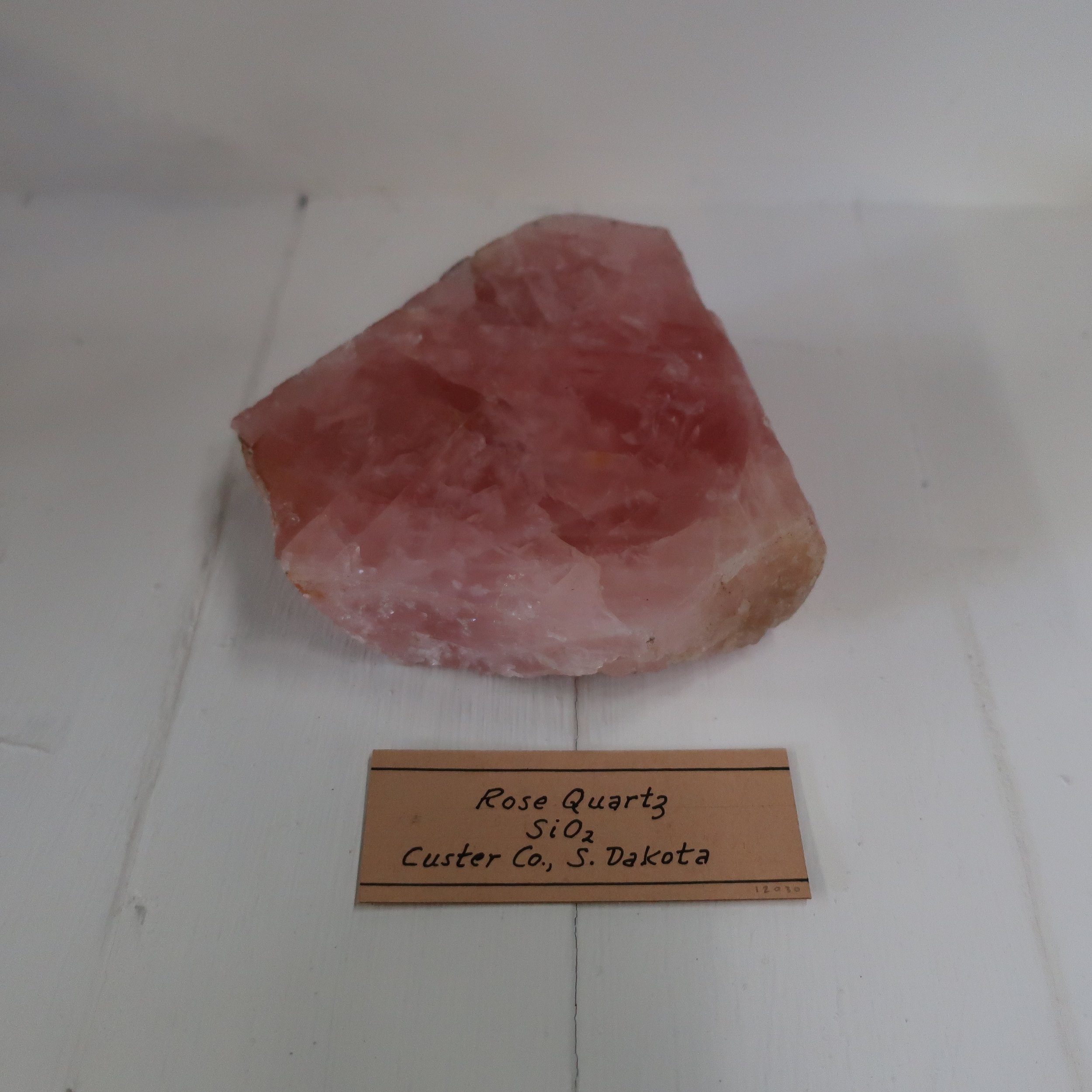
“Rose Quartz is supposed to derive its colour from a minute admixture with manganeese, and is found in Bavaria and the United States. The best are brought from India, Siberia, Ceylon, and Persia. The finest I ever saw are from North Carolina and Cape Plumedon at the head of Bay of Fundy.”
![“Ferruginous Quartz is opaque of several shades of yellow and red, occurs massive and crystalized. It consists chiefly of Silica and 5% of Iron.” [READ THE FULL QUARTZ ENTRY]](https://images.squarespace-cdn.com/content/v1/5b69b9bd4611a043ec05da32/1541014730446-A6XMD3XD8NM1ZR9CMO64/Ferruginous+Quartz.jpg)
“Ferruginous Quartz is opaque of several shades of yellow and red, occurs massive and crystalized. It consists chiefly of Silica and 5% of Iron.”
![“Milk Quartz occurs massive, and is only distinguished by its colour. As its name denotes, it presents a milky aspect.” [READ THE FULL QUARTZ ENTRY]](https://images.squarespace-cdn.com/content/v1/5b69b9bd4611a043ec05da32/1541014734857-BZHVWUHJTTCR7WH3K03S/Milk+Quartz.jpg)
“Milk Quartz occurs massive, and is only distinguished by its colour. As its name denotes, it presents a milky aspect.”
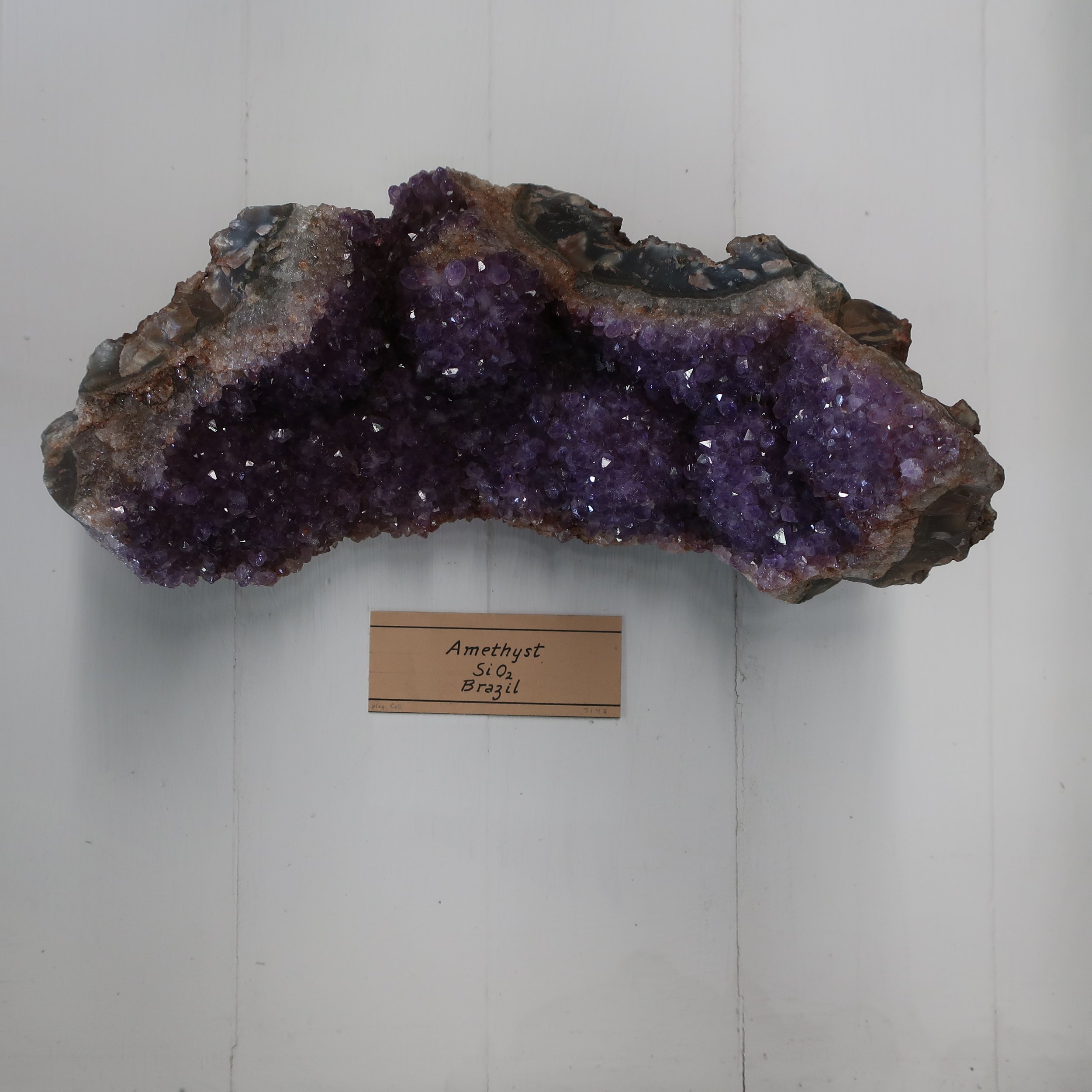
“Amethyst yields 97.50% Silica with a trace of oxide of Iron, Alumina & manganeese. Amethyst chiefly differs from Common Quartz in its colour, which is purplish violet, supposed to be derived from a minute proportion of Iron and Manganeese which it contains. It becomes white by a long exposure to heat.”
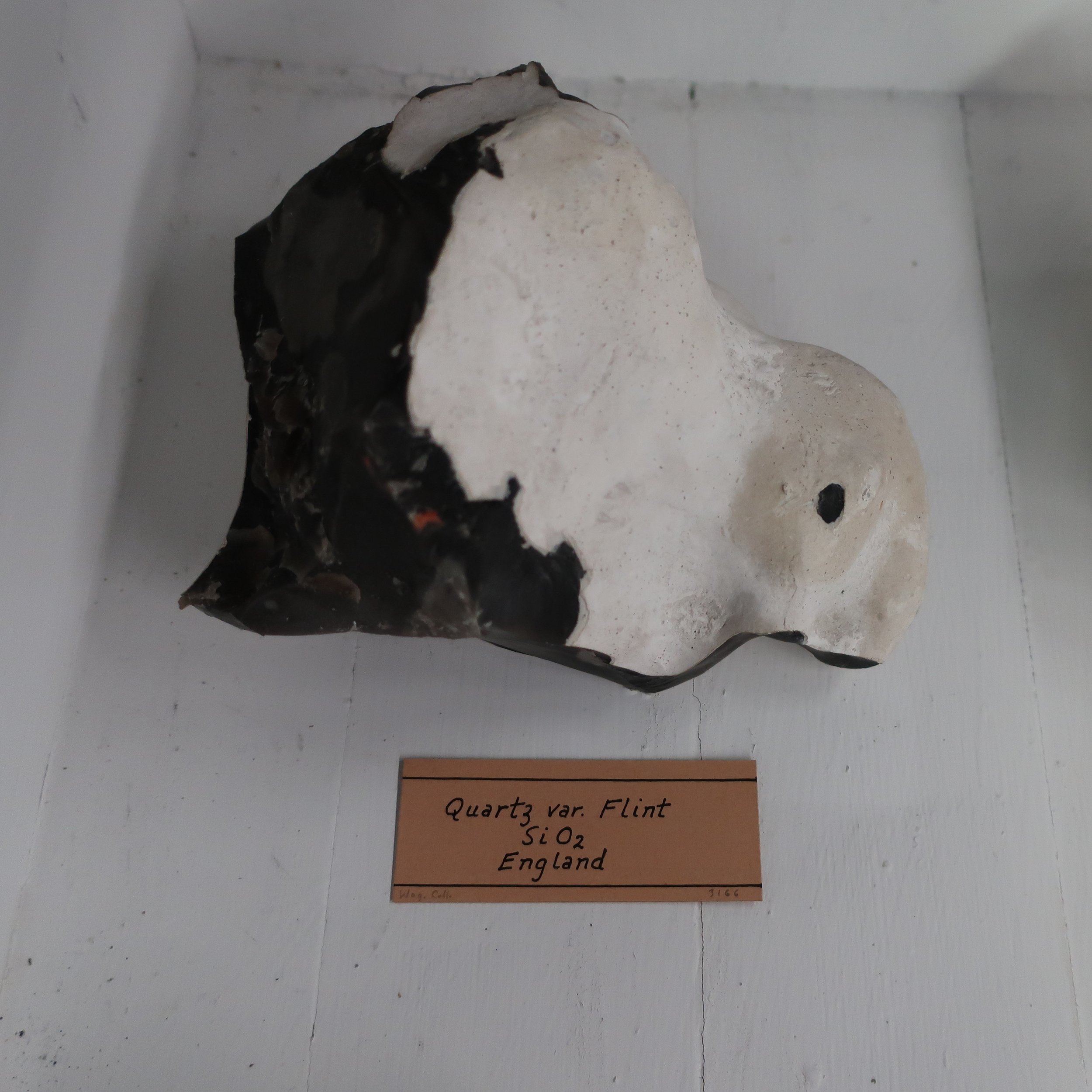
“Flint consists of about 98% of Silica, with minute portions of oxide of Iron, lime, alumina, and Water. Specific Gravity: 2.59. It is of various shades, grey & black. It is rather harder than common Quartz, which it scratches. It can be broken with nearly equeal ease in all directions, is brittle when first taken from its native bed, and becomes harder by exposure. Thin fragments of black varieties are very translucent and sharp. It is infusible, American Indians seem to have understood and had the facility of breaking this substance in different forms, as is evidenced by the variety of arrow and spear heads which are constantly found. In the chalk formation it occurs in regular beds, and consists of nodules or flat masses in England, France, etc. It is often found enclosing sponges, Alceyonia Echinii, and other fossils.”
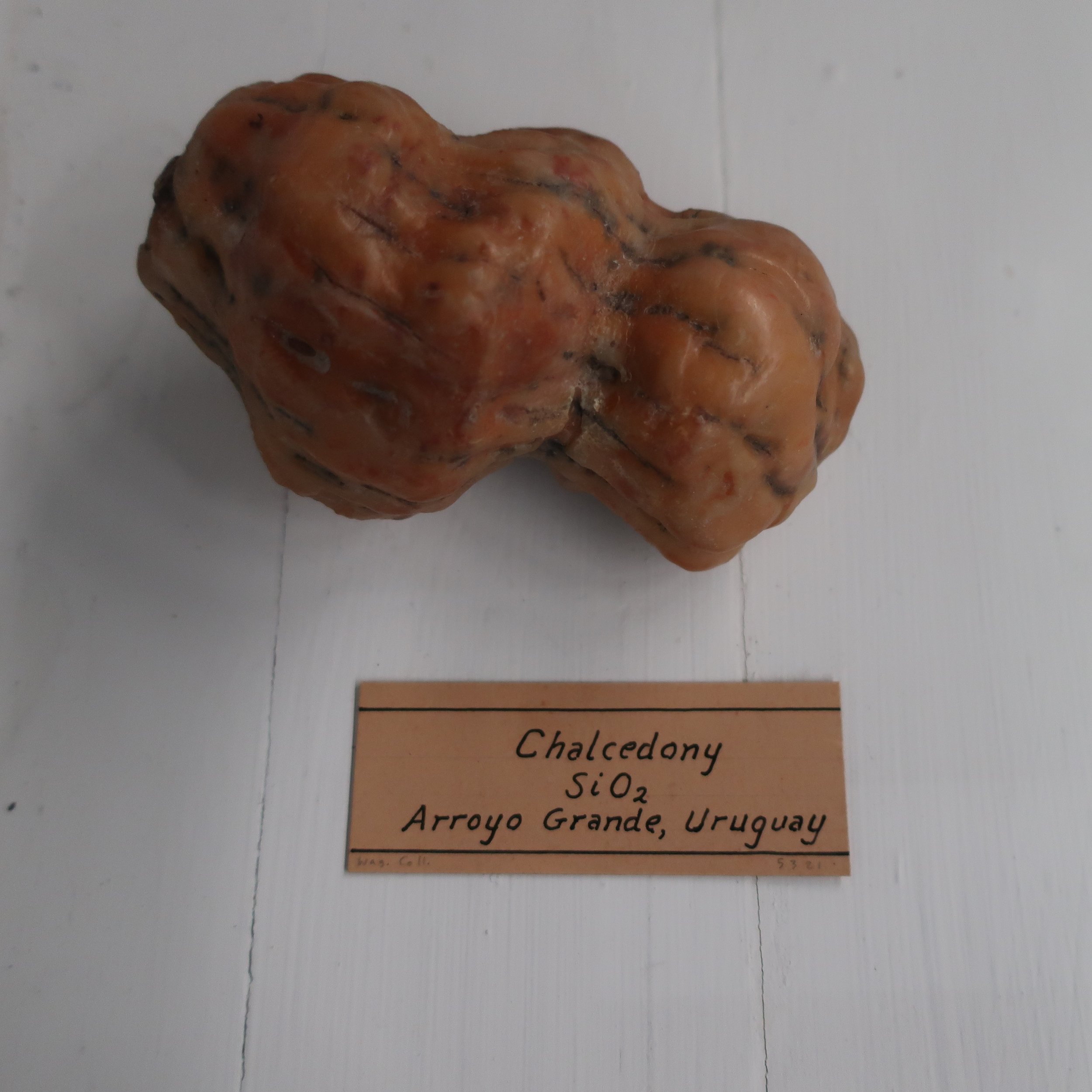
“Chalcedony receives its name from the town of Cacedon in Asia, where it was collected by the ancients. It presents various shades of white, grey, yellow, & blue. It occurs massive, in veins, in nodules, botroidal & stalactetic, but never crystallized, it is semi transparent, the fracture conchoidal. It is harder than flint, and is infusible. It consists of Silica 84, Alumina 16, & Gravity 2.6. Splendid specimens of this mineral at one time [were] found in Cornwall, the best known at this time are at the Ferroe Islands & Iceland.”
![“Chrysoprase is [a variety of chalcedony] of an apple green colour, translucent & massive. It loses its colour before the B.P. and infusable without addition, it contains of silica 96.16, nickle 1, Lime, alumine & Iron 3. It is the nickle](https://images.squarespace-cdn.com/content/v1/5b69b9bd4611a043ec05da32/1541016570735-0O931QQN392D90397AZ8/Chrysoprase.jpg)
“Chrysoprase is [a variety of chalcedony] of an apple green colour, translucent & massive. It loses its colour before the B.P. and infusable without addition, it contains of silica 96.16, nickle 1, Lime, alumine & Iron 3. It is the nickle which gives it the colour. It is much prized by Lapadists, the best is brought from Silesia.”
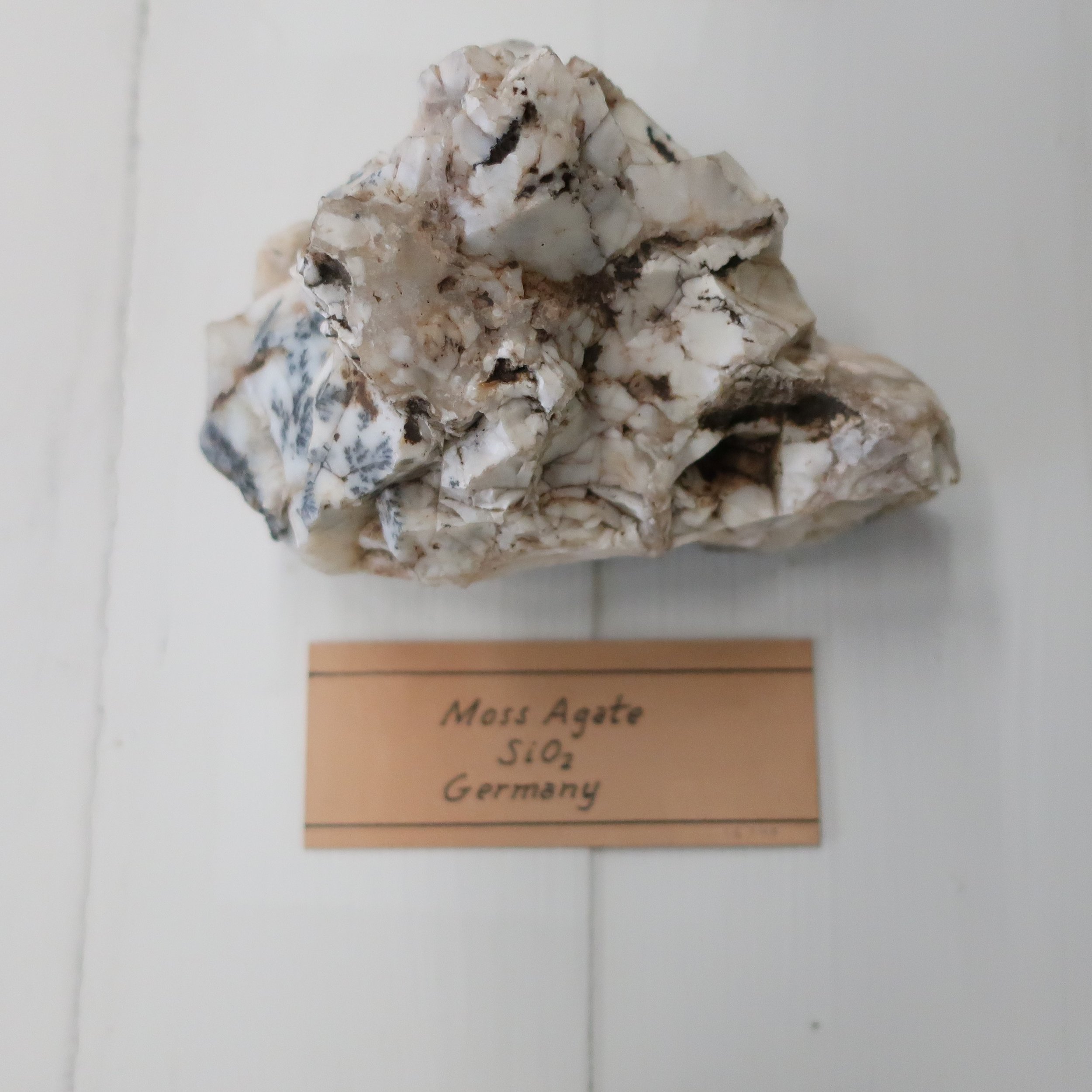
“Agate Moss is chalcedony containing what has formerly been thought to be delicate vegetable ramifications, of different shades as all agates are found in volcanic regeons, or igneous formations, and must have been in a moulten state a great length of time. Everything distructable like vegetable matter, must have been distroyed, hence the only rational conclusion in regard to them must be that these ramifications, are attributable to the presence of metallic fusion. I was much amused at one of the sessions of the Geological Society in London with a long Lecture on the origin of Moss-agates, the Lecturer--whose name I have forgotten--made a most elaborate and microscopic elucidation by many diagrams of numerous specemens. He even names the species of mosses, to which they (as he thought) were referable, entirely losing sight of the igneous formation from whence they were taken, and which alone precludes all possibility of any vegetable remaining unconsumed, and imbeded uninjured, in the body of any substance which had been in fusion for a long period of time.”
![“In a chemical point of view, [ Common Jasper] only differs from agate in containing a larger portion of Iron. It is readily distinguished by its opacity; its prevailing colours are yellow, red, and brown. It has often a resinous lustre, but it is](https://images.squarespace-cdn.com/content/v1/5b69b9bd4611a043ec05da32/1541016953077-NIWQ8Q4O06LZK7Q7OTAC/Jasper.jpg)
“In a chemical point of view, [Common Jasper] only differs from agate in containing a larger portion of Iron. It is readily distinguished by its opacity; its prevailing colours are yellow, red, and brown. It has often a resinous lustre, but it is sometimes dull, fragments are rarely translucent on the edges. It occurs in veins or beds, both in primitive and secondary mountains.”
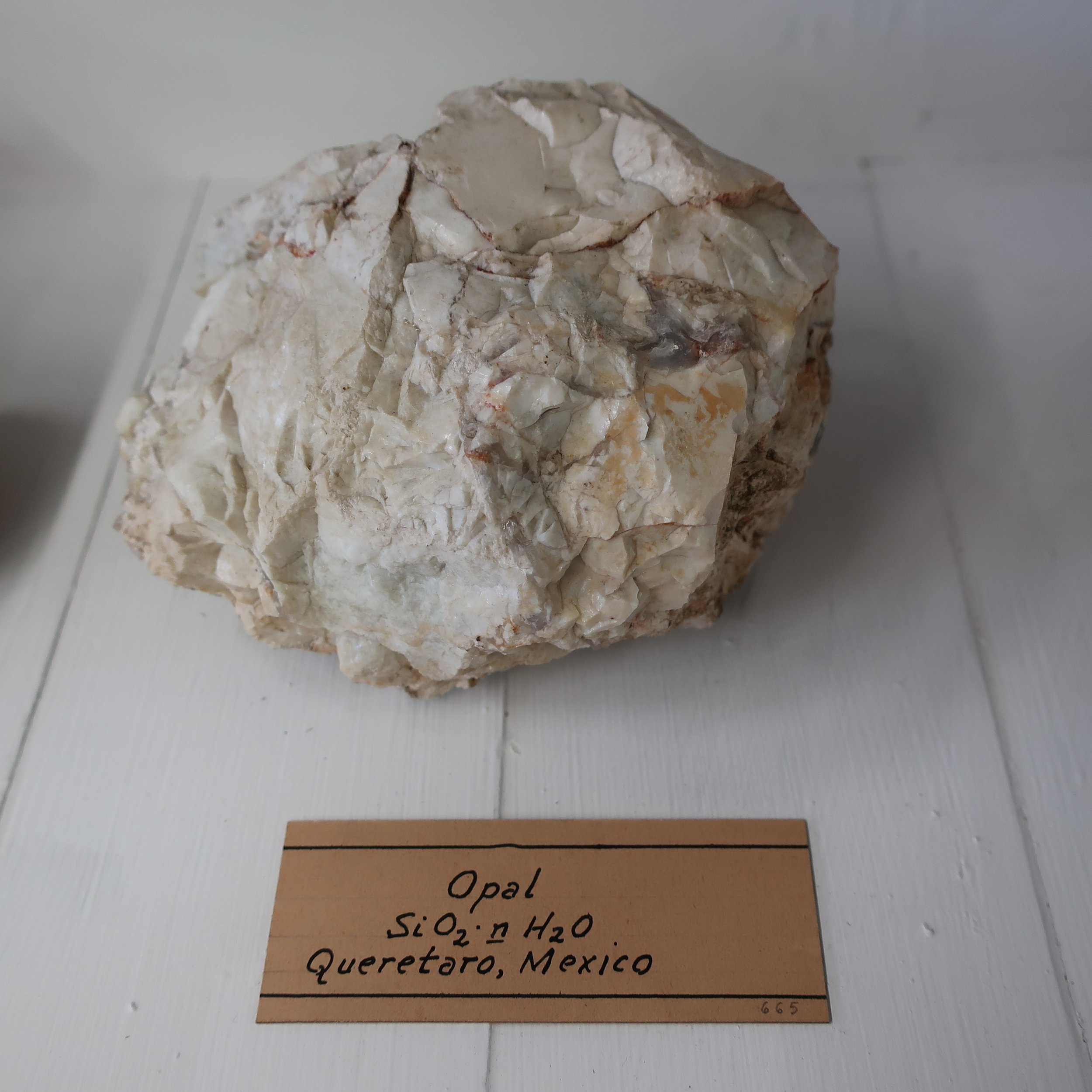
“Opal, like quartz, consists chiefly of Silica and water, but analysis generally indicates a greater quantity of the latter than in quartz, none of its varieties give fire with the steel. Specific G 2.09. This beautiful mineral is of a white bluish and yellowish white colour, and when received by transmitted light is yellow. It exhibits brilliant and changeable reflections of green, blue, yellow, and red. This play of colours has not been satisfactorily accounted for. Sir David Brewster thought it was owing to the refraction and reflection of light in certain openings in the interior of the mass, which are not fissures, but possess a uniform shape, it is translucent, fracture conchoidal and lustre resinous. Easily broken, but scratches glass. Before the blow pipe, it decrepitates and looses its colour. It consists of 90 silica and 10 water. It occurs accompanied with common opal, in porphory, & in the trap rocks of Hungary. The most splendid specemens have been brought from the province of Honduras of considerable size.”
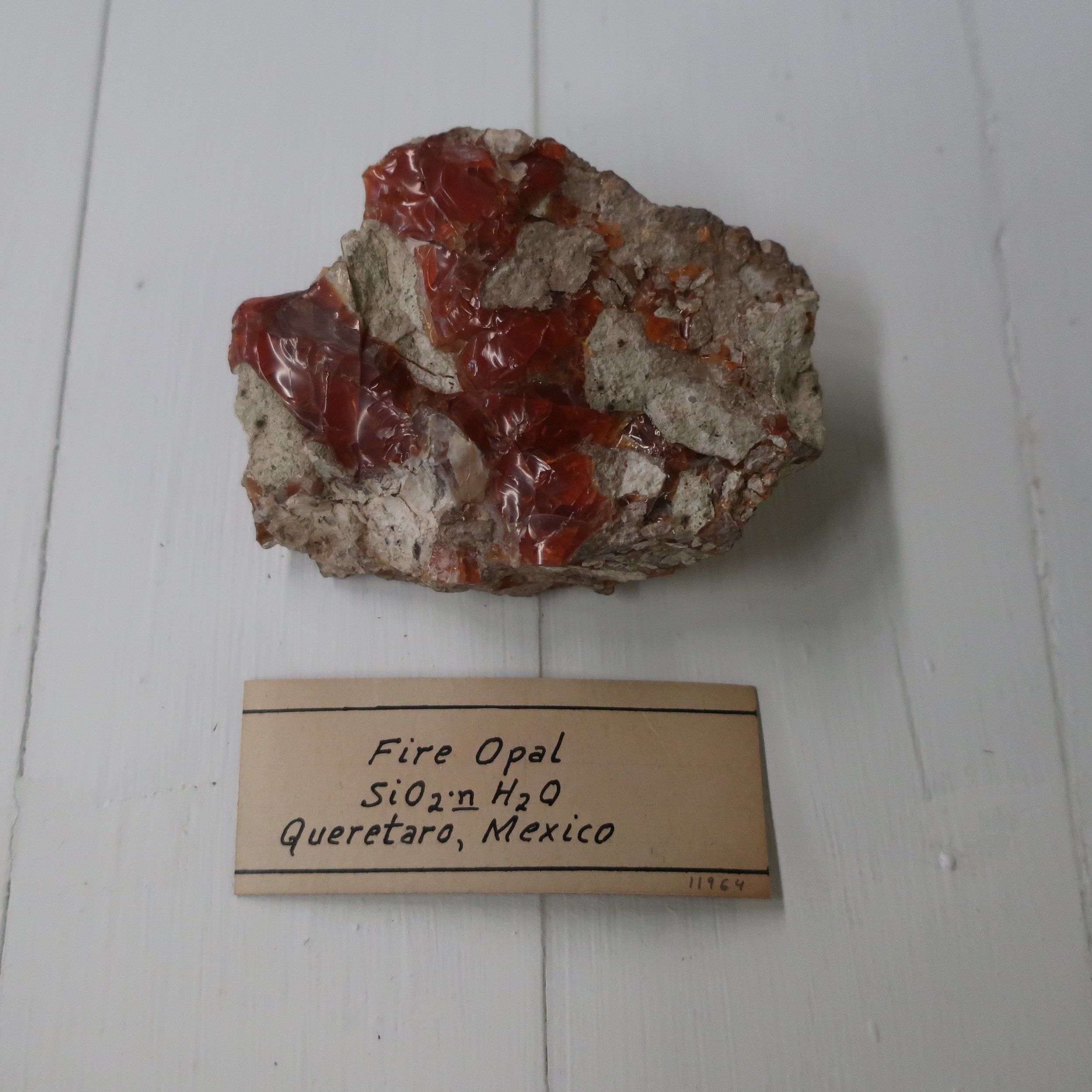
“Fire Opal is found with the noble opal, in Hungary, but is much scarcer. It differs from the precious, in possessing only hyacinth red and yellow tints, when turned towards the light. It occurs in Mexico, and Honduras. Humbold first made known the rich repository of this mineral in Mexico, and one of the most magnificent specemens ever obtained was deposited by him in the Royal Mineralogical Cabinet of Berlin, it occurs in Volcanic countries in trachite.”
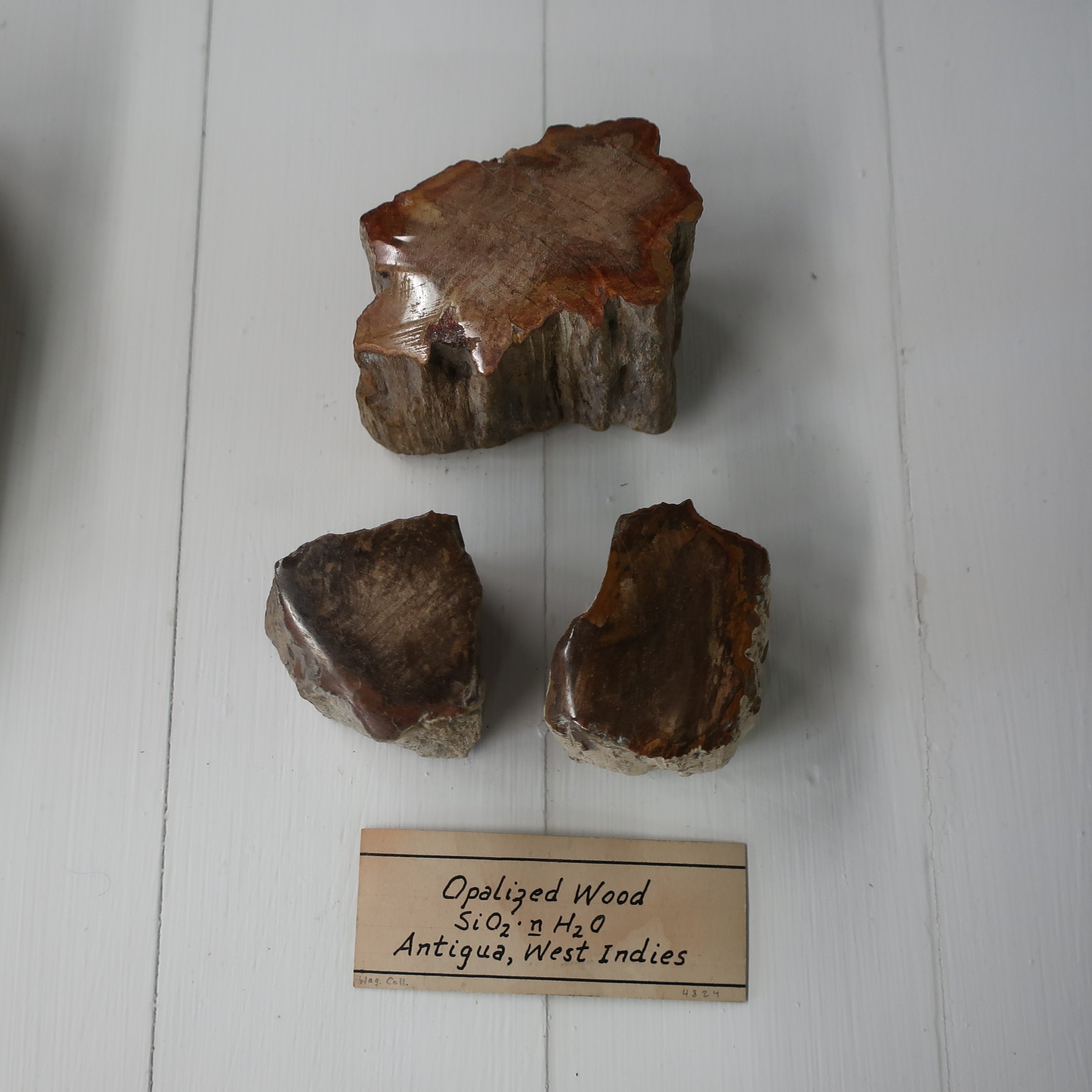
“Wood Opal is remarkable for its ligneous appearance. It presents a variety of grey, brown, and black, and in fracture, translucency, and lustre, does not materially differ from semi-opal, altho’ somewhat harder. It occurs occasionally, forming large trees, in the pumice conglomerates of Hungary.”

“Menelite is a variety of semiopal occuring in compact reniform masses of a brown colour, structure slaty, found in beds of adhesive state at Menil-montant near Paris. It contains 85 silica, 1 alumina, and 11 water.”

“Hyalite occurs in white and transparent boytroidal masses, or in Stalactites. It has a vitrious lustre, is brittle, but is as hard as quartz. Specific gravity about 2.410. Before the blow-pipe it is infusable by itself, consists of Silica 92, water 6. This singular mineral is chiefly found investing or lining the cavities of Trap Rocks, it is found in Bohemia and Frankford on the Maine.”
![“Under this term [Garnet] are included several substances consisting principally of the same elements, but united, in variable proportions as the silicates of Lime, Iron, and Manganeese. Almandine (Precious Garnet) consists of 36 silica, 22 alumi](https://images.squarespace-cdn.com/content/v1/5b69b9bd4611a043ec05da32/1541017475503-8HAZ01W23E4FE747R9B9/Garnet+%28Almandite%29+4.jpg)
“Under this term [Garnet] are included several substances consisting principally of the same elements, but united, in variable proportions as the silicates of Lime, Iron, and Manganeese.
Almandine (Precious Garnet) consists of 36 silica, 22 alumina, protoxide of Iron 37, Lime 3. The principal colour of this beautiful mineral is red of various shades having sometimes a tinge of yellow, or blue, it is commonly translucent often transparent, it occurs crystalized in the rhombic dodecahedron, and may sometimes be cleared, though not without difficulty, parallel to the planes of that solid, it is insoluable in acid, B.B. &. Se. it fuses into a black globule. It is much esteemed as a precious stone. The finest are brought from Ceylon and Pegu, where they occur in alluvial deposits. Bohemia produces many. It is believed to be the common Carbuncle of the ancients, tho’ they also applied this term to the ruby, as well as to other gems.”
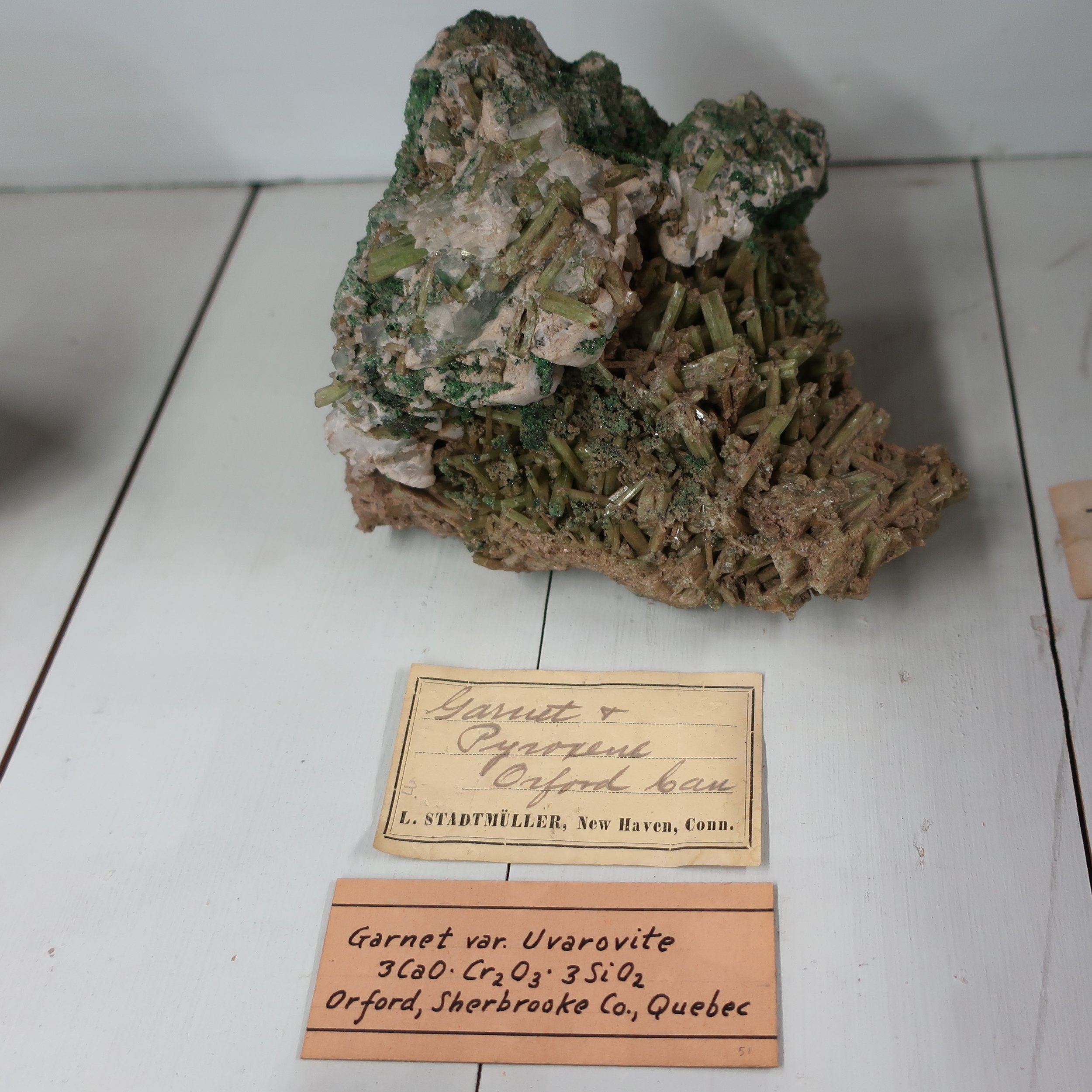
“Uvarovite (Chrome Garnet) is a rare variety of Garnet, made known by one of the industrious mineralogists of Russia, and which should be classed with Green Garnet, to which it bears a very strong resemblance. It has a lively Green colour, and crystallizes in perfect Rhombic dodecahedrons. The green is derived from the chrome. It has not been analysed.”
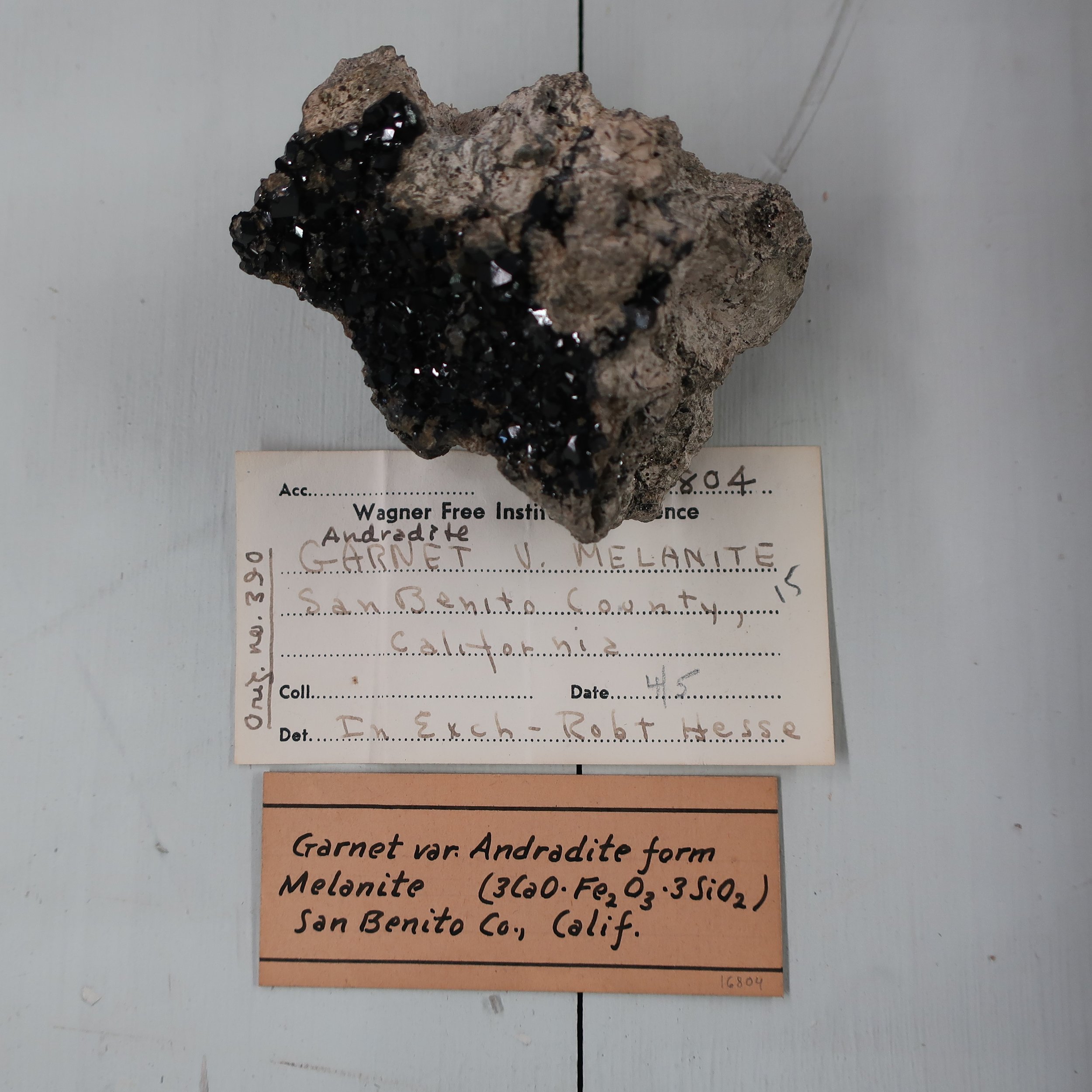
“Melanite is generally quite black, a beautiful black Garnet has been found at Franklin N Jersey exactly resembling that from Norway. It occurs in rhombic dodecahedrons, BB it fuses alone, into a brilliant black globule.”
![“Pyrope differs from other varieties [of Garnet], in containing 7.68 &ct of chromic acid. And by part of its Iron, replaced, by Magnesia. It is found only in rounded, or angular grains, of red colour, it is transparent, and scratches glass. It](https://images.squarespace-cdn.com/content/v1/5b69b9bd4611a043ec05da32/1541018293588-AL8ZGVNJCZRCDVXF7CDG/Garnet+%28Pyrope+-+Rhodolite%29.jpg)
“Pyrope differs from other varieties [of Garnet], in containing 7.68 &ct of chromic acid. And by part of its Iron, replaced, by Magnesia. It is found only in rounded, or angular grains, of red colour, it is transparent, and scratches glass. It is found imbeded in serpentine in Saxony & in Bohemia. This variety is rare in the United States.”
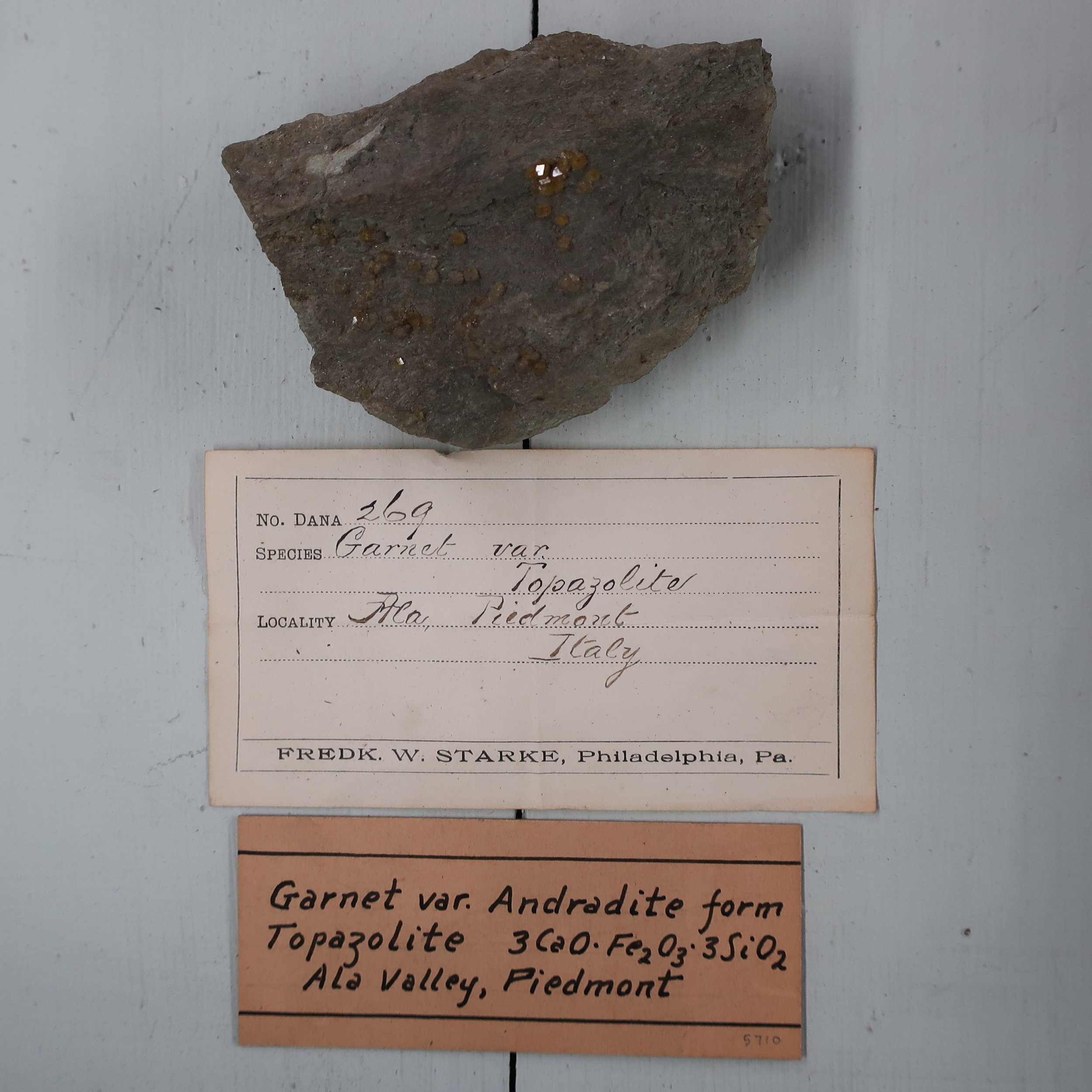
“Topazolite variety of Garnet occurs in well-defined dodecahedrons of a topaz yellow colour. It consists of Silica 35, magnesia 2, Lime 29, Glucina 4, Iron 25, Manganese 2.”
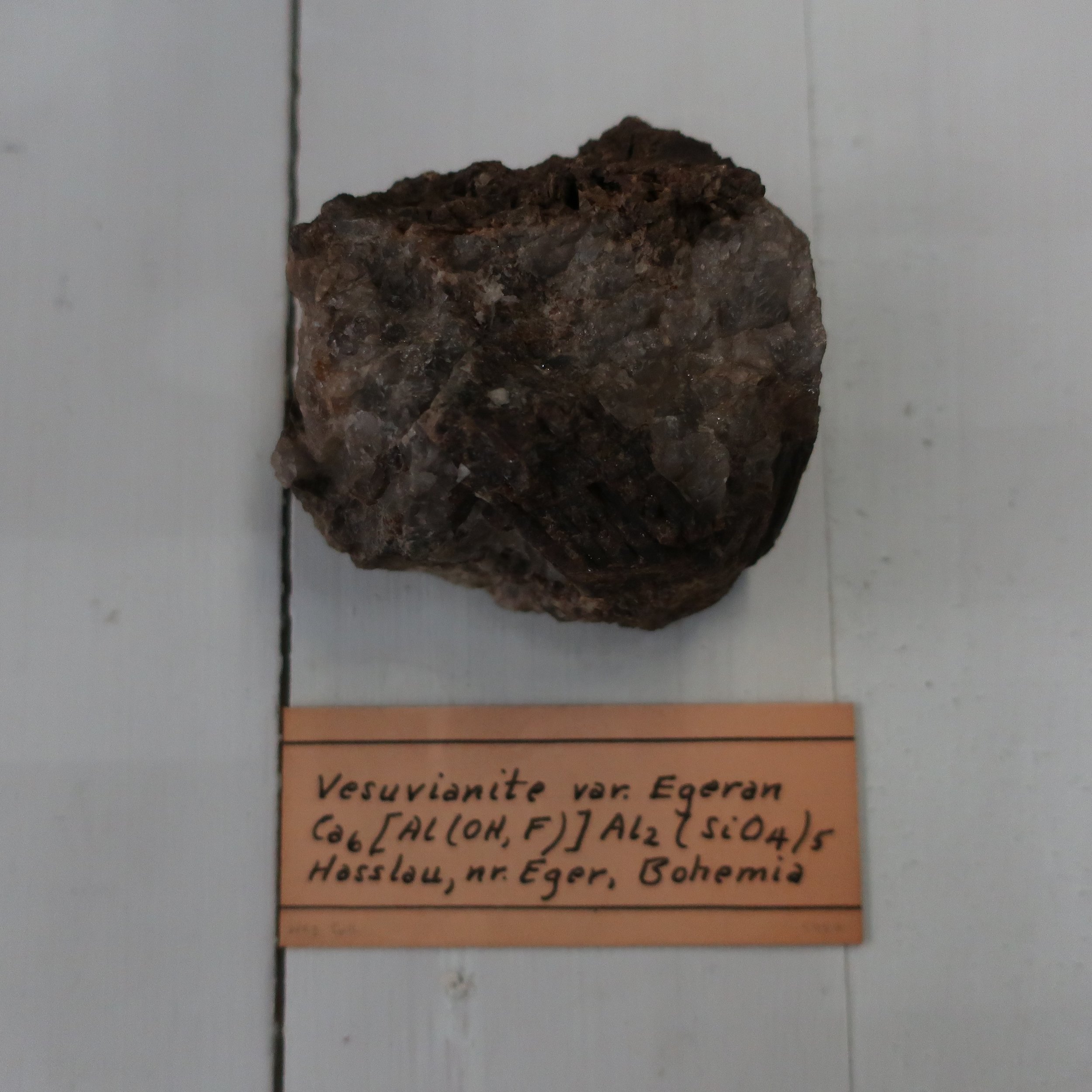
“Egeran occurs in diverging groups of translucent crystals, of a liver brown colour. B.B. it inturmesces. It occurs at Haslan near Eger in Bohemia, hence the name Egeran.”
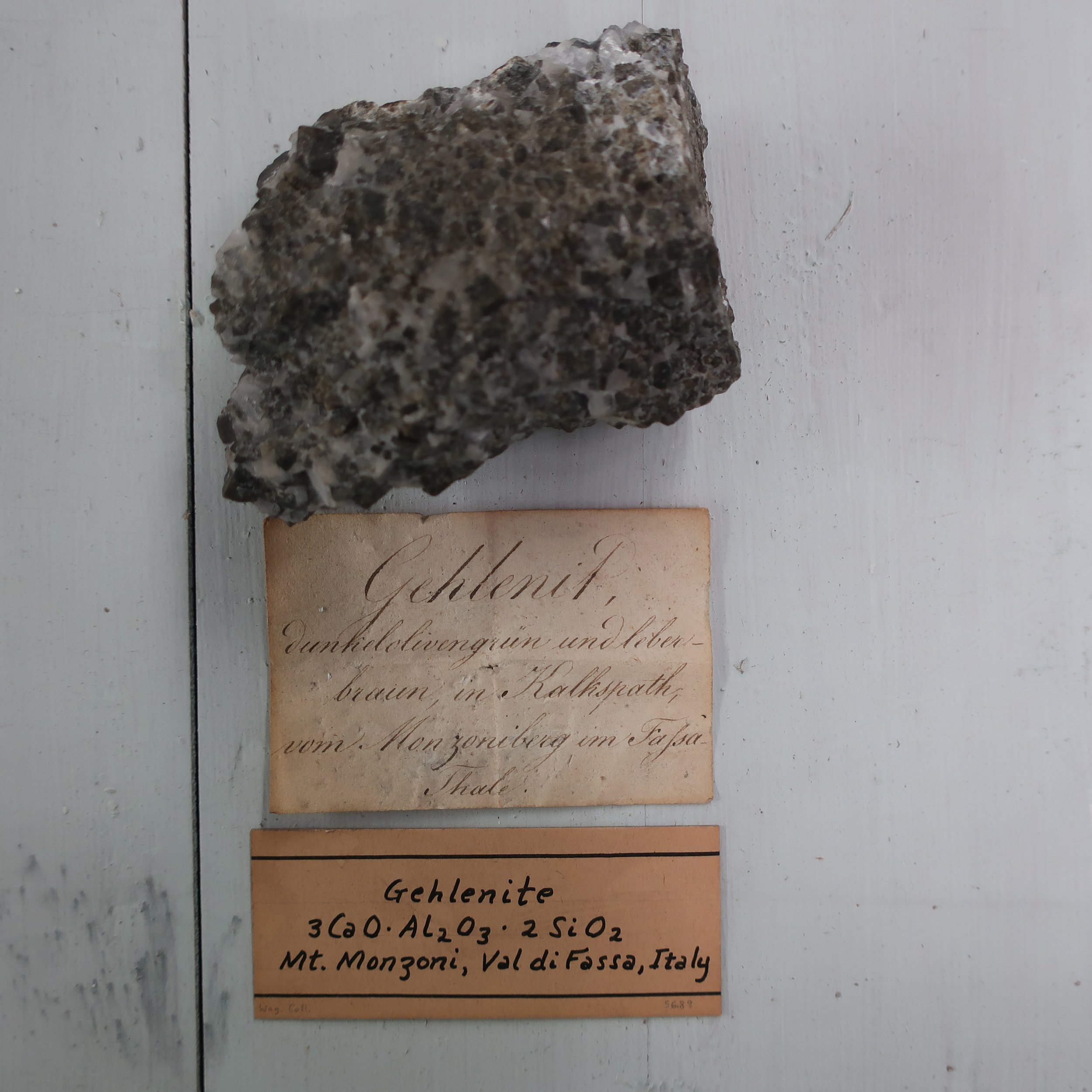
Gehlenite is a combination of Silica 29, Alumina 24, Lime 35, Iron 6. It occurs in right square prisms and massive. It is usually grey, but frequently, has a greenish or yellowish tinge. Surface commonly rough and dull, it is found in the valley of Fassa, Tyrol.
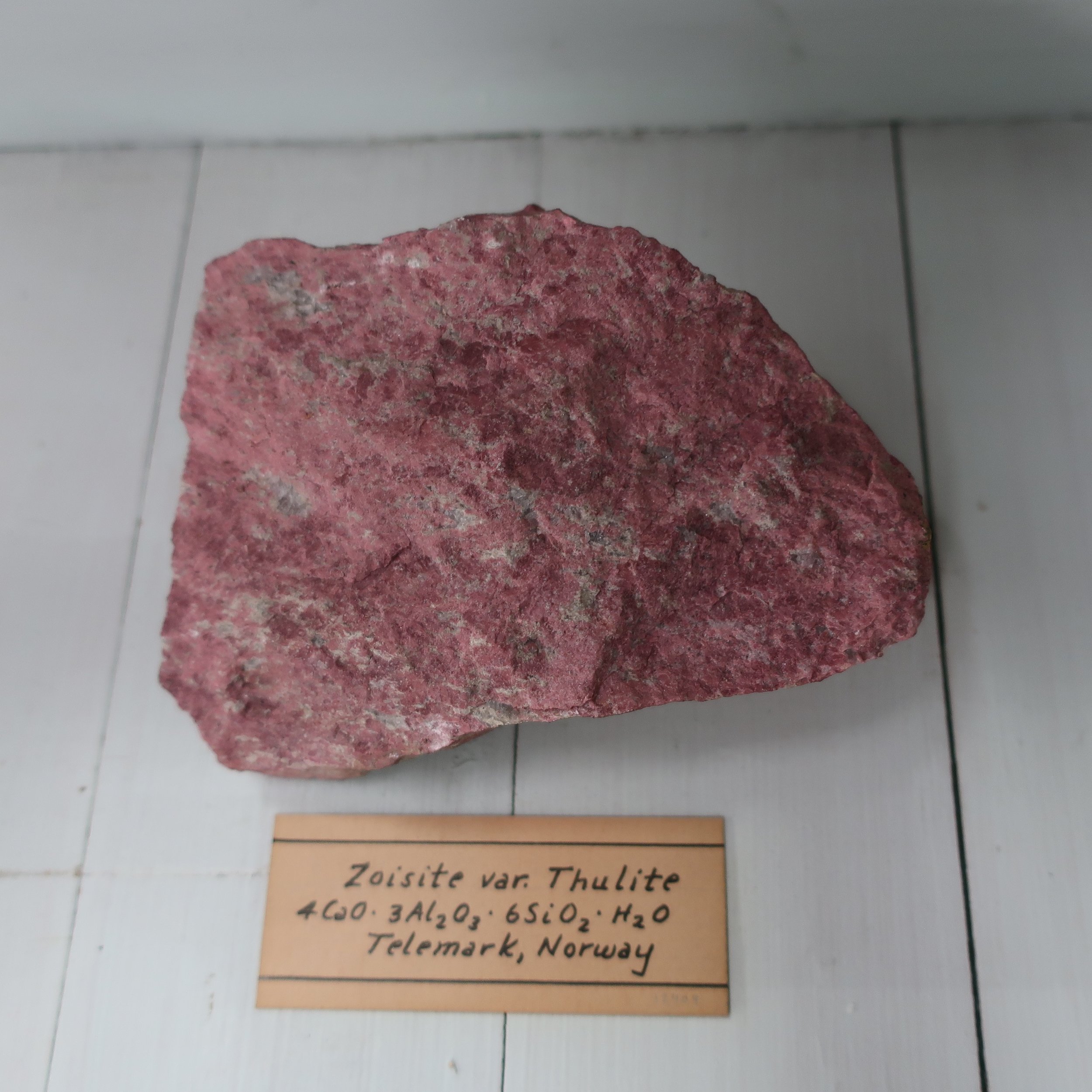
“Zoisite is composed of Silica 45. Alumina 29. Lime 21. Iron 3. Sp. Gr. 3.2. It occurs in oblique rhombic prisms, of a grey, greyish, yellow, or brown colour, but are rarely perfect, owing to deep longitudinal stria, the terminations are often incomplete. It also occurs massive, it is met with, in Styria, & Bavaria also at several places in our own country. This species is by Mohs, and others, united with epedote from which it principally differs in colour.”
![The combination of [ Epedote] is Silica 37. Alumina 27. Lime 14 Iron 17. Sp Gr 3.42. This mineral is found granular, massive. and in prismatic crystals, variously terminated and longitudinally striated. Colour different shades of green, occasionall](https://images.squarespace-cdn.com/content/v1/5b69b9bd4611a043ec05da32/1541621853077-EV6KXKIY41UICJ9NXFN0/Epidote+3.jpg)
The combination of [Epedote] is Silica 37. Alumina 27. Lime 14 Iron 17. Sp Gr 3.42. This mineral is found granular, massive. and in prismatic crystals, variously terminated and longitudinally striated. Colour different shades of green, occasionally almost black: it has a shineing lustre. Epidote is not often found massive, but chiefly in crystals varying from acicular to an inch in diameter and several inches in length. Fine crystals occur, at Arendal in Norway, and Normark in Sweden. The magnificent crystals from these localities consist of consecutive coats, the exterior of which, admit of removal and thus out of a large imperfect crystal, one of smaller size but more completely formed may be produced with facility. It belongs principally to primitive rocks but is only found in veins and fissures, among which, in small quantities it occurs in many countries. It is found in several parts of the U States. Huge crystals occur at Lebenon N. Haup.
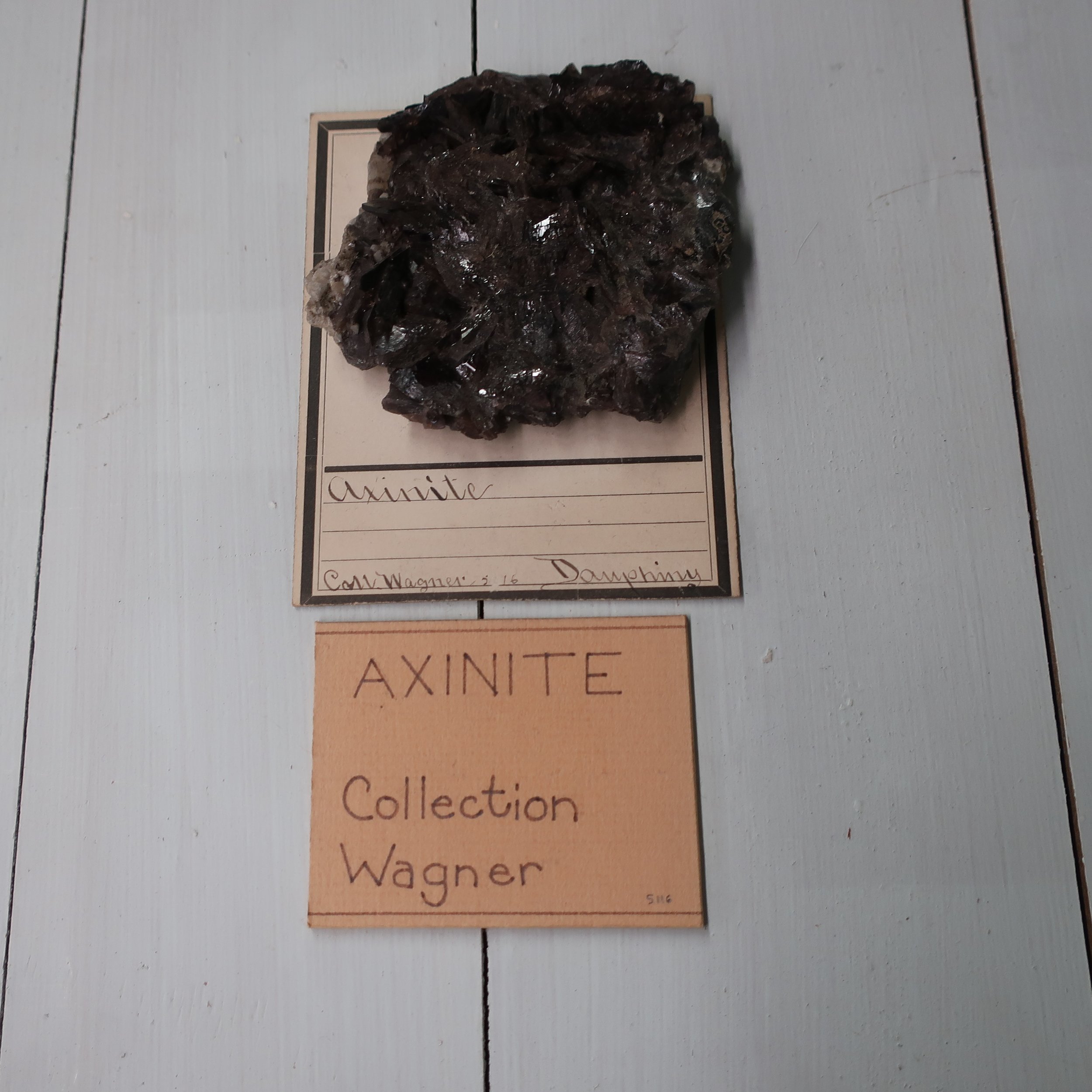
“Axinite contains Silica 50, Alumina 16, Lime 17, Iron 9 Manganeese 5. Sp. Gr. 3.27. This mineral rarely occurs massive, more frequently in flat, oblique rhomboidal prisms, whose edges are remarkable sharp. Common colour violet, or clove brown, also yellow, and green, from an admixture of Chlorite. Externally the crystals are remarkably brilliant becomes electric by exposure to heat. BB it fuses readily into a green glass. It is not acted on by acid. It occurs in Saxony, and the Pyrenees, the finest crystals are found in Dauphiné in France, but one locality has been found in the U States, at Phippsburg Maine.”
![Chlorophillite differs from [Diachoite] in hardness, Sp. Gr. and other physical properties, besides being a hydrated mineral. It has lately been found in the U.S. at Unity, New Hampshire, very plentifully crystallized. It consists of Silica 45, Al](https://images.squarespace-cdn.com/content/v1/5b69b9bd4611a043ec05da32/1541622961691-RTI14J2D2CGRF3LKXL4D/Chlorophyllite.jpg)
Chlorophillite differs from [Diachoite] in hardness, Sp. Gr. and other physical properties, besides being a hydrated mineral. It has lately been found in the U.S. at Unity, New Hampshire, very plentifully crystallized. It consists of Silica 45, Alumina 30, Magnesia 9, Iron 5, Water 10. Sp Gr 2.07. Colour green, greenish brown, or dark olive brown. It occurs crystallized in six sided prisms. The specemens from Unity have the appearance of large foliated masses, they are divisible, the natural joints being filled by a magnesian mica, and imparts to them a talcy lustre. BB it is infusible alone.
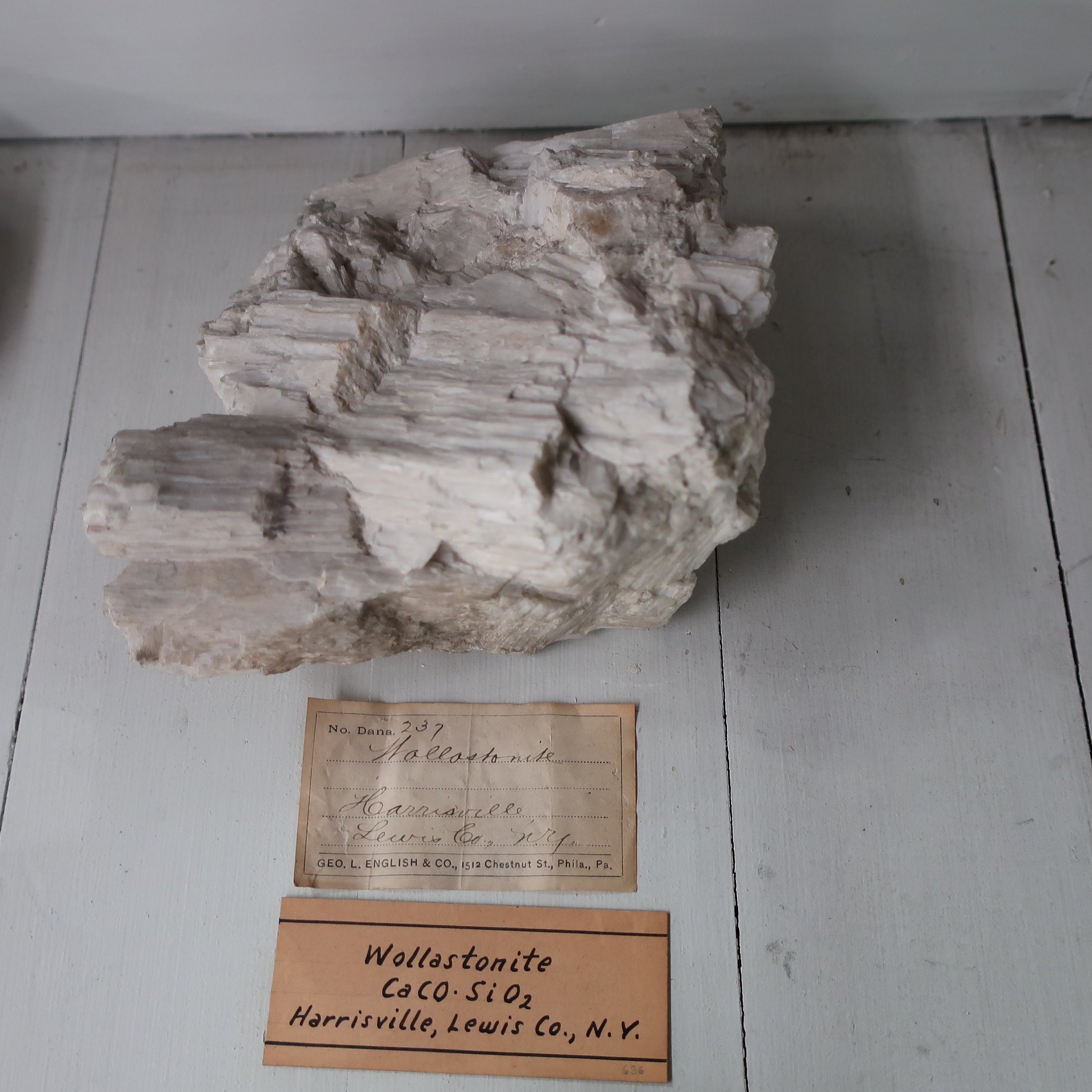
“Dr. Thompson has seperated this from Tabular Spar by the name Wollastonite. It nearly resembles it in some of her characters, but which has a different composition being composed of Silica 53. Lime 31. Soda 9. Magnesia 1. And water 2. It thus seems to belong to the Alkalino=earthy class, of the present arrangement, but as the name of Wollastonite in honor of one, to whom mineralogy is under very great obligations, has now become fixed in its application to table spar or bisilicate of Lime. Its colour is white, with slight shade of green, texture is fibrous, the fibres in tufts diverging from a centre, lustre inclining to silky, Sp. Gr. 2.85. It occurs in considerable quantities in a greenstone rock, near the Clyde canal Scotland.”
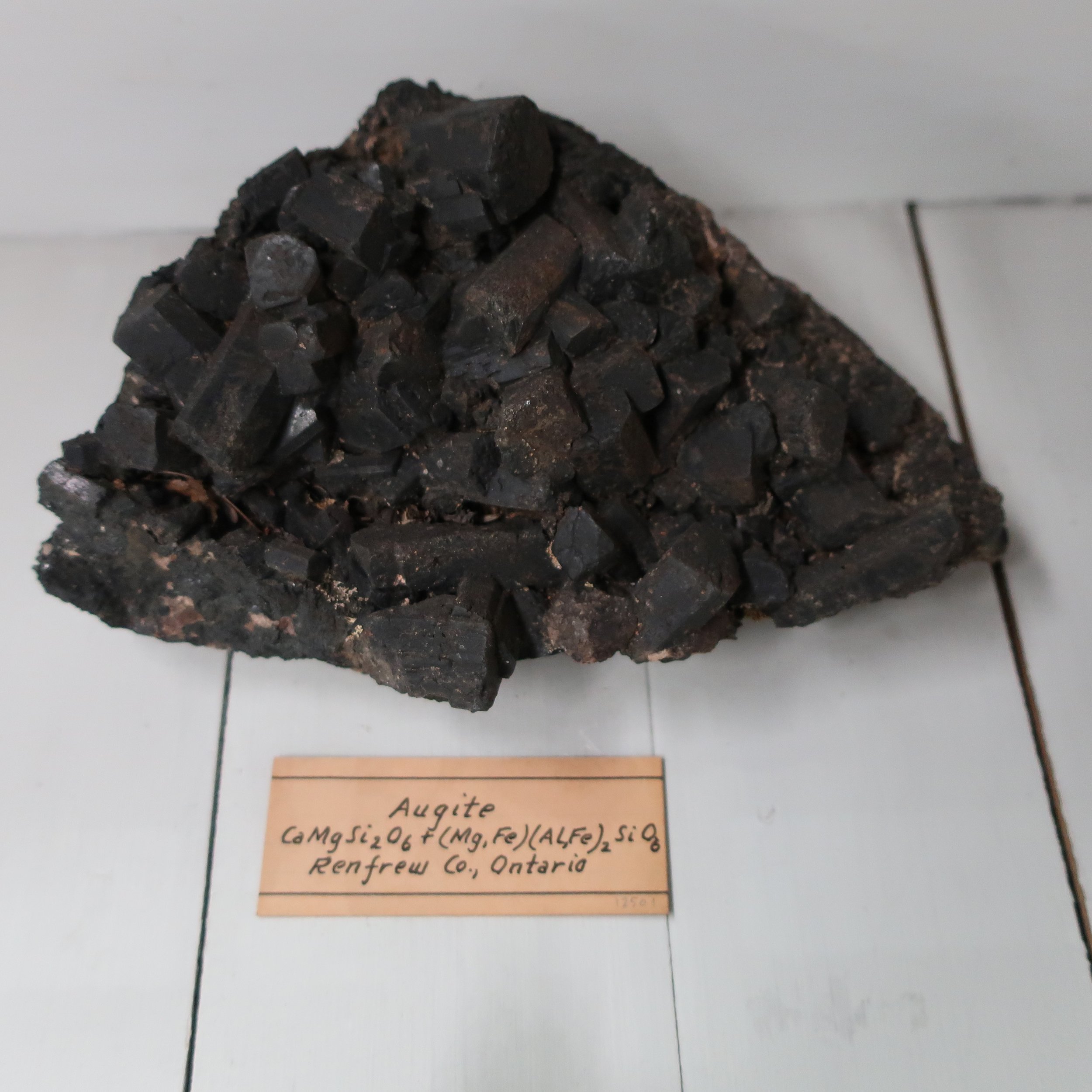
“Augite is from the Greek meaning splendour, in allusion to the brilliancy of its crystals. It contains Silica 53. Lime 22. Iron 17. Magnesia 5. It is therefore a bisilicate of Lime, magnesia & Iron. Dr Thompson has seperated the white from the dark varieties, and discribed it as a distinct species, but as all the characters are common to both, it does not seem absolutely necessary that we should maintain the distinction. Augite occurs crystallized, also in grains, and amorphous, Its colour is white, green brown & sometimes black, with a vitrious or resinous lustre, and opake. Several varieties of Augite have been obtained artificially, by means of fusion. All varieties of this mineral seem to owe their peculiarities to the Isomorpous nature of Iron, and some of the other substances that enter into its composition, and replace each other without producing any change, in the crystaline form of the species. Augite is a common volcanic production. The debris of Monté Rossi on Aetna, I found large quantities of crystals of Augite. In the volcanic regeons of Vesuvius Stromboli and Bourbon, I found the same thing, it is said to occur in the same way in Avergne, and Tenneriffe. The crystals found in basalt, are generally larger than those found in lava, Remarkably beautiful crystals of augite have been found at Bytown upper Canada, the crystals sometimes an inch in diamiter, and 2 inches long are disseminated through calcarious Spar.”
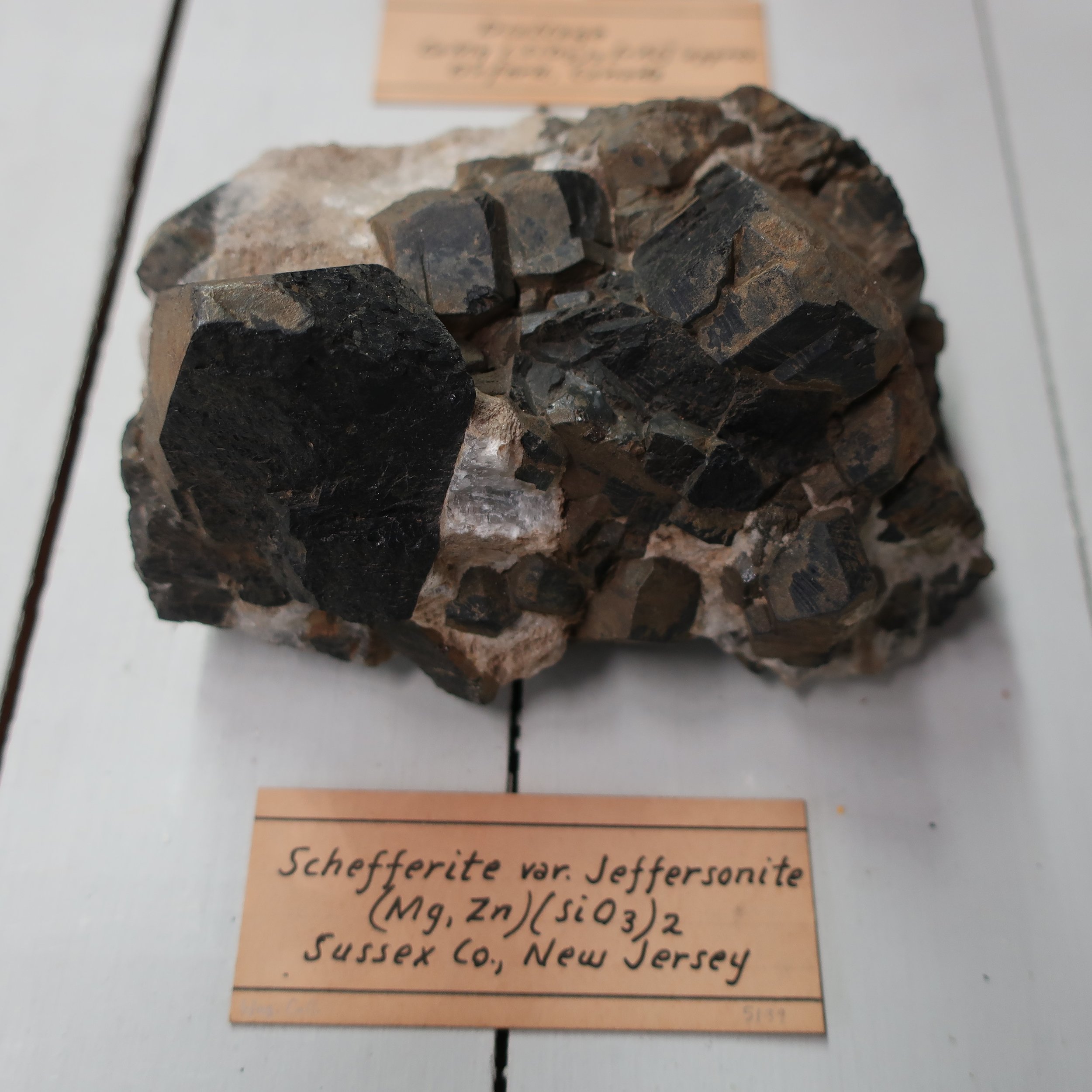
“Jeffersonite was discovered by Msrs Keating, and Vanuxem of Phil”a from its chemical composition and other characters, they came to the conclusion it was a new species. Dr. Troost instituted a careful comparison between this mineral, and pyroxene, as to its crystaline forms, and has shewn, that its crystals, correspond precisely with the latter, and it is now classed as a variety of Pyroxene, in the systems. It contains Silica 56. Lime 15. Manganeese 13. Iron 10. Sp. Gr. 3.5. It is found in large foliated masses, sometimes a foot in length, and in groups of large, and well defined crystals, from 2 to 6 in. in diameter, usually of a dark olive green colour, passing to brown. It occurs with Franklinite & Garnet at Franklin Sussex Coy N Jersey.”
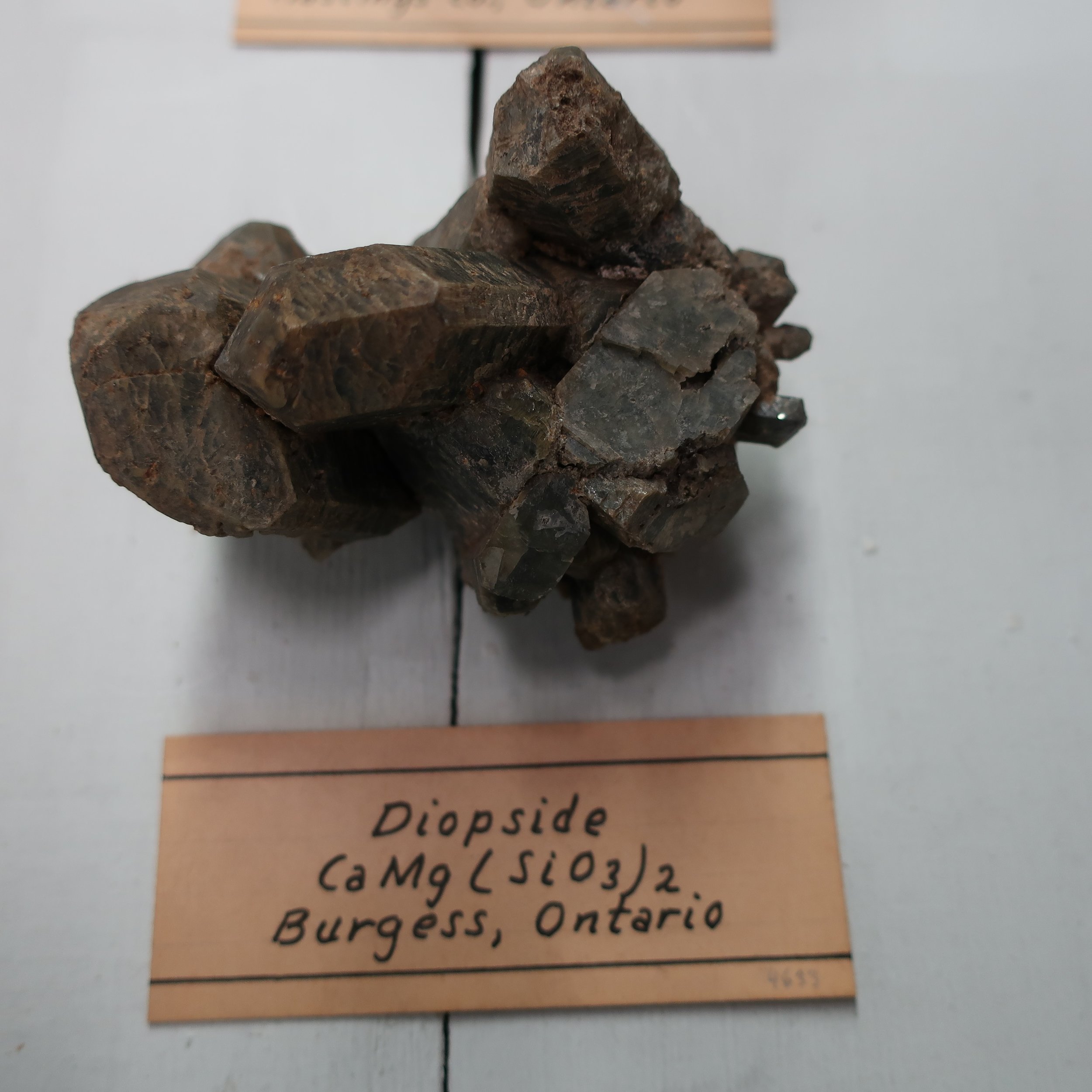
“Diopside occurs in prismatic crystals, which are colourless or various shades of green, the primary is an oblique rhombic prism of the same form, and measurement, as that of augite. It is found traversing veins of Serpentine in Piedmont, latterly it has been found in Tyrol, in large crystalline masses. In the U.S., fine crystals have been in the limestone quarries of Bolton, Mass.”
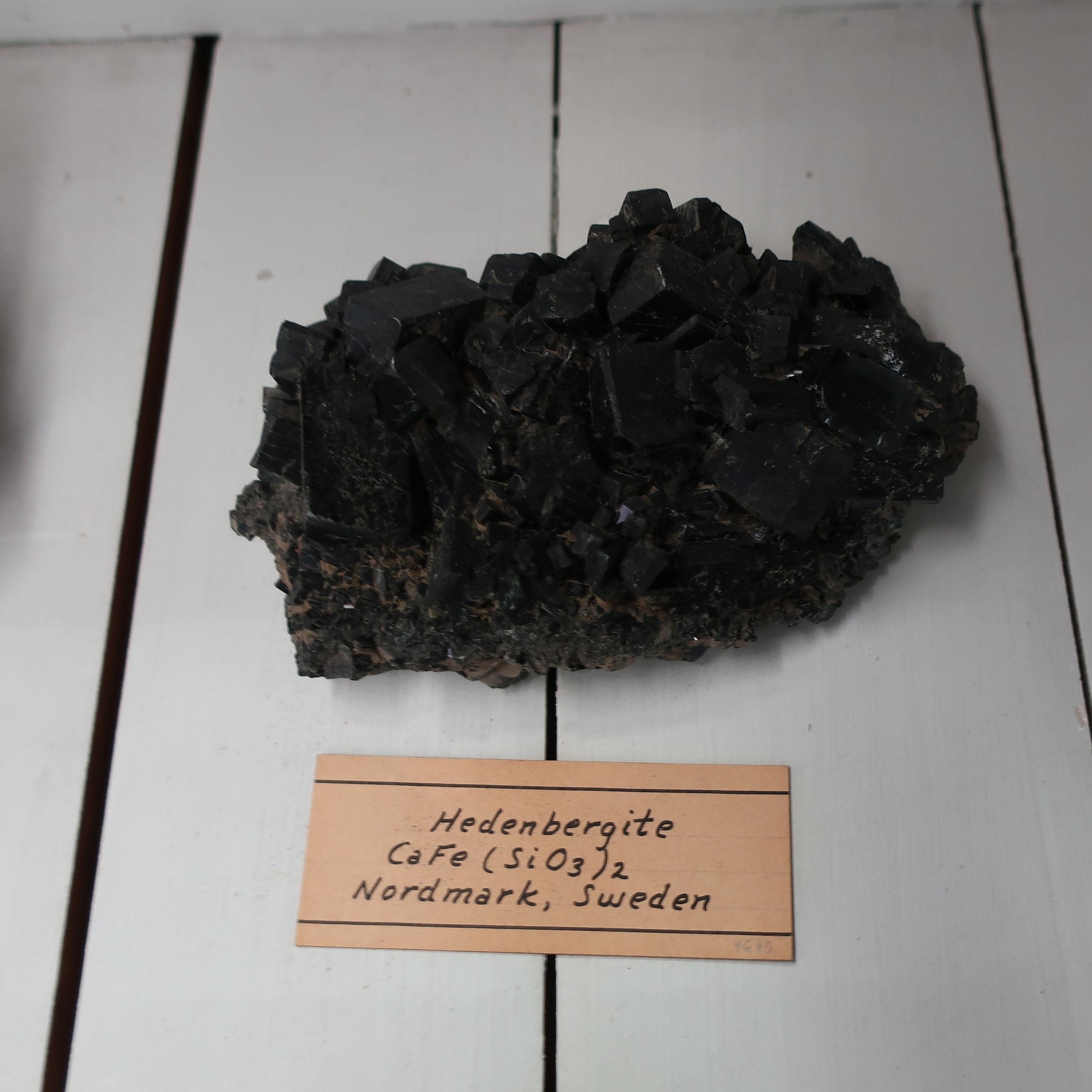
“Hedenbergite is a variety of cocolite from Zuneburg in Sweeden, its chemical contents vary but little from the former species. it is named in honor of the Chemist Hedenburg, the French Mineralogist Beudant places several varieties under that name.”
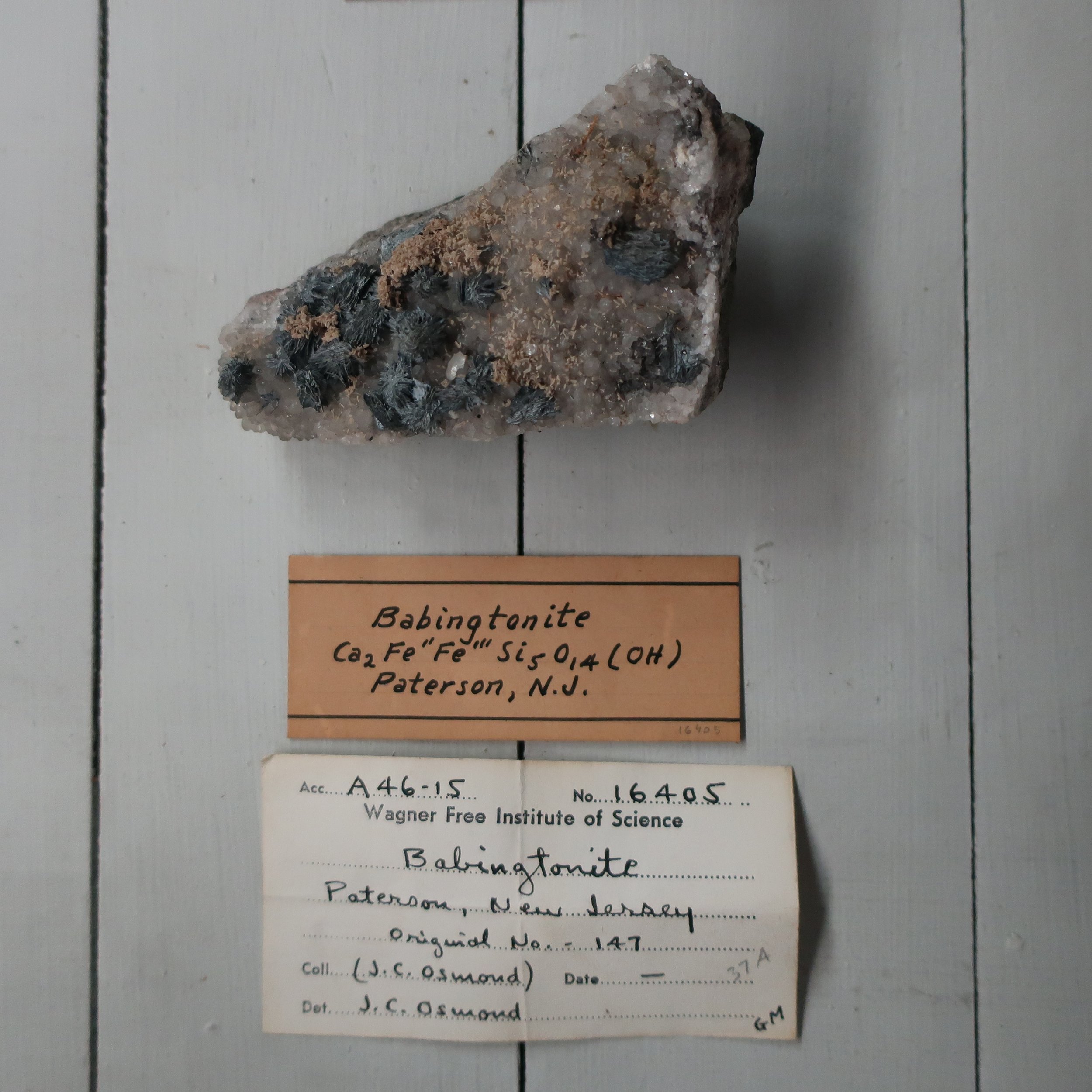
“Babingtonite is another variety of Augite, the lustre is vitrious, surface brilliant, B.B. it fuses into a black enamel. It resembles some of the dark varieties of augite from which it was first distinguished by Levy. It is composed of Silica Iron manganeese and lime with a trace of titanium. But it would seem, that no one has had sufficient of this mineral for a thorough analysis, it occurs in very distinct crystals at Arendal in Norway, with epedote and Garnet. The only locality in the U.S. is at Charleston, Mass.”
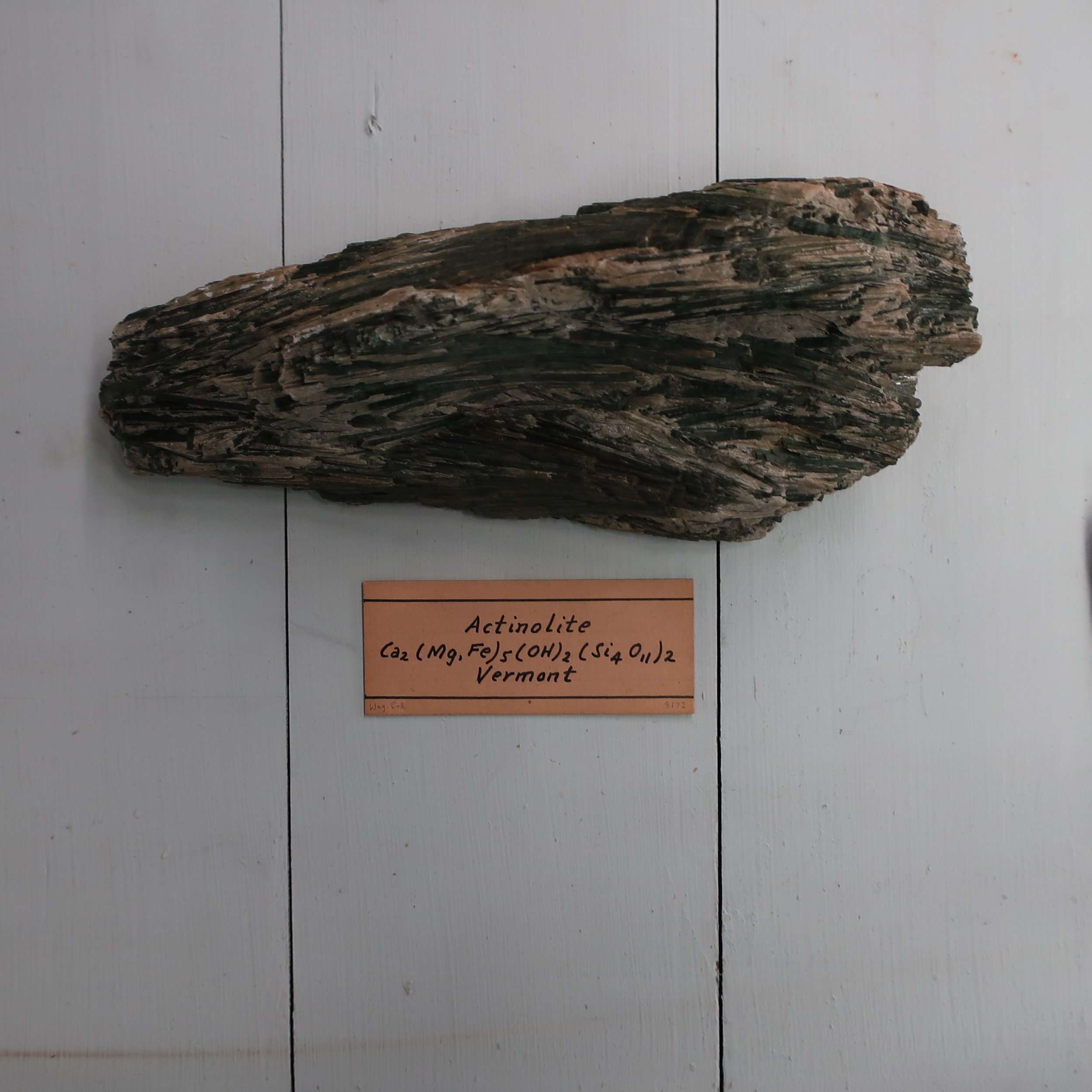
“Actinolite is green, of different hues, it may be divided into 3 varieties of crystallized, asbestiform, and glassy. It is composed of Silica Magnesia, Iron and Lime. Crystallized actinolite generally occurs in acicular hexahedral prisms, it has a shining lustre, and is translucent or transparent, it appears in fine fibres having a silky lustre, and sometimes disposed, in a radiating form. Asbestiform actinolite presents a brownish green colour, it occurs both massive and in capillary crystals, which are elastic, the crystals are sometimes disposed in wedge=shaped masses, they are opaque. Glassy actinolite differs from the preceeding in possessing an external lustre, which is vitrious and in being brittle actinolite is found chiefly in primitive rocks as gneiss mica slate, and limestone. It occurs in long 6 sided prisms imbeded in talc in Norway. Tyrol St Gothard &c. In the U States it is abundant and beautiful of a leek green colour, at Windham Vt.”

Andalusite is essentially composed of Silica and Alumina, but contains several other accidental ingredients. Sp. Gr. 3.16. This mineral occurs massive, and in the primary form, a right rhombic prism. It has a lamellar structure with joints paralell to the sides of this prism, its colour is grey, of a redish tinge lustre is vitrious, fracture uneven and tough. Alone it is infusible, before the blow pipe; it is not effected by acids. Above Inspruck in Tyrol, where it occurs in very large crystals, this species is accompanied by another, which presents the same form, also in other places in Europe, in our country in several places, in Maine, Connect, and Masschts., also near Chester Pennsylvania in rough light yellowish crystals.
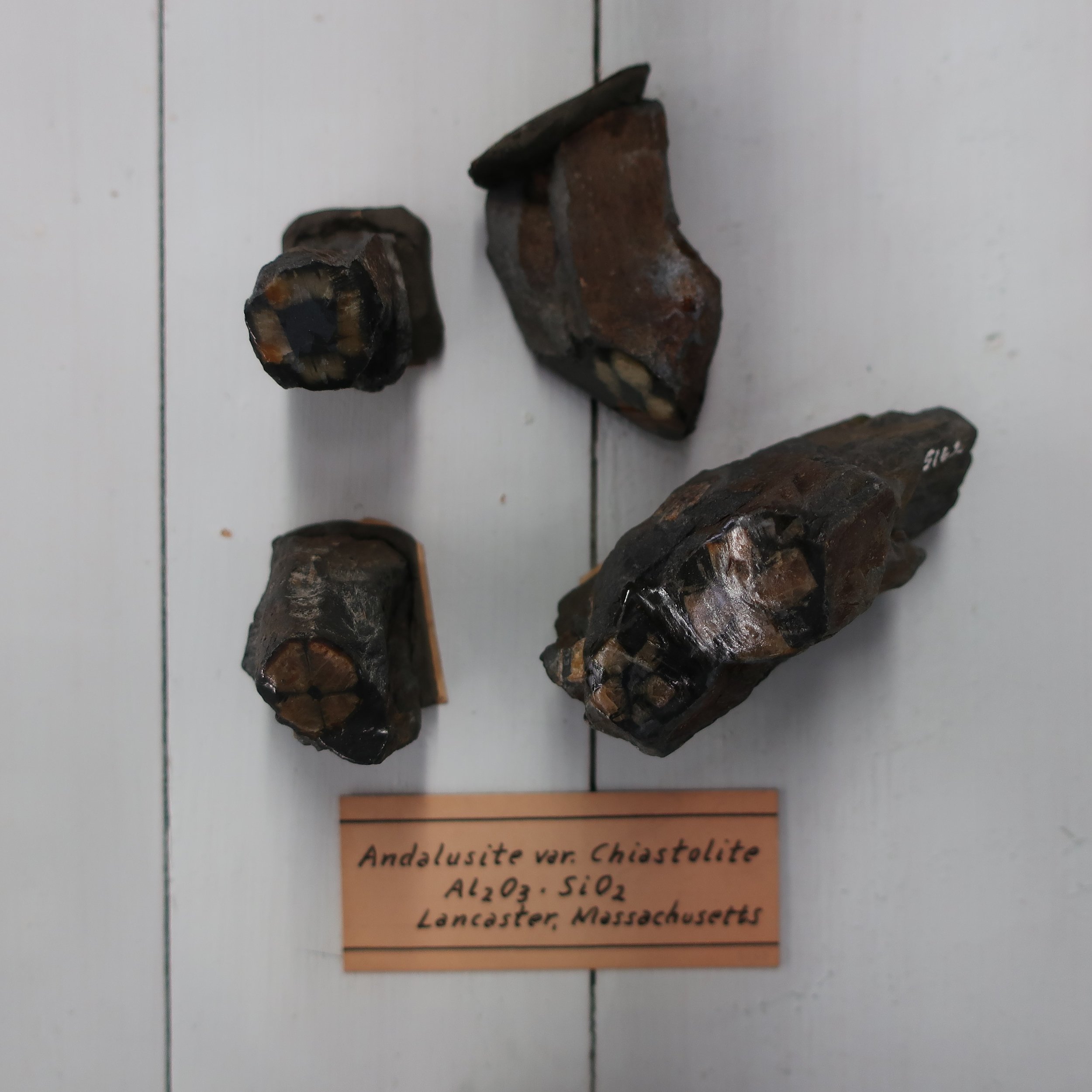
Chiastolite or Macle, formerly discribed as a distinct species, is now to be regarded as a variety of Andalusite, both having the same crystalline form and general physical characters, and agreeing also in chemical characters. Its only peculiarity is, in the singular crystalline form assumed by the separate crystals of the mineral, apparently when imbeded in a softer medium, in which sufficient freedom was not given to allow them to write perfectly, though they seem to have been governed by a uniform law, of attraction of grouping, but I say to the uniform law of the crystalic forces, approaching each other, at right angles. When not at right angles, they may have been subject to some disturbing force, while the rock continued soft, but I should say, the crystalic forces were directed by other attraction, the deficit of which, prevented a perfect crystallization. The figures I shall shew you, have been taken from several characteristic specemens of this mineral, which I loaned from Lancaster Massachusetts. It is rare that the faces of the prisms are of the same length, by their mode of aggregation, they assume perfect immitations of a cross. As shewn by the first figure, in the centre of which a small prism of white, andalusite is interposed, the black portions surrounding it. Being a thin layer of clay slate, the crystals are sometimes 4 inches long, but their extremities, as well as the cross sections made in different parts of them, present very different appearance, attributable no doubt. to a disturbance of the crystalic forces to which all crystallization is subservient. Chiastolite occurs imbeded in clay slate, or shiste, in many places in Europe, but the specemens from these localities are small compared with those from Lancaster Massachusetts, where the mineral is exceedingly abundant in clay slate it has been found in many other American localities.
![“There are several varieties [of Asbestous ] which generally present a fibrous texture, but vary in respect of flexibility. The fibres have not been seen in any determinate form, the name is derived from the greek signifying imperishable, this mine](https://images.squarespace-cdn.com/content/v1/5b69b9bd4611a043ec05da32/1541623803932-Z1UQMX6Y1JG6EVBFFL54/Serpentine+%28Asbestous%29.jpg)
“There are several varieties [of Asbestous] which generally present a fibrous texture, but vary in respect of flexibility. The fibres have not been seen in any determinate form, the name is derived from the greek signifying imperishable, this mineral was known to the greeks. Asbestous is of extremely difficult fusion, it contains Silica 56, magnesia 27. Lime 15. Alumina 2.”
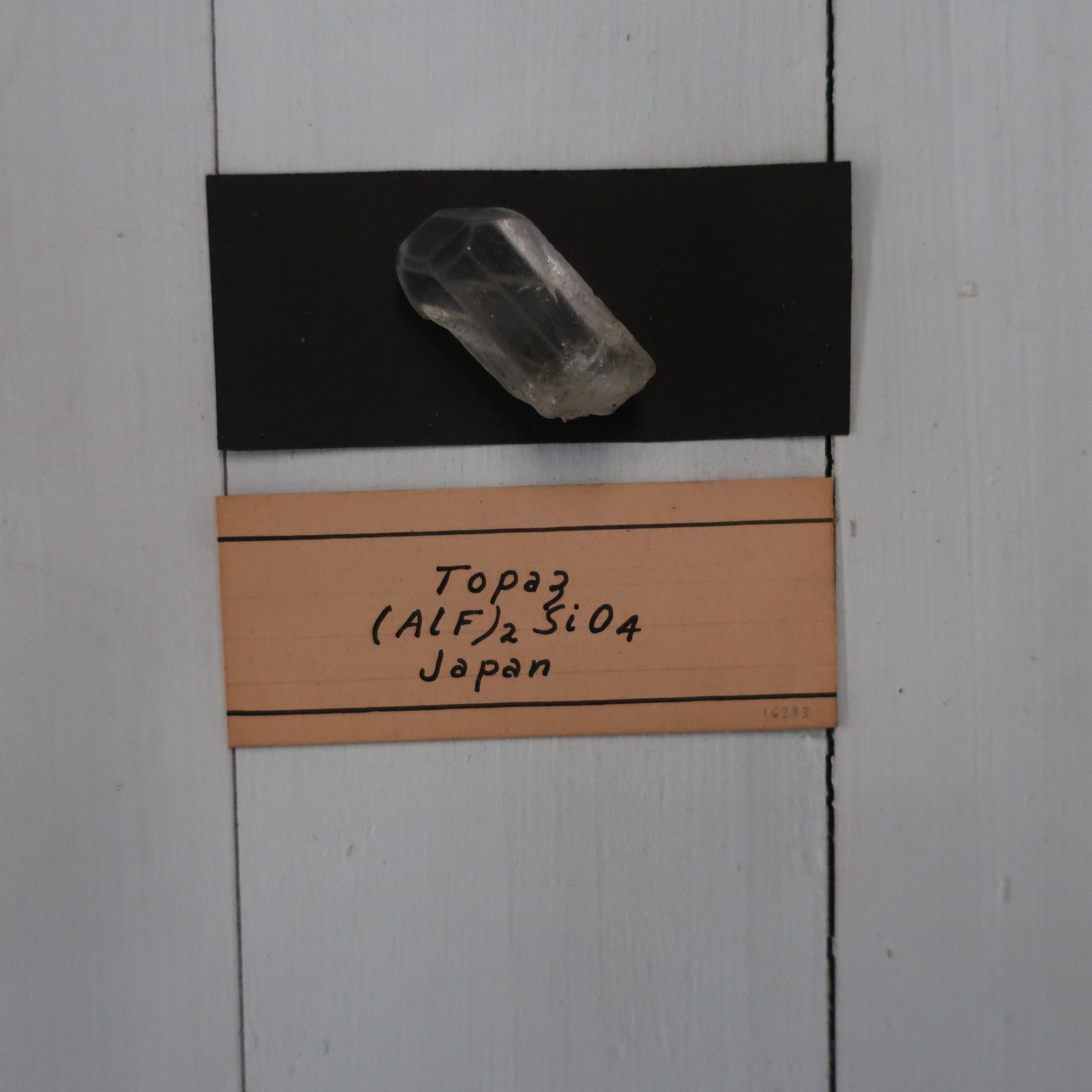
“Topaz consists of Silica 44, Alumina 47, Fluoric acid 7, Sp. Gr. 3.49. Topaz occurs massive, in rounded pieces and crystalized; general form prismatic, variously terminated, the prisms are generally striated longitudinally. It is sometimes limpid, and nearly transparent, or of various shades of green blue or red. It becomes electric by heat and is easily excited by friction, the opposite terminations of a crystal presents opposite kinds of electricity. The greenish Topaz of Siberia becomes electric by heat but not by friction, the pale yellow Saxon Topaz becomes electric by friction, not by heat, but lose their color when exposed to fire. The Brazilian Topaz becomes electric by heat, and red when placed in the fire. B.B it does not fuse. The primary form is a right rhombic prism, and terminated by 4 planes, the solid angles are often replaced. The Topaz is almost peculiar to primitive countries. It is not, like quartz, the component part of any particular rock; but in Saxony & Cornwall it is associated with Tourmaline, quartz, & lithomarge, producing a mixture called Topaz Rock, its usual matrix is Granite.
Cairngorm in Aberdeenshire has produced the largest and most magnificent crystals of topaz. Jameson mentions one, which weighed 19 ounces--they are, however, rare from this locality. In the Ural mountains of Siberia they are more common. In Brazil they occur in an argillacious earth, resulting from the decomposition of primitive rocks. Mimas Novas is the locality in Brazil: the larger portion of such as are used in Jewelry, being more or less altered in colour by exposure to heat. In the U.S. we have as yet but one locality of Topaz, it occurs in Trumble County, Connecticut, in a vein about a foot in width accompanied by fluor-spar of mica. The Grand mogul is said to possess an octangular topaz weighing 157 ¾ carrats weight, which was purchased for $60.000 Dollars.”
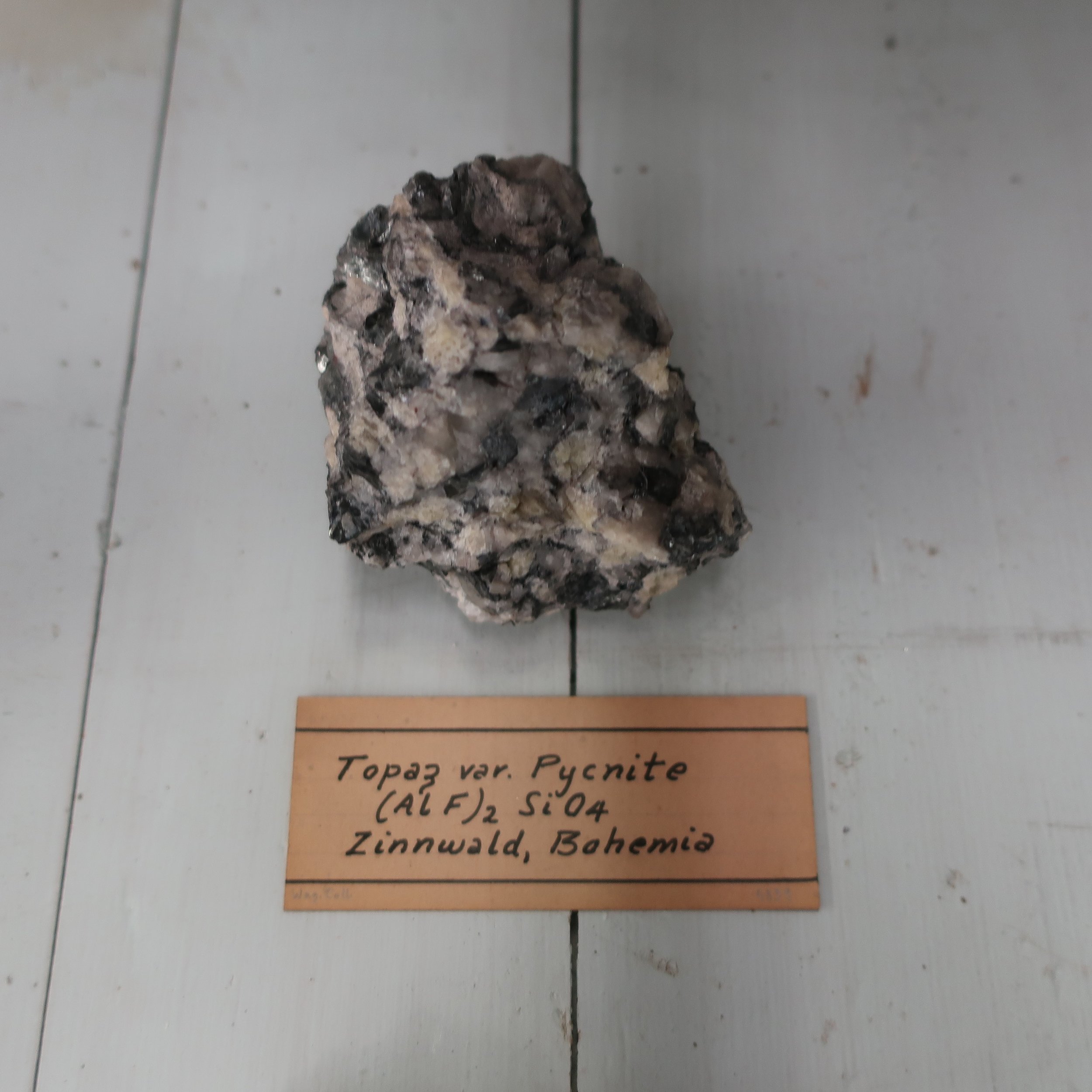
“Pycnite is a variety of Topaz, contains Alumina 51. Silica 38. Fluoric 8. Sp. Gr. 3.51. Pycnite occurs in long 6 sided prisms, deeply striated longitudinally. It has a dull yellowish, or redish white color. BB it does not fuse alone. It is found entering into the composition of a rock, chiefly consisting of quartz, and mica, at Altenburg in Saxony.”
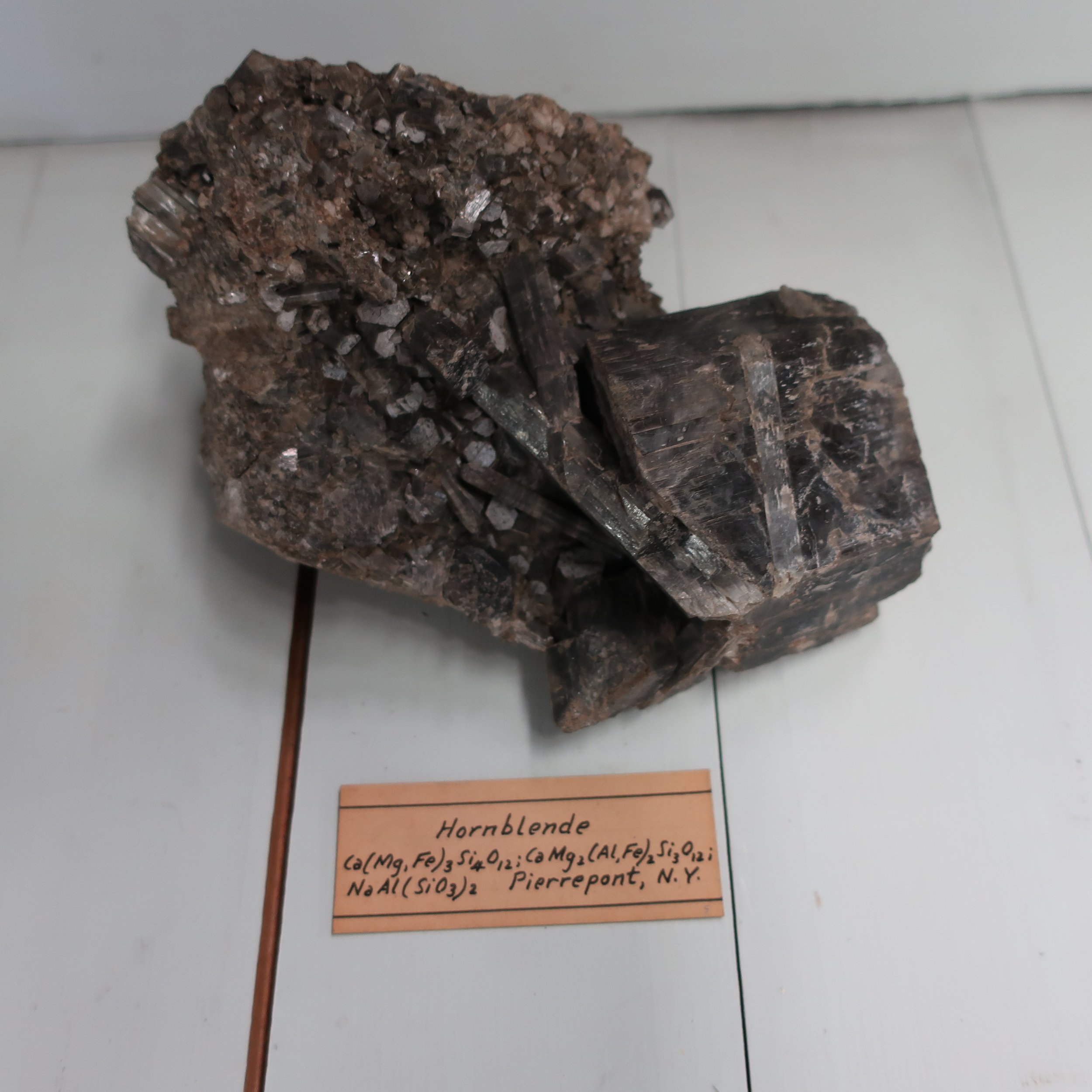
“Massive hornblende has a crystalline structure, consisting of minute, and often of long crystals, intersecting each other, sometimes confusedly radiating. It is very tough, and difficult to break.”
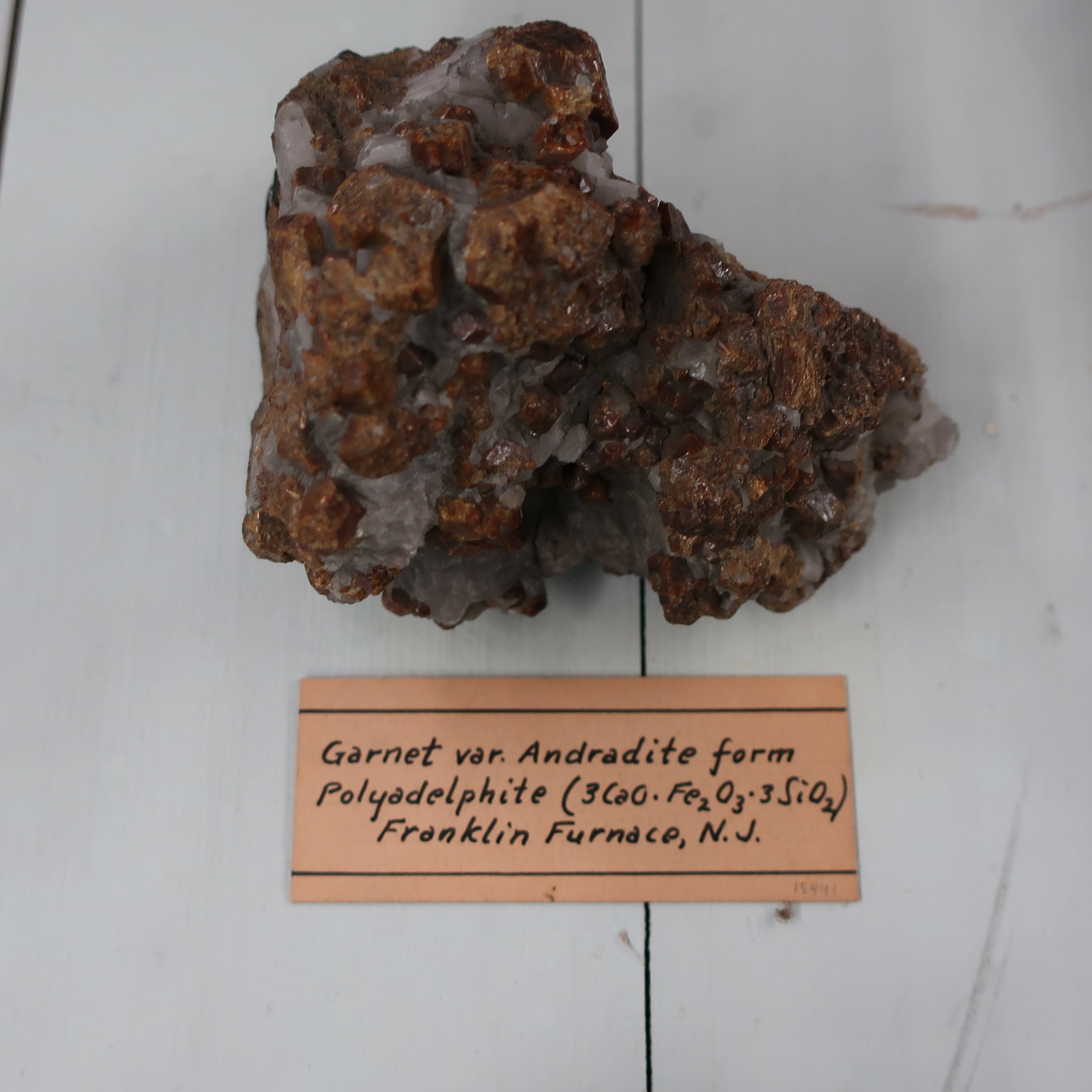
“Polyadelphite is composed of Silica 36, Lime 24, Iron 23, manganeese 4, Alumina 3., Sp. Gr. 3.76. It is of different shades of yellow. The colors are not bright, some specemens bear a close resemblance to Blende. The mineral is composed of translucent roundish grains, and of imperfectly foliated masses; agglutinated together. The lustre is resinous; it occurs with Franklinite, and red oxide of Zinc at the Sterling mine Sussex County N.J. It is a rare mineral, and never found in crystals.”
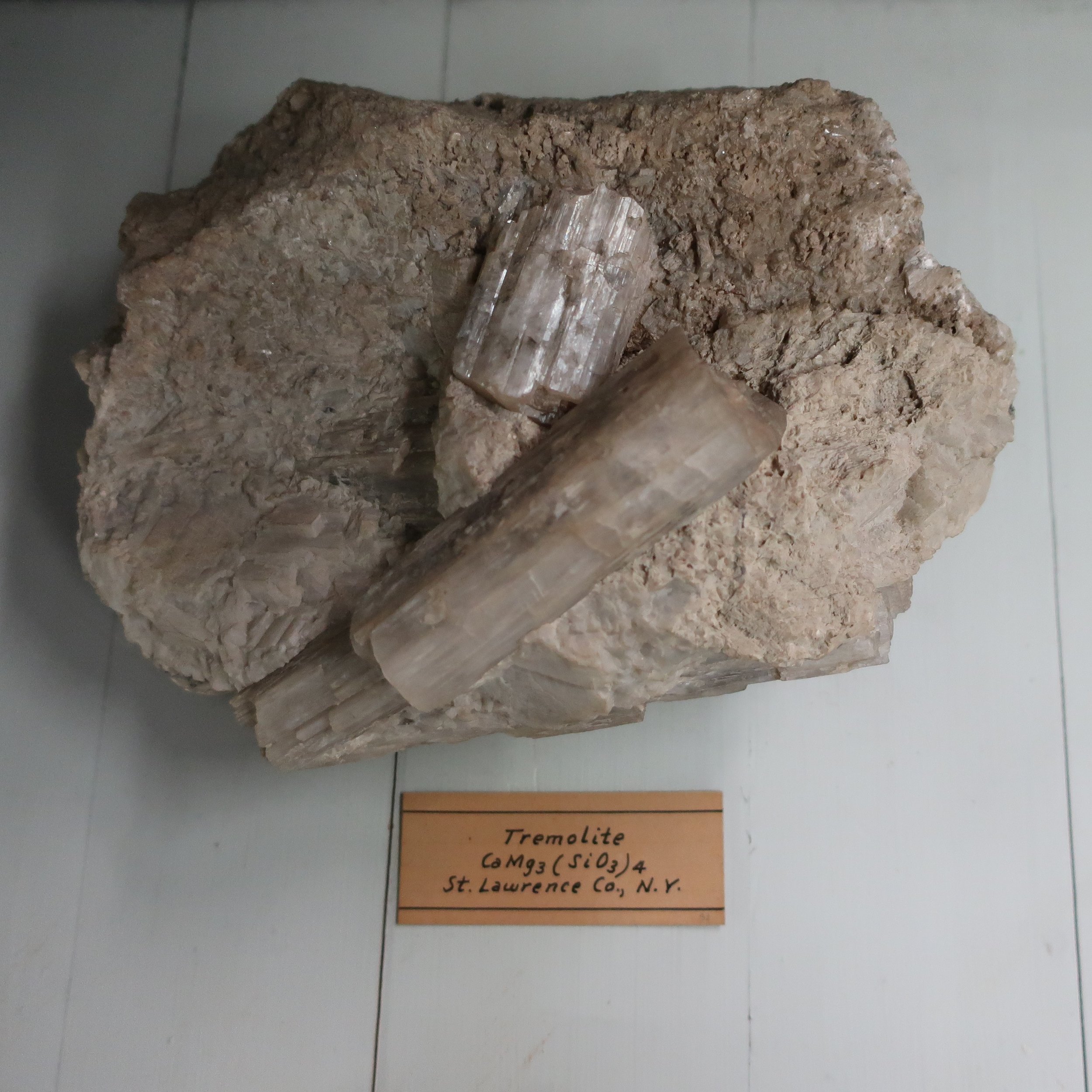
“Tremolite is a combination of Silica, magnesia, & Lime, Sp. Gr. 2.9. Its colour is white occasionally with a tinge of grey yellow blue, & red. It occurs in masses, composed of delicate crystalline fibres, which sometimes radiates, it is very brittle, and becomes phosphorescent by heat, or friction; Asbestiform Tremolite occurs in masses consisting of fasciculated groups of minute diverging occasionally radiating fibres. Its fracture exposes a delicate fibrous texture, with a glistening pearly or silk lustre. It becomes phosphorescent by friction, which is not the case with common asbestos, a mineral it otherwise much resembles. Beautiful specimens all met with at St. Gothard. in Switzd. and many other places in the US. This variety is common in all the Dolomite, and granular limestone of the country. At canaan in Connect. it is abundant, there are two other varieties of this mineral called Norwegian Tremolite, and Calamite, some have even doubted their being even varieties.”
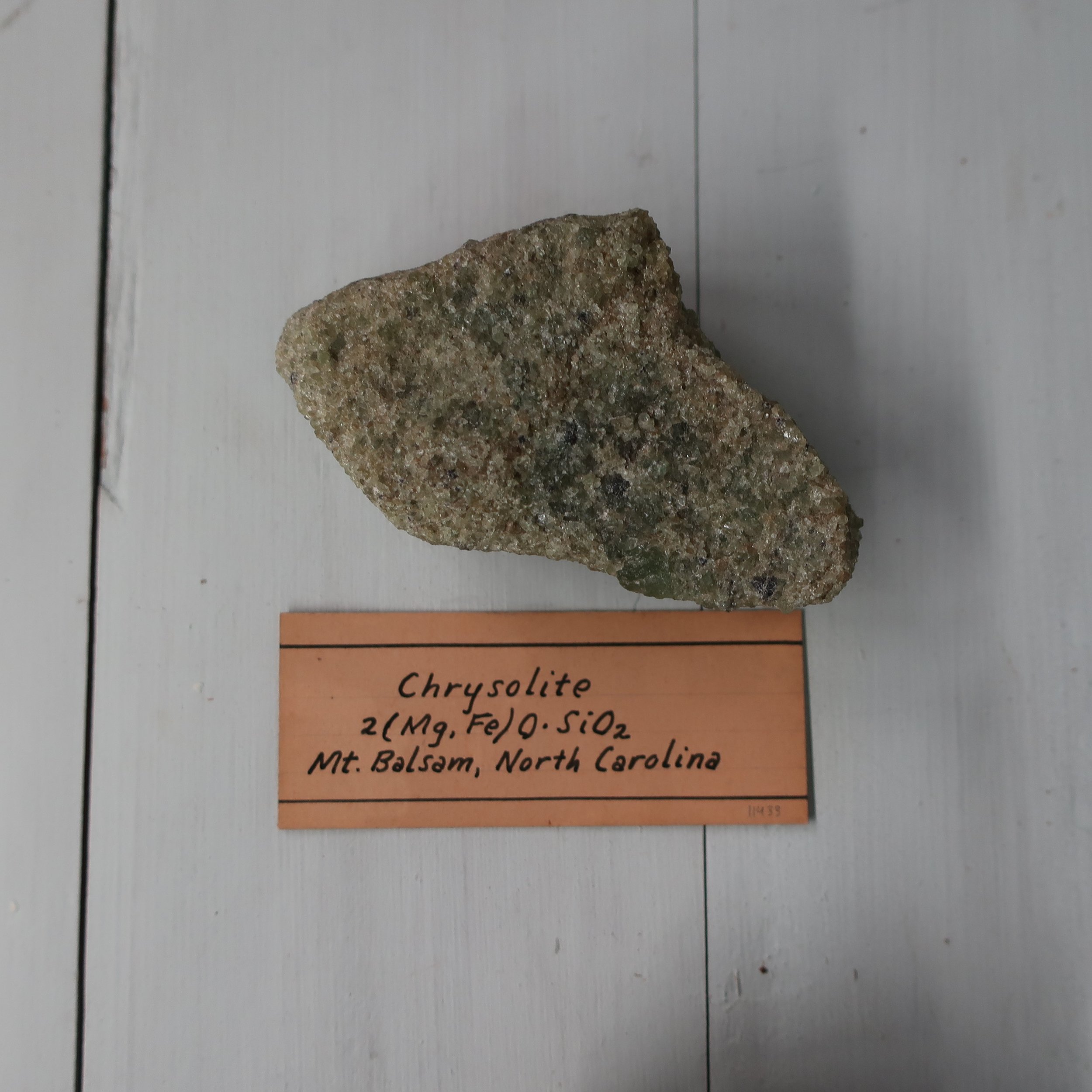
“Chrysolite (anhidrous silicate of Magnesia) consists of Magnesia 50, Silica 40, Iron 9, Sp. Gr. 3.3, and occurs in somewhat rounded crystalline masses. Their form is a right rectangular prism, color is bright yellow tinged with green. BB it is infusable alone. The name chrysolite imports a valuable stone, or gem. The best specemens of this mineral are brought from Constantinople, and the Levant, but under what circumstances they are found, we are not informed.”
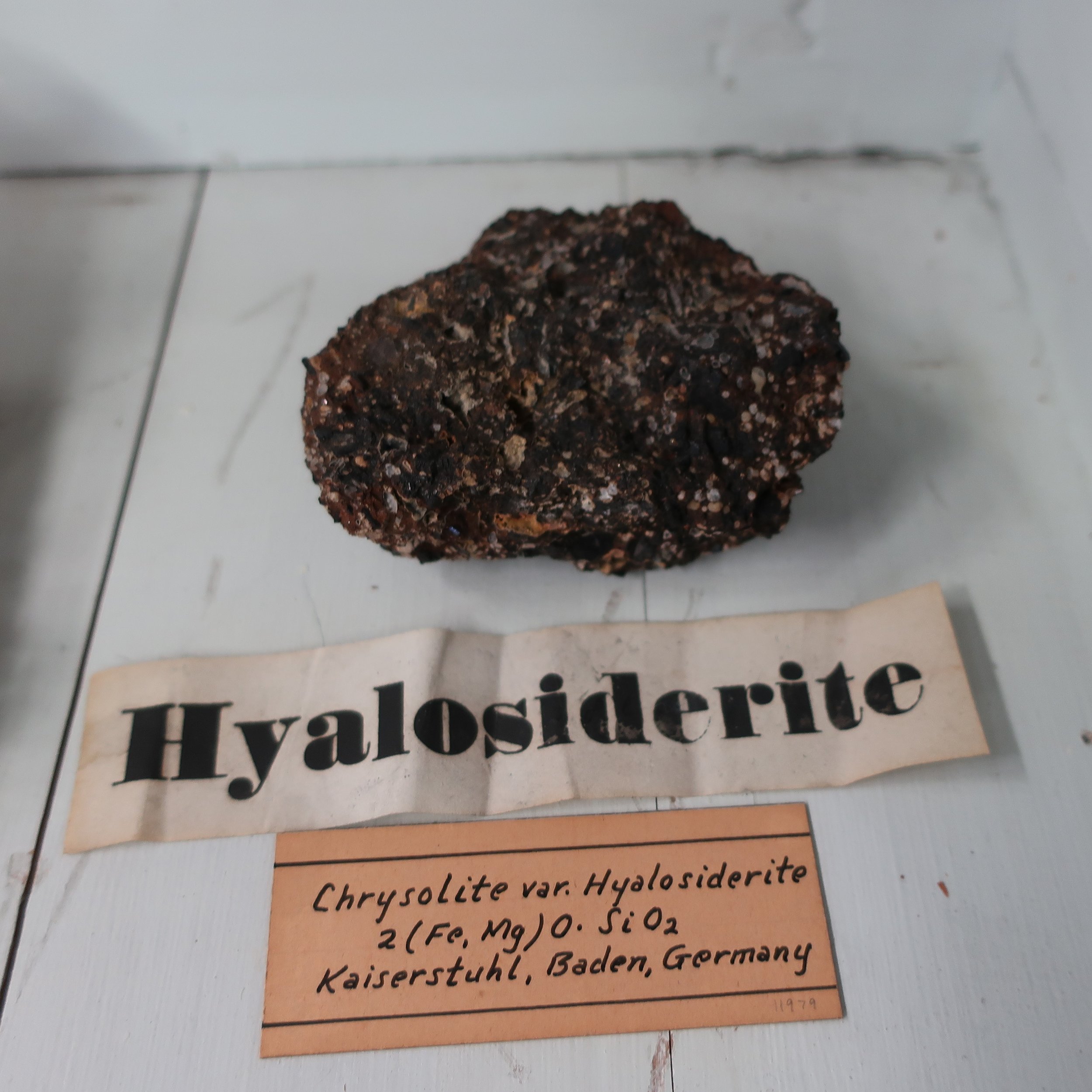
“Hyalosiderite derives of 2 Greek words signifying Glass & Iron. this mineral was found in amygdaloid rock. It is composed of Silica 32, Iron 30, Magnesia 32, Potash 3. Some mineralogists have considered this species a variety of Chrysolite. Color yellowish or redish brown, it is usually crystallized. The primary form is an octohedron.”
![“Deweylite [ is a variety of Serpentine] found in seams and irregular veins in Middlefield, Massachusetts. It contains Magnesia 40, Silica 40, Water 20, Sp Gr 2.3. It is yellowish and greenish white, lustre is vitrious, inclining to resenous, easil](https://images.squarespace-cdn.com/content/v1/5b69b9bd4611a043ec05da32/1541623990677-EFZOX92HNJ5F7FATHVEF/Deweylite.jpg)
“Deweylite [is a variety of Serpentine] found in seams and irregular veins in Middlefield, Massachusetts. It contains Magnesia 40, Silica 40, Water 20, Sp Gr 2.3. It is yellowish and greenish white, lustre is vitrious, inclining to resenous, easily frangible when emersed in water.”
![“Picrolite must also be classed as a variety of [Serpentine]. It is massive or fibrous, with a radiated structure it is leek green, passing into yellow. It occurs in irregular veins in Sweeden, traversing veins of Iron ore, and associated with Cal](https://images.squarespace-cdn.com/content/v1/5b69b9bd4611a043ec05da32/1541624001968-Y9DPWNYAPBKH7N0EQW05/Serpentine+Picrolite.jpg)
“Picrolite must also be classed as a variety of [Serpentine]. It is massive or fibrous, with a radiated structure it is leek green, passing into yellow. It occurs in irregular veins in Sweeden, traversing veins of Iron ore, and associated with Calc spar, and serpentine.”
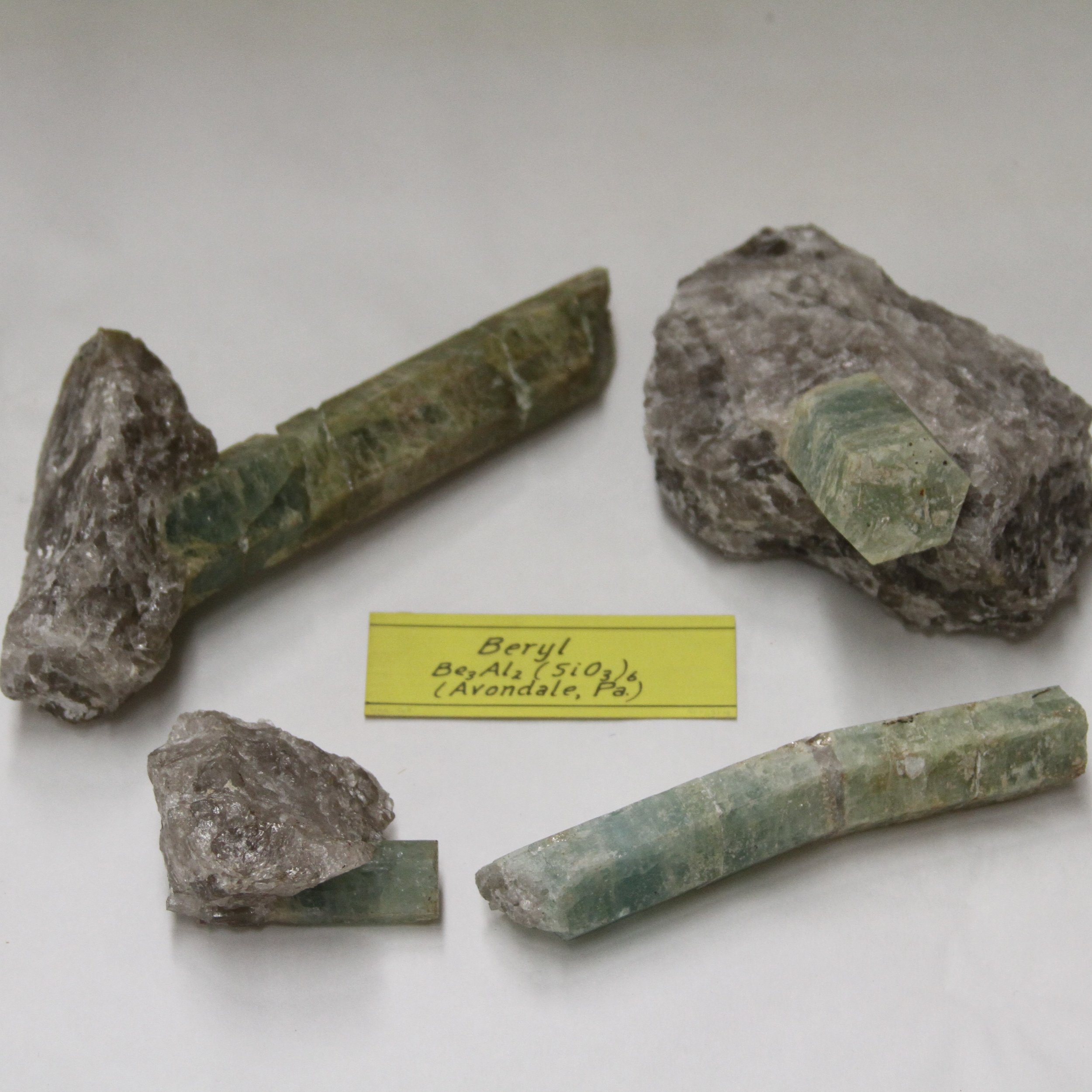
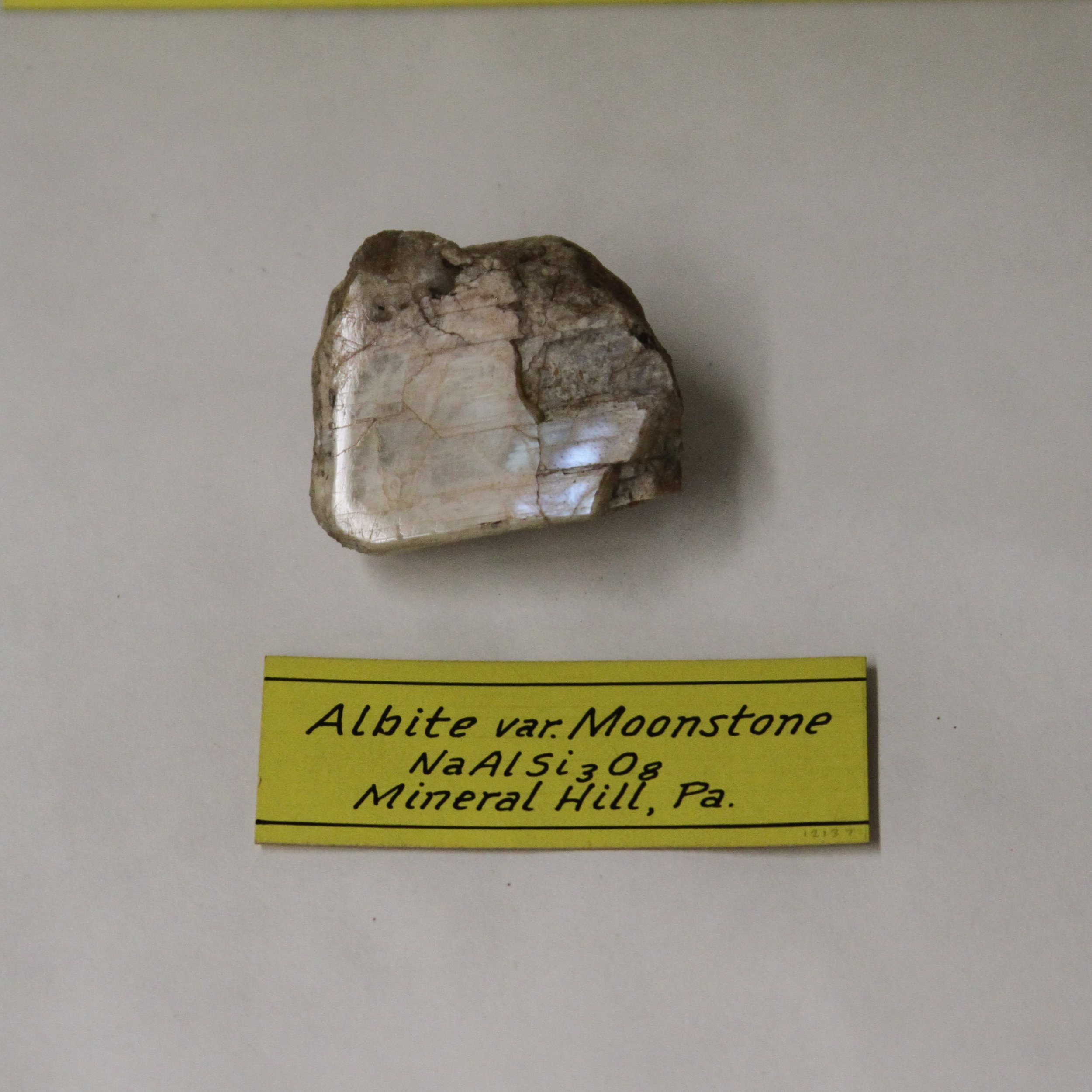
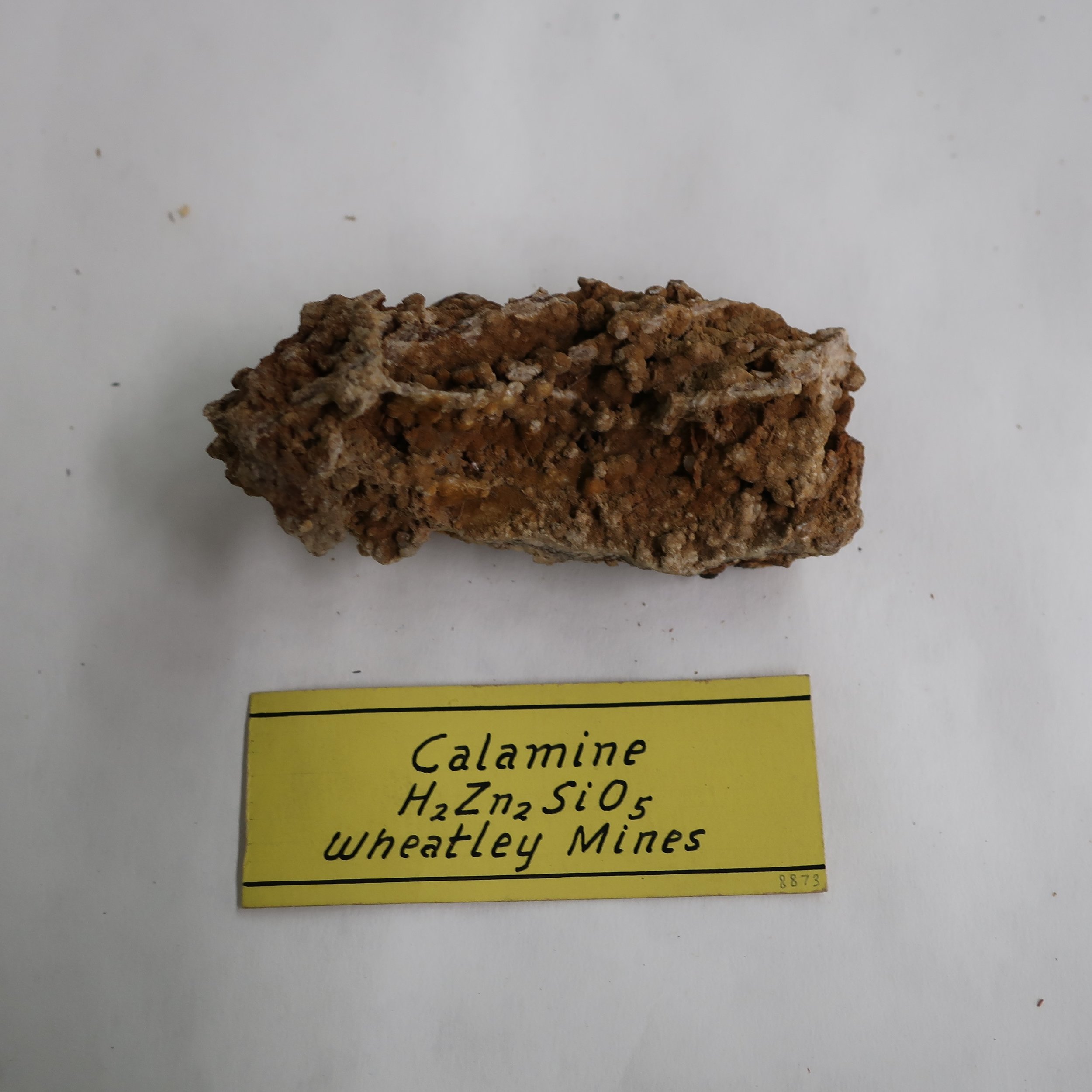
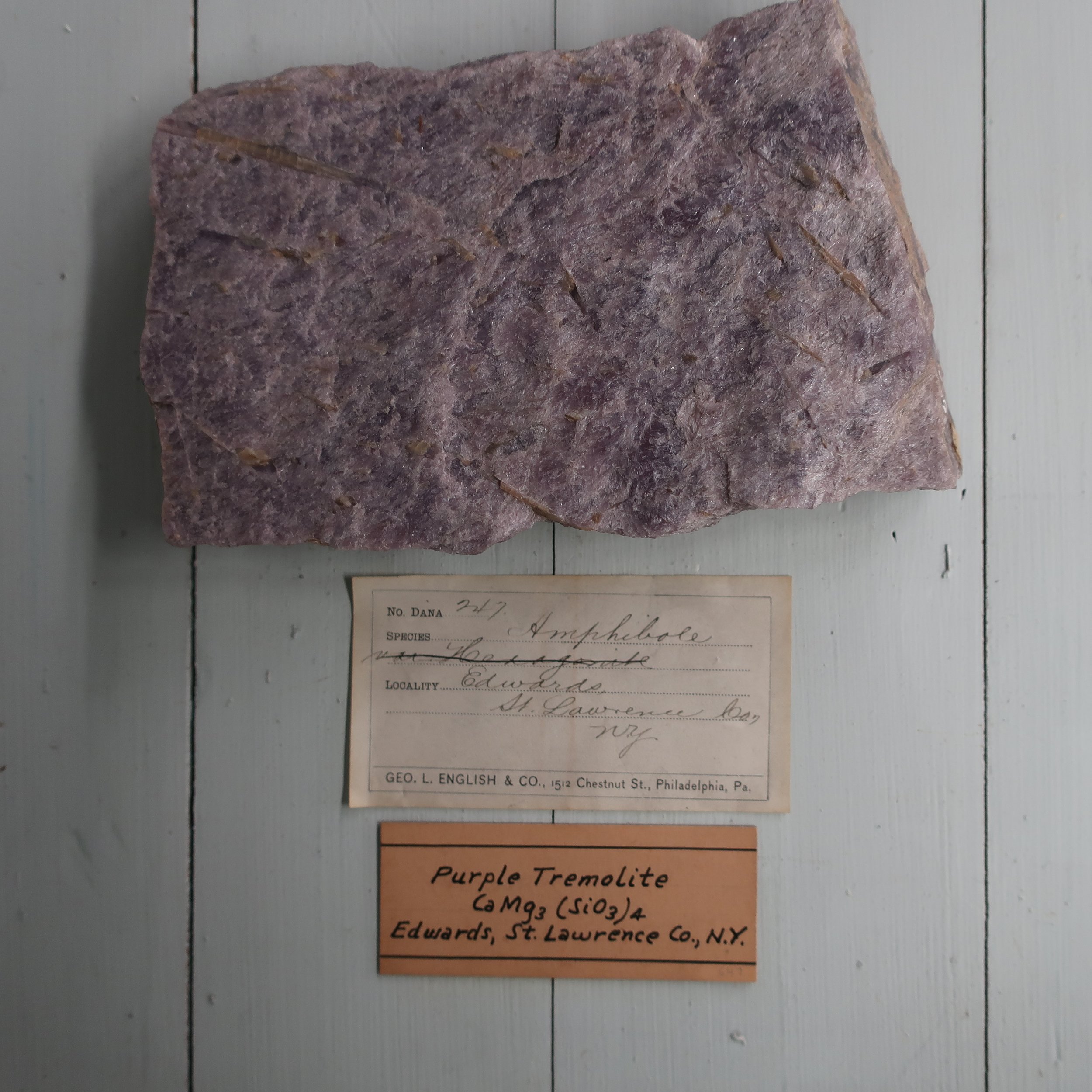
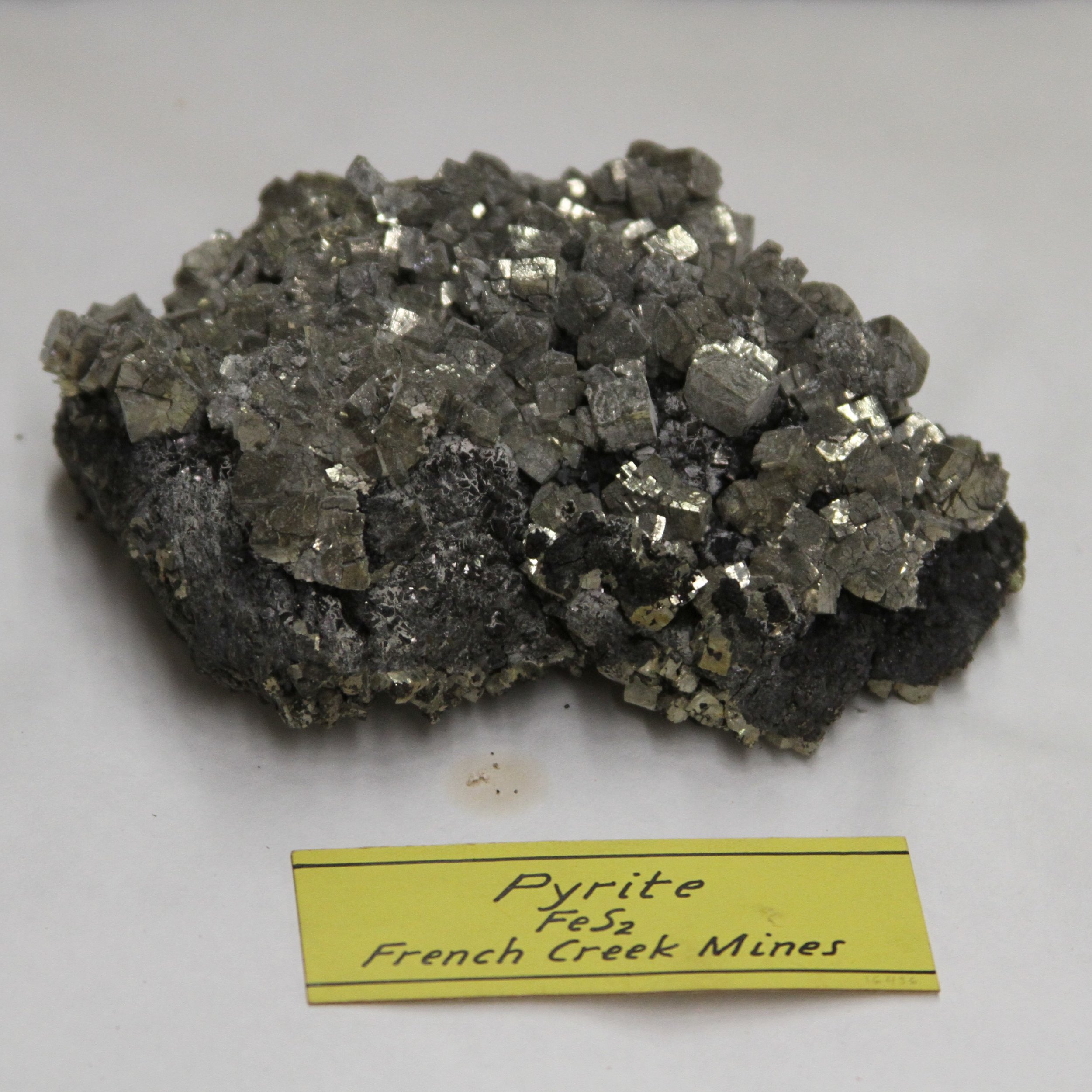
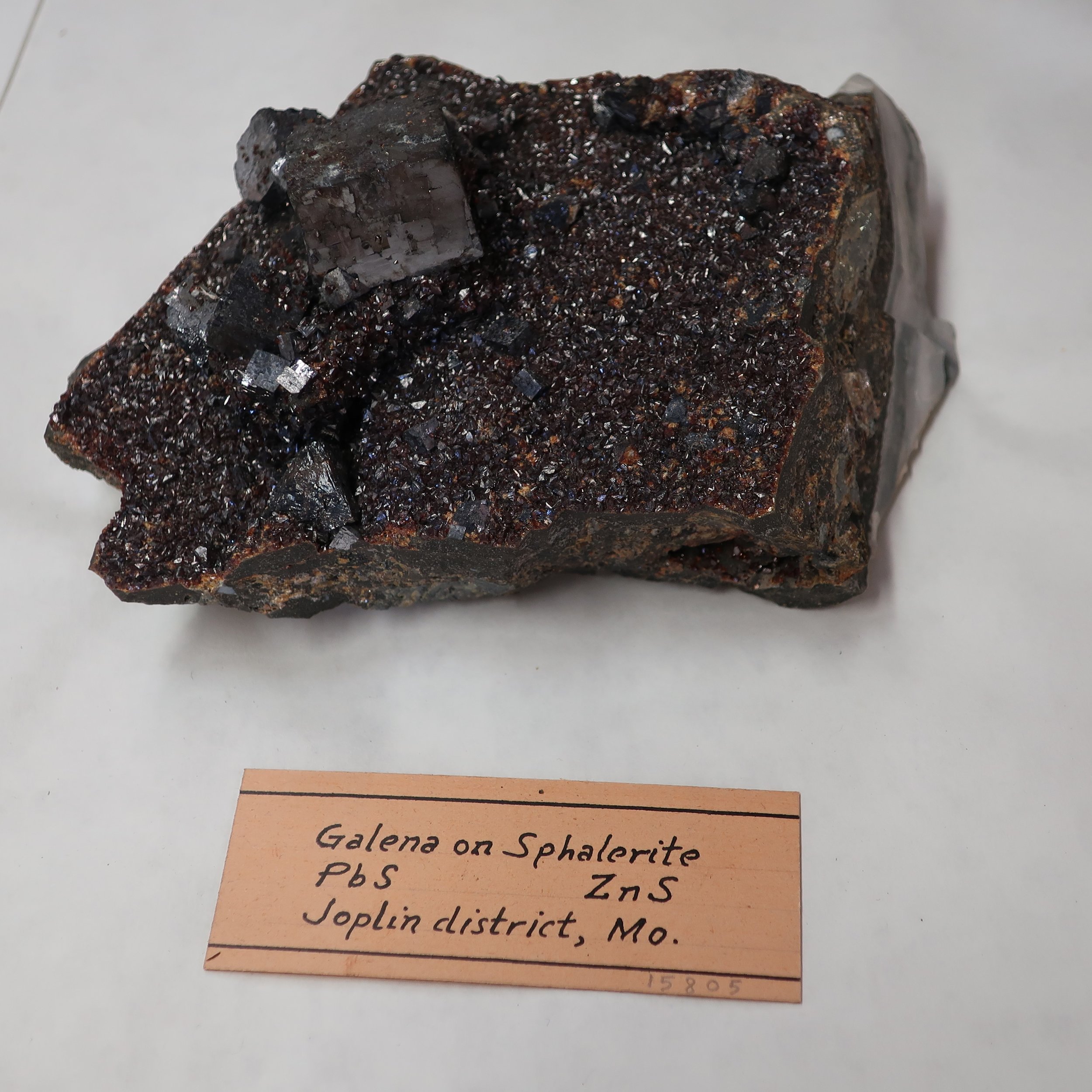
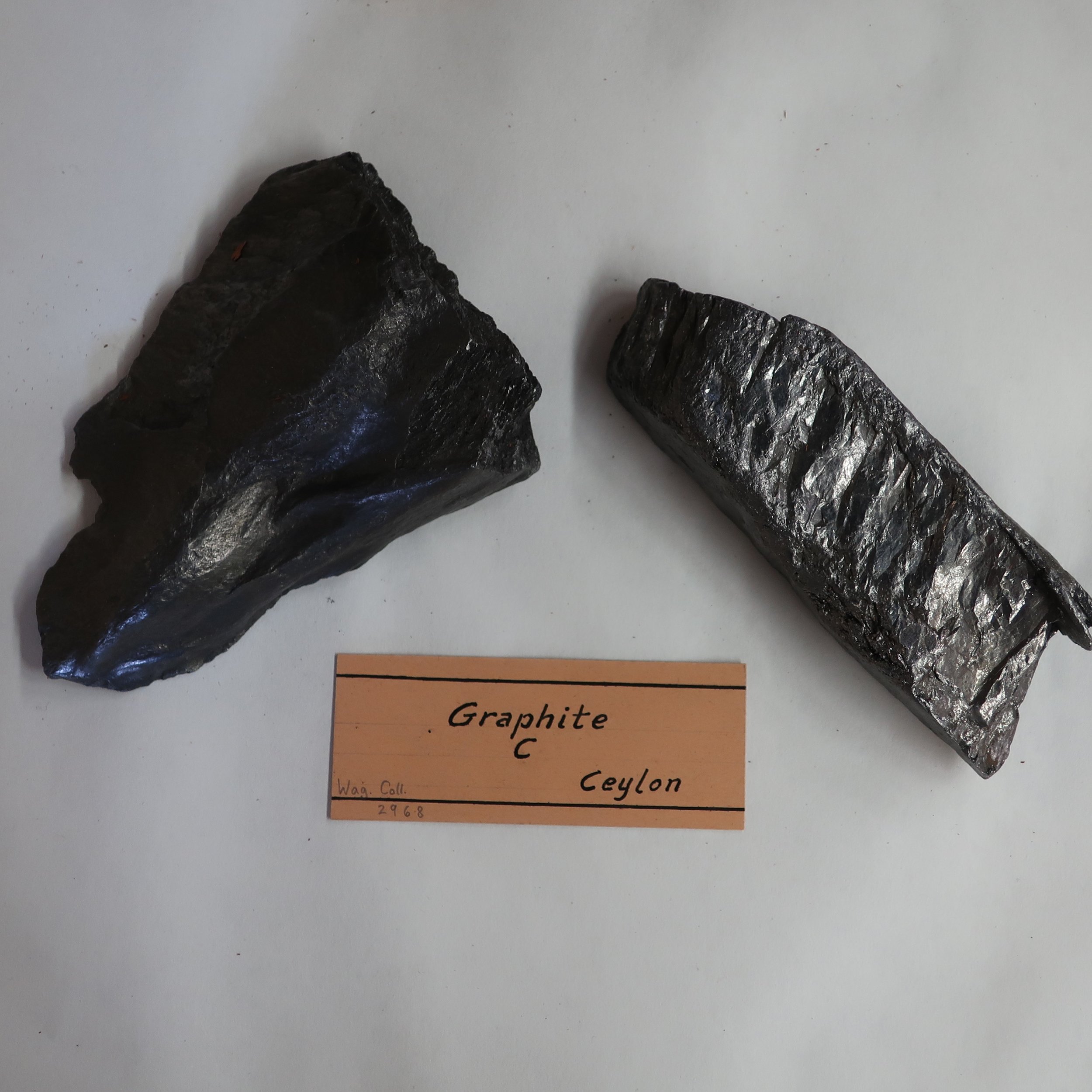
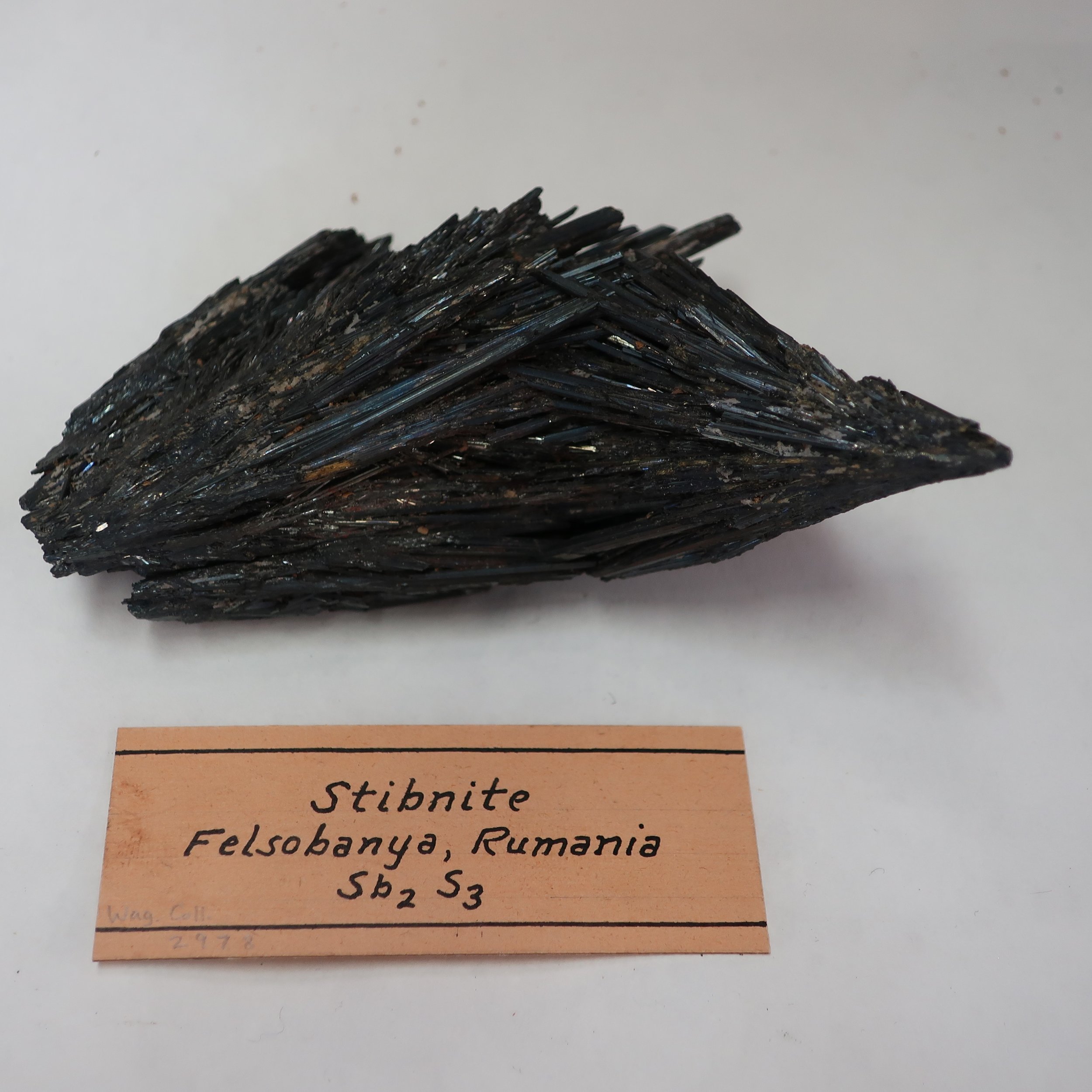
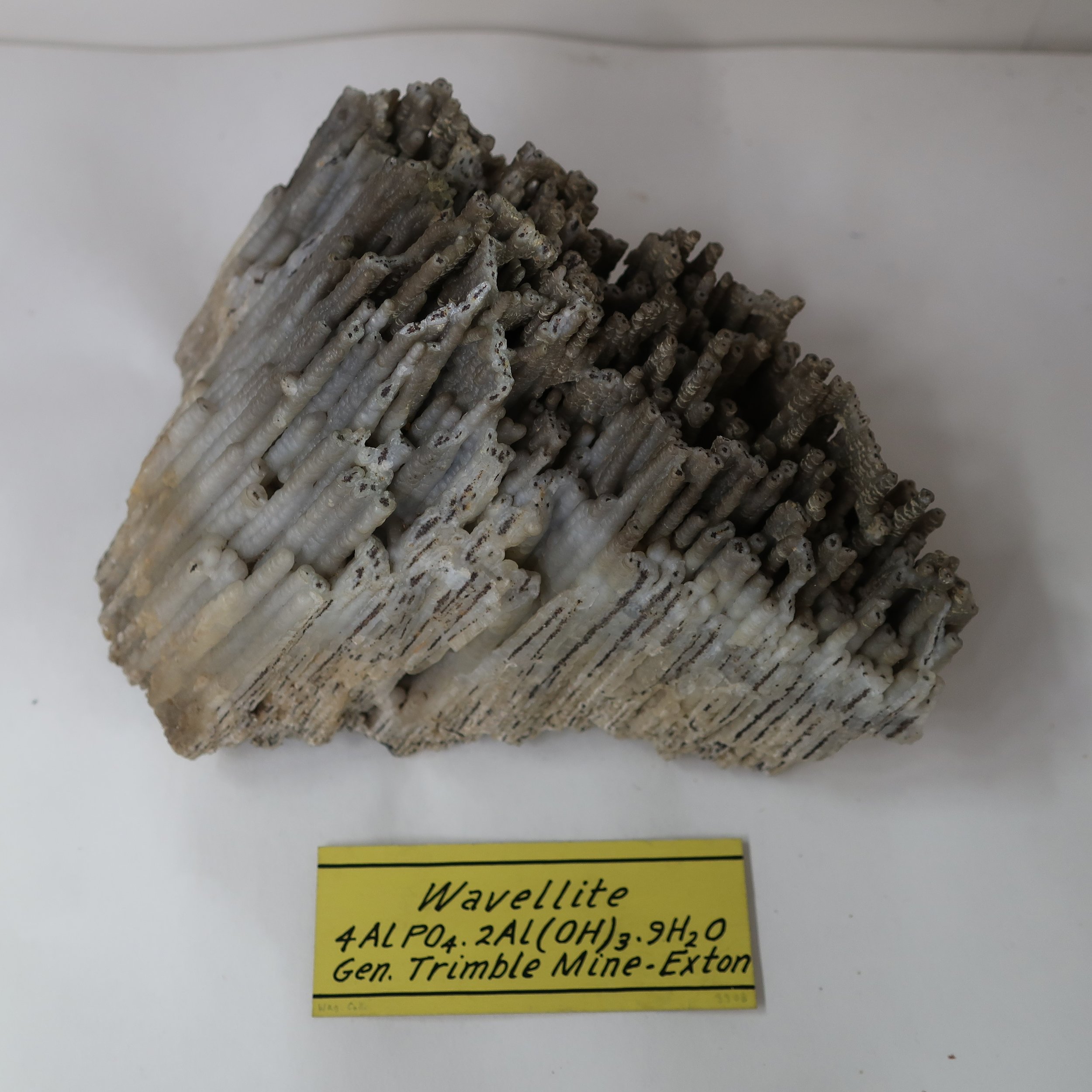
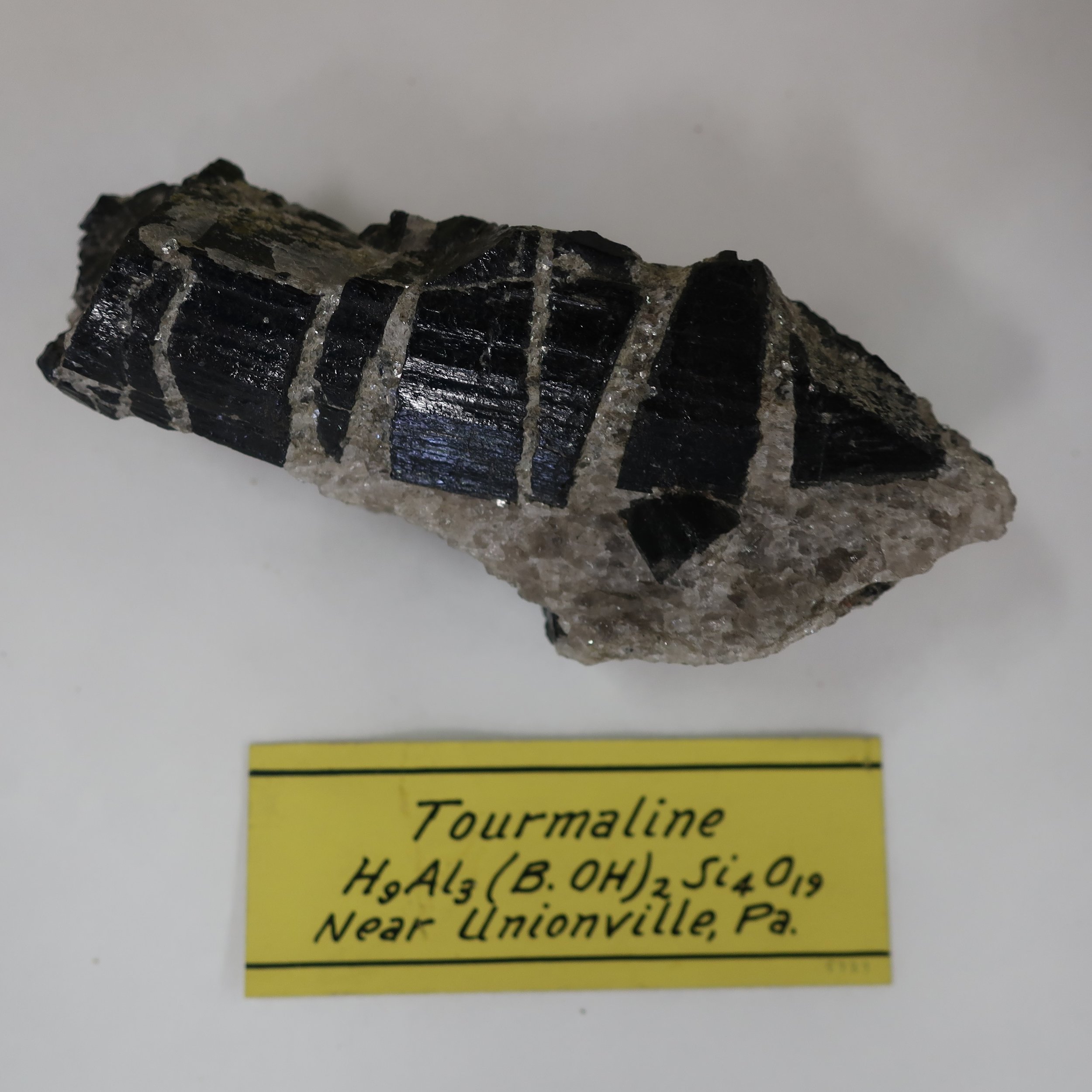


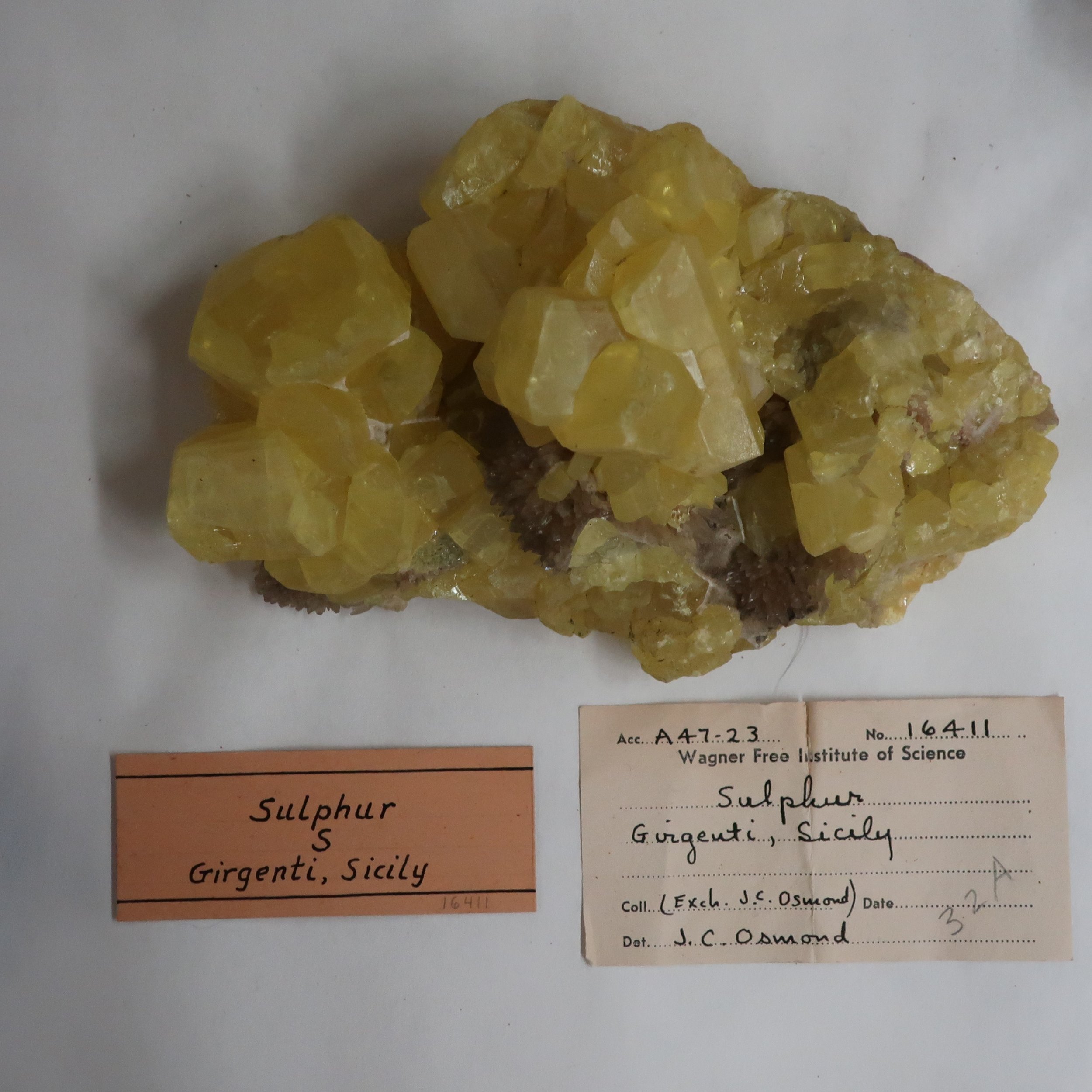
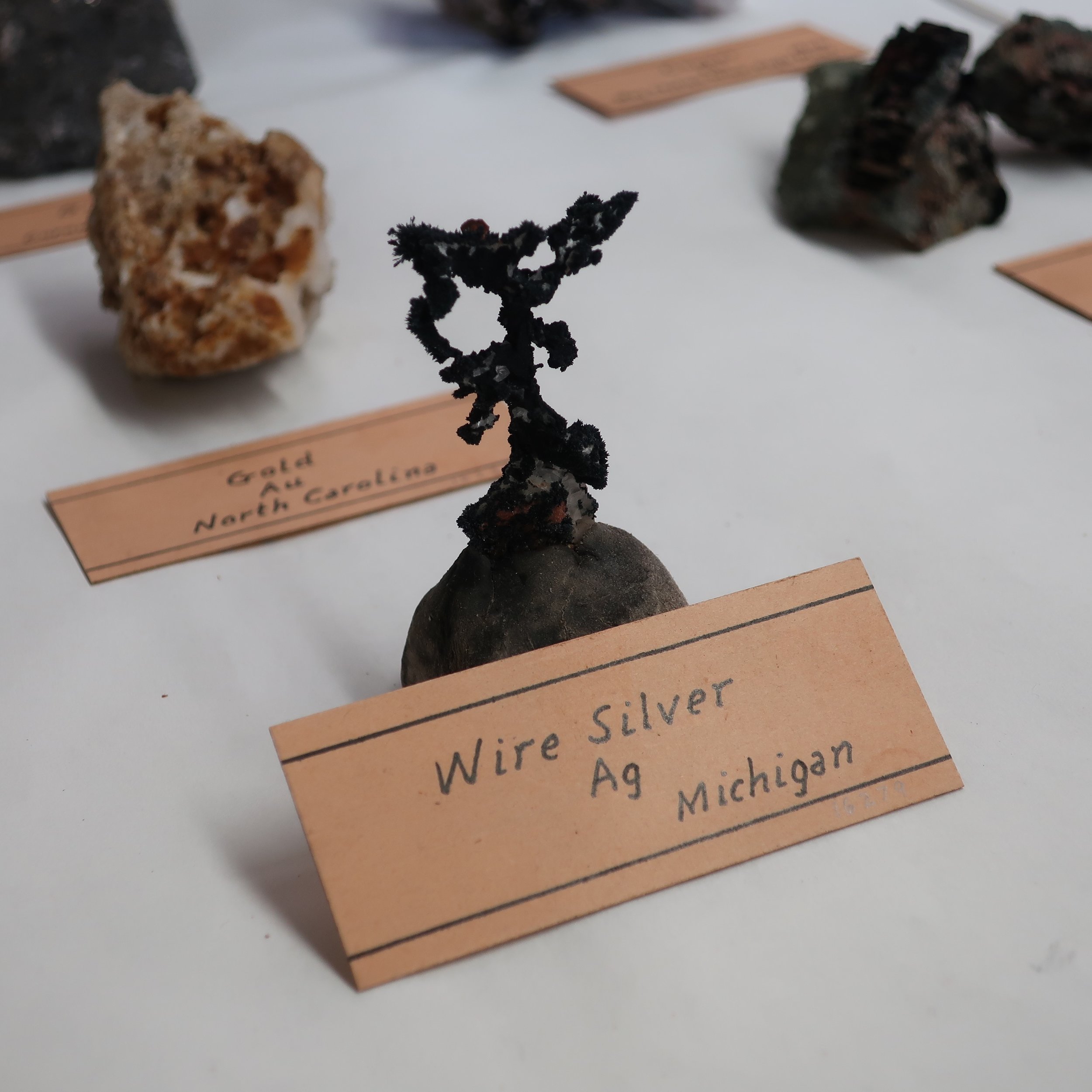
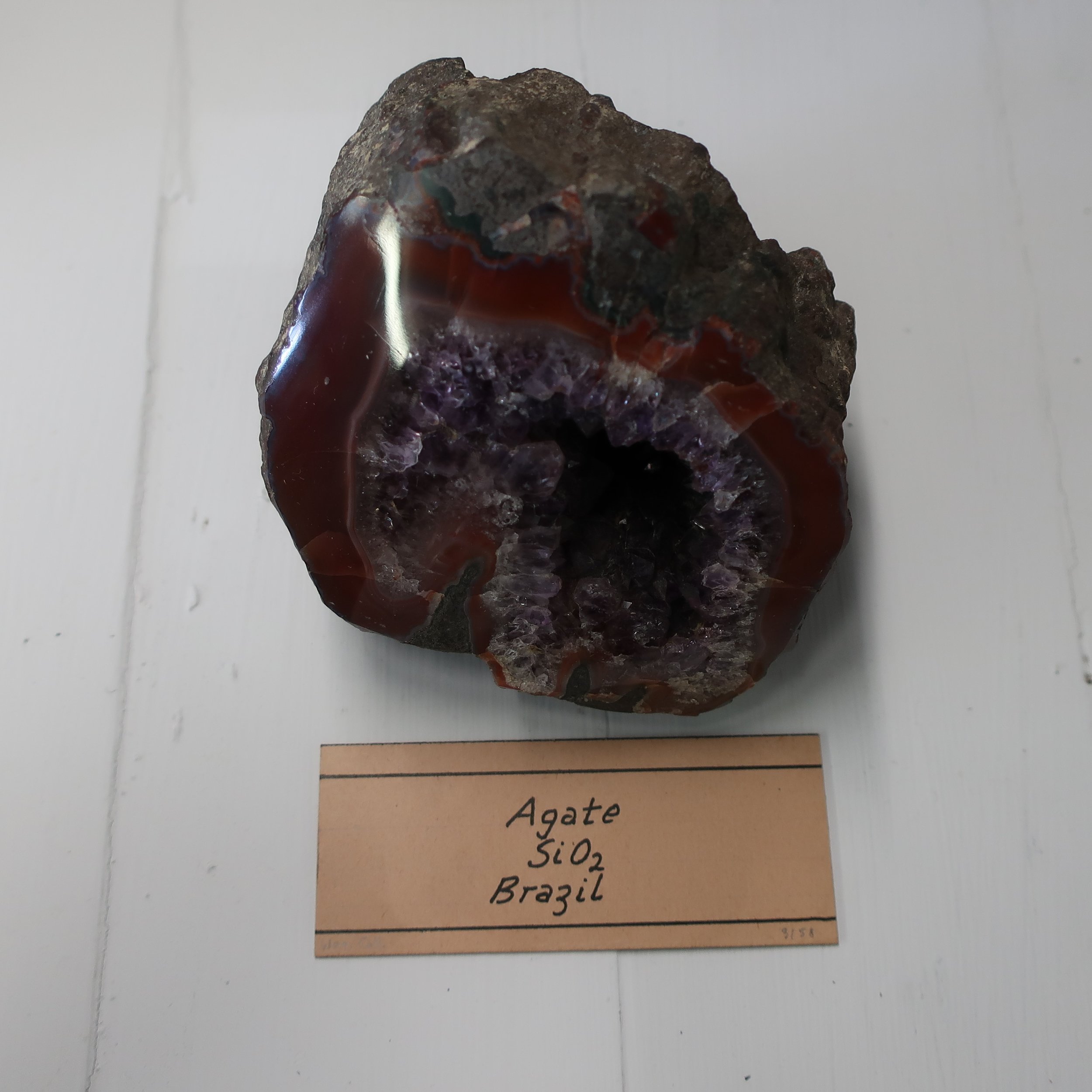
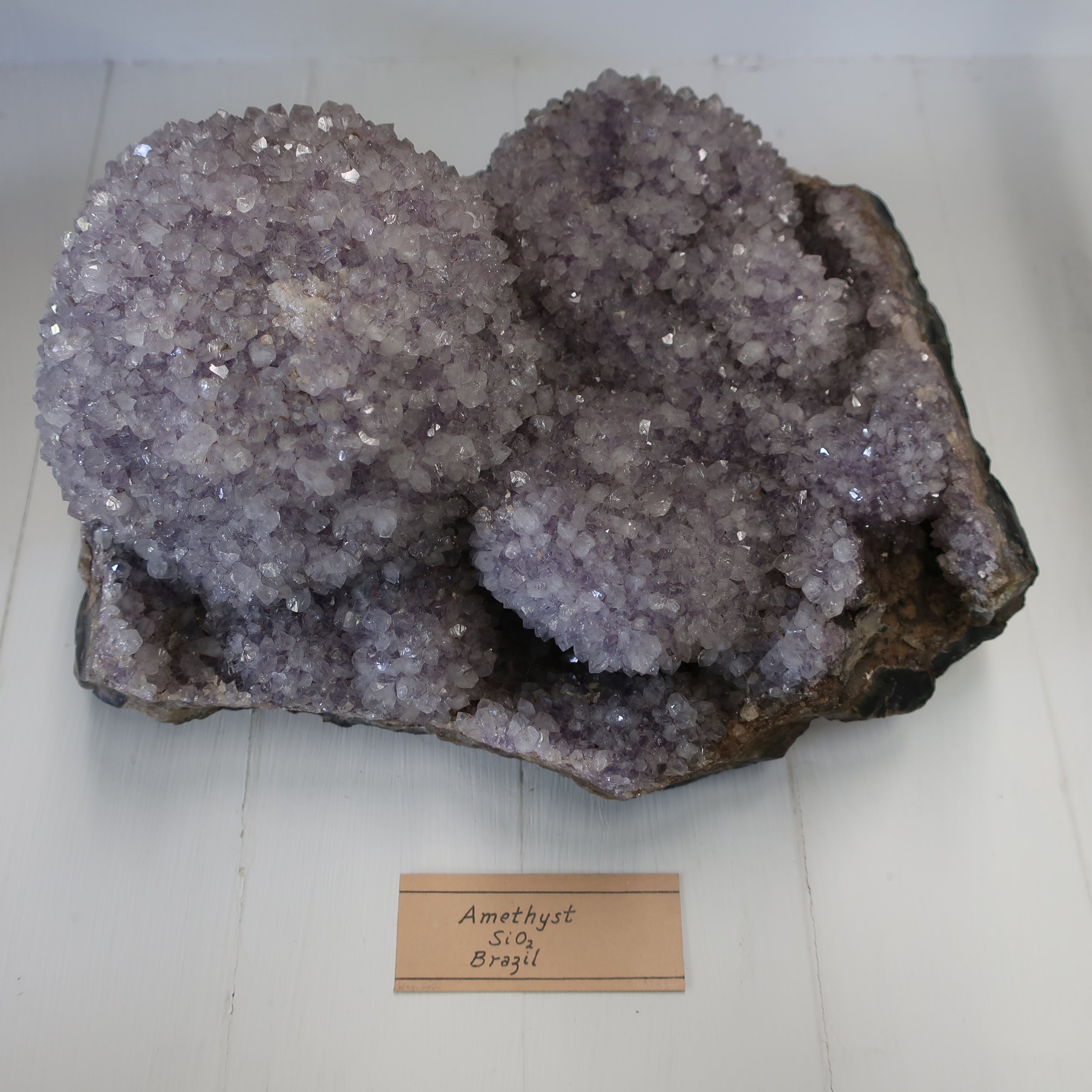
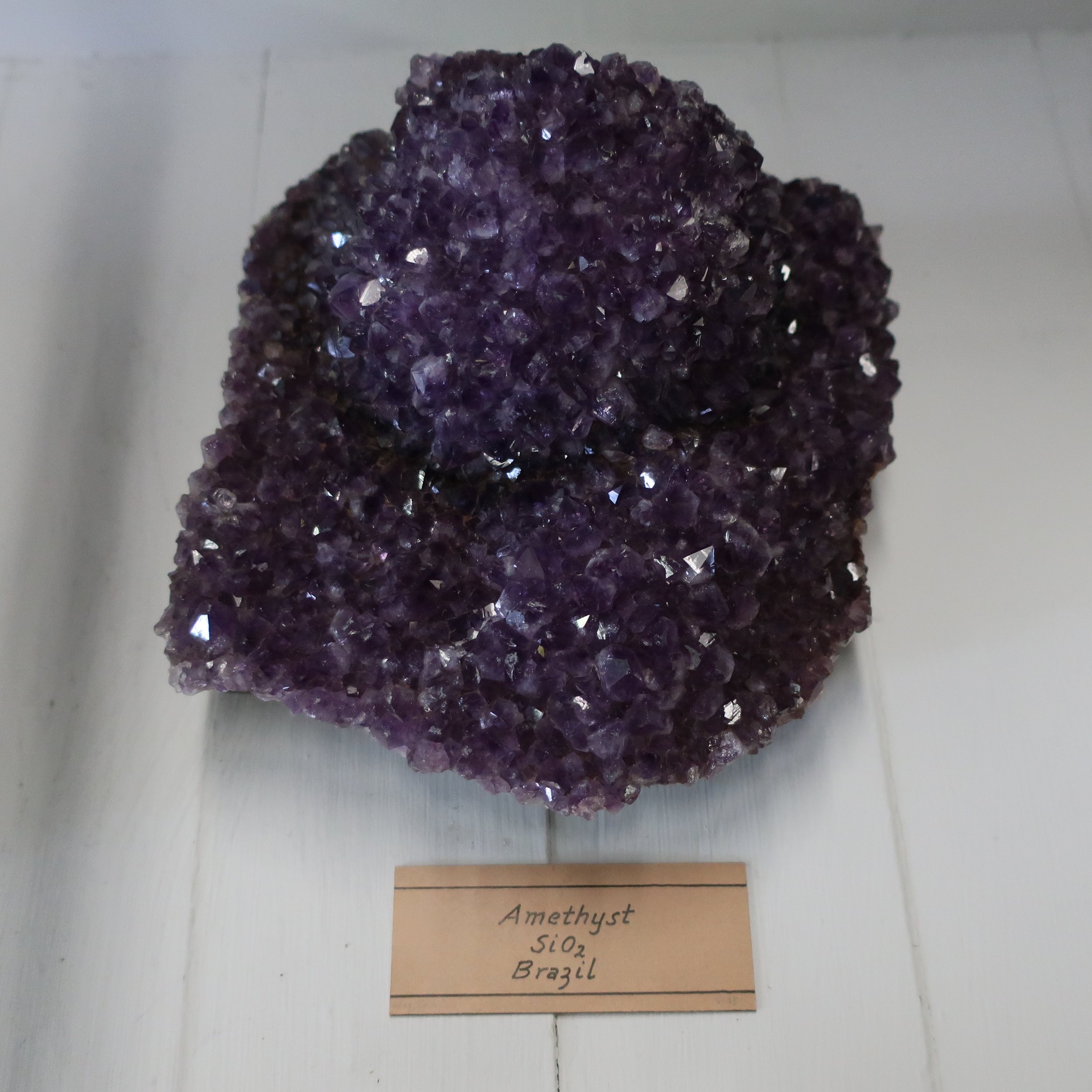
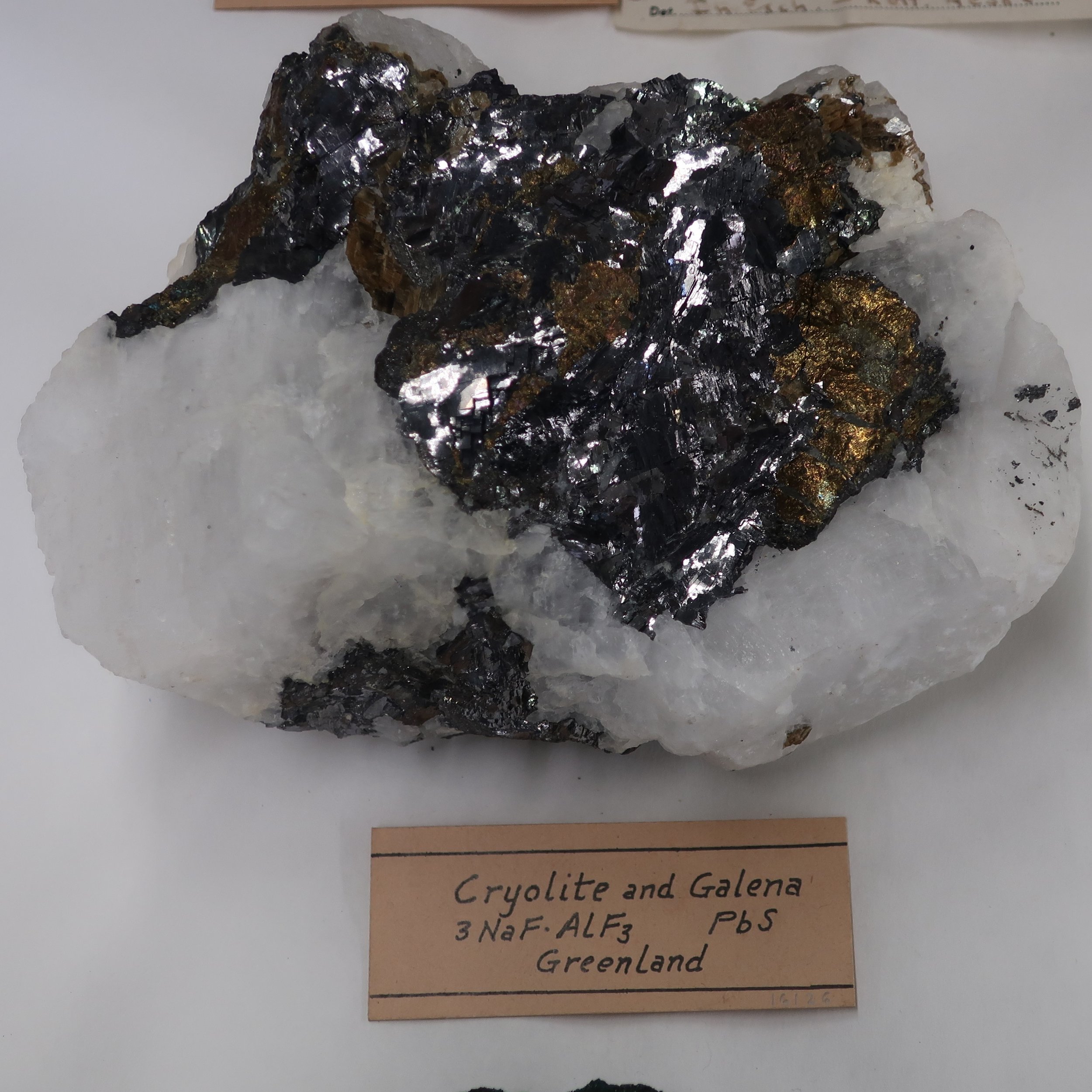
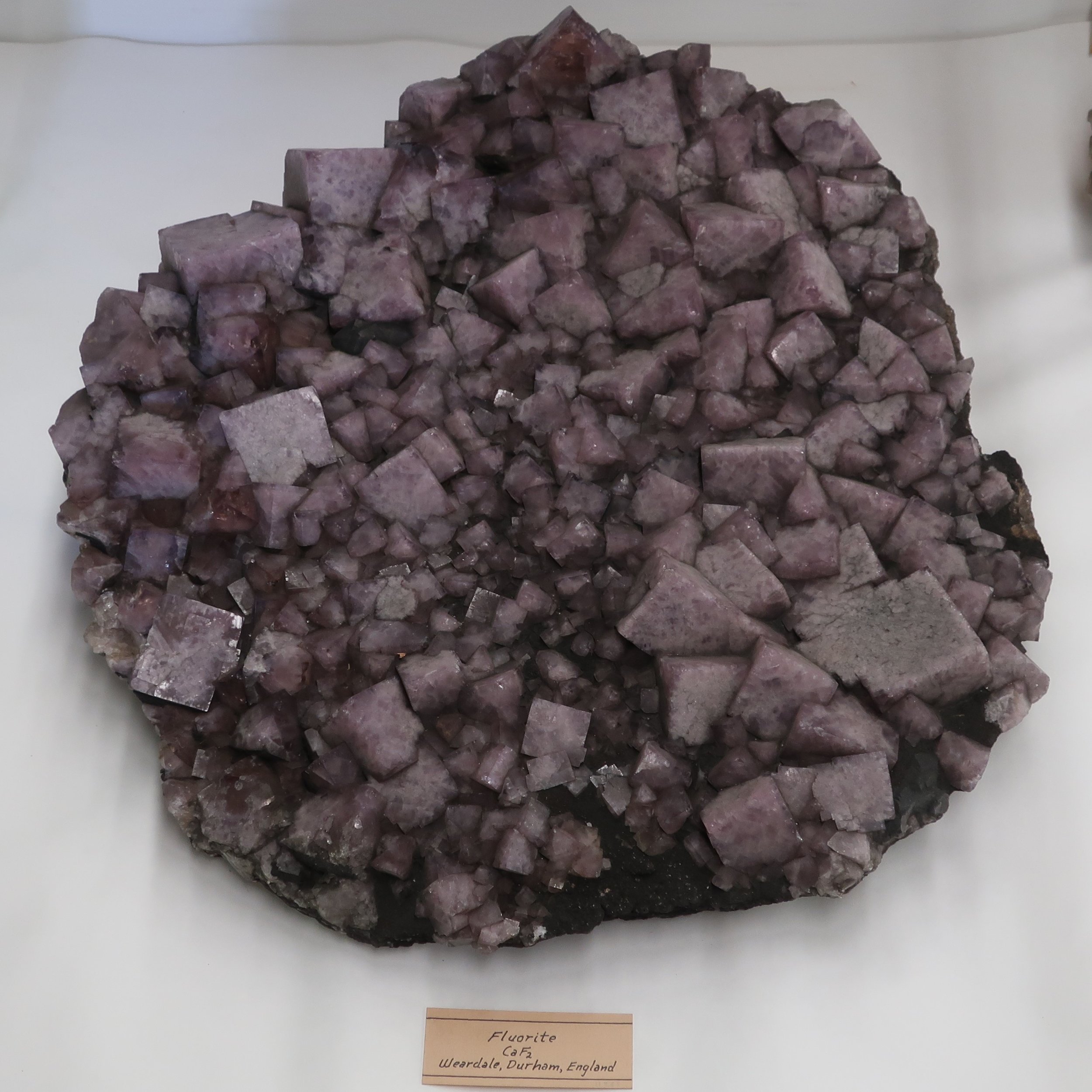
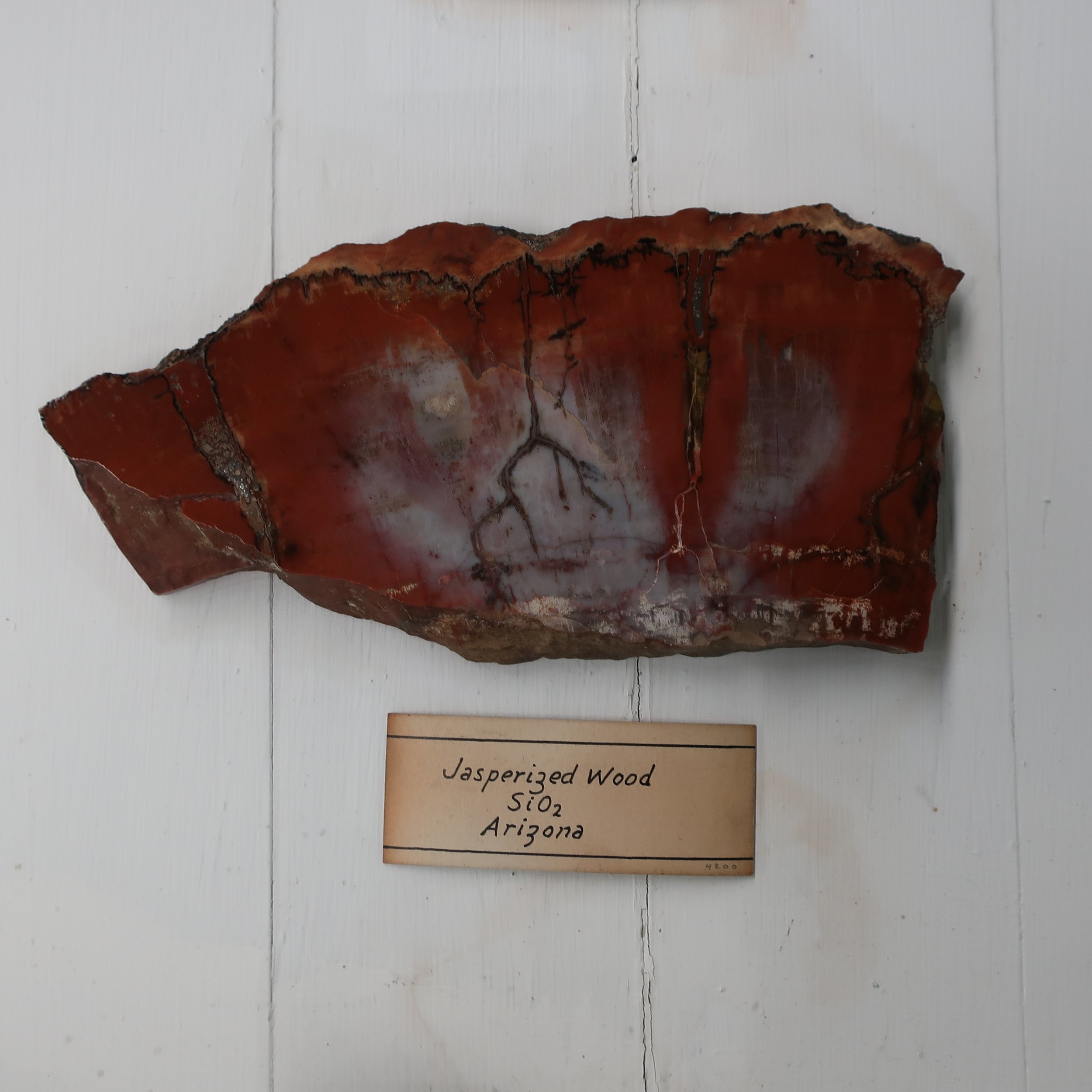
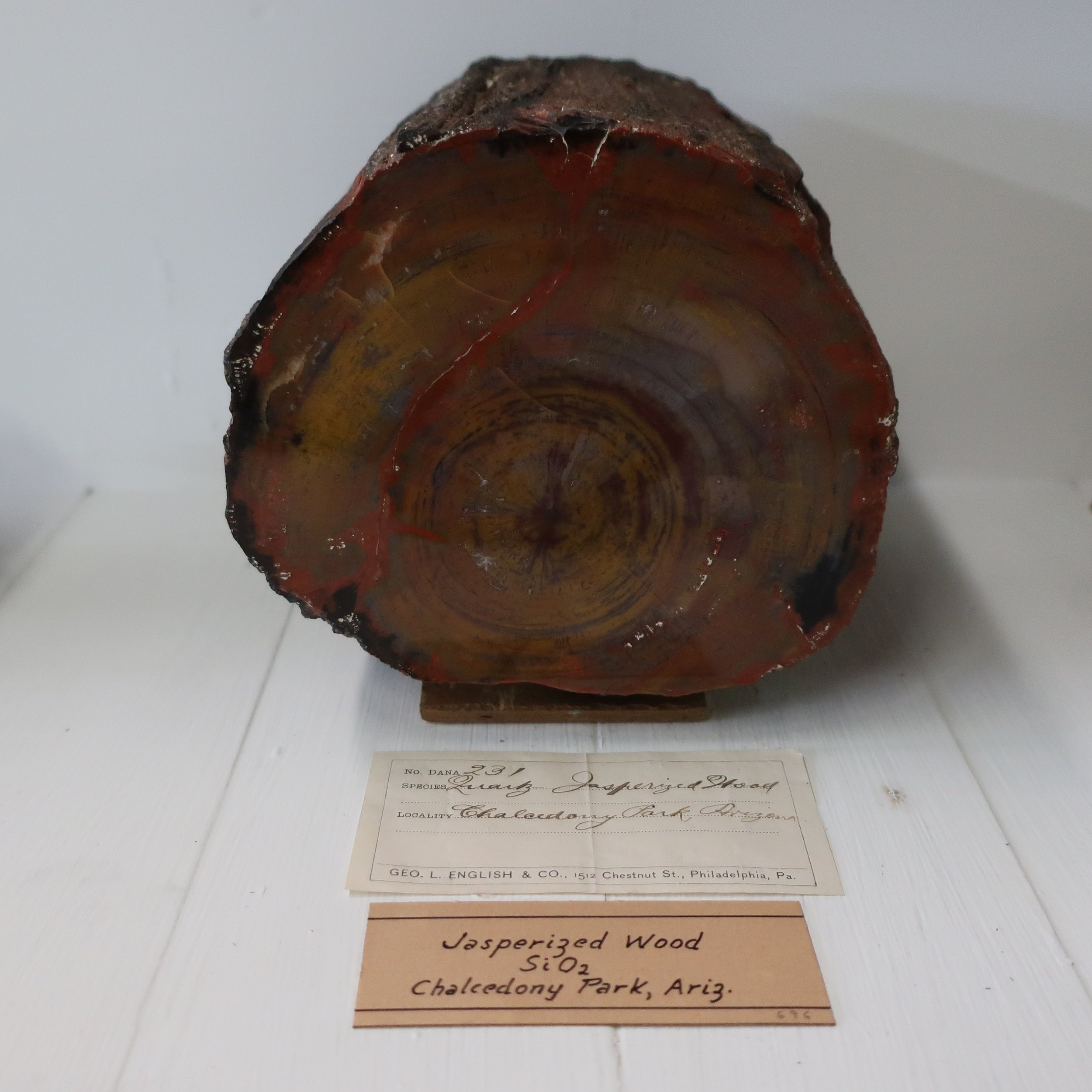
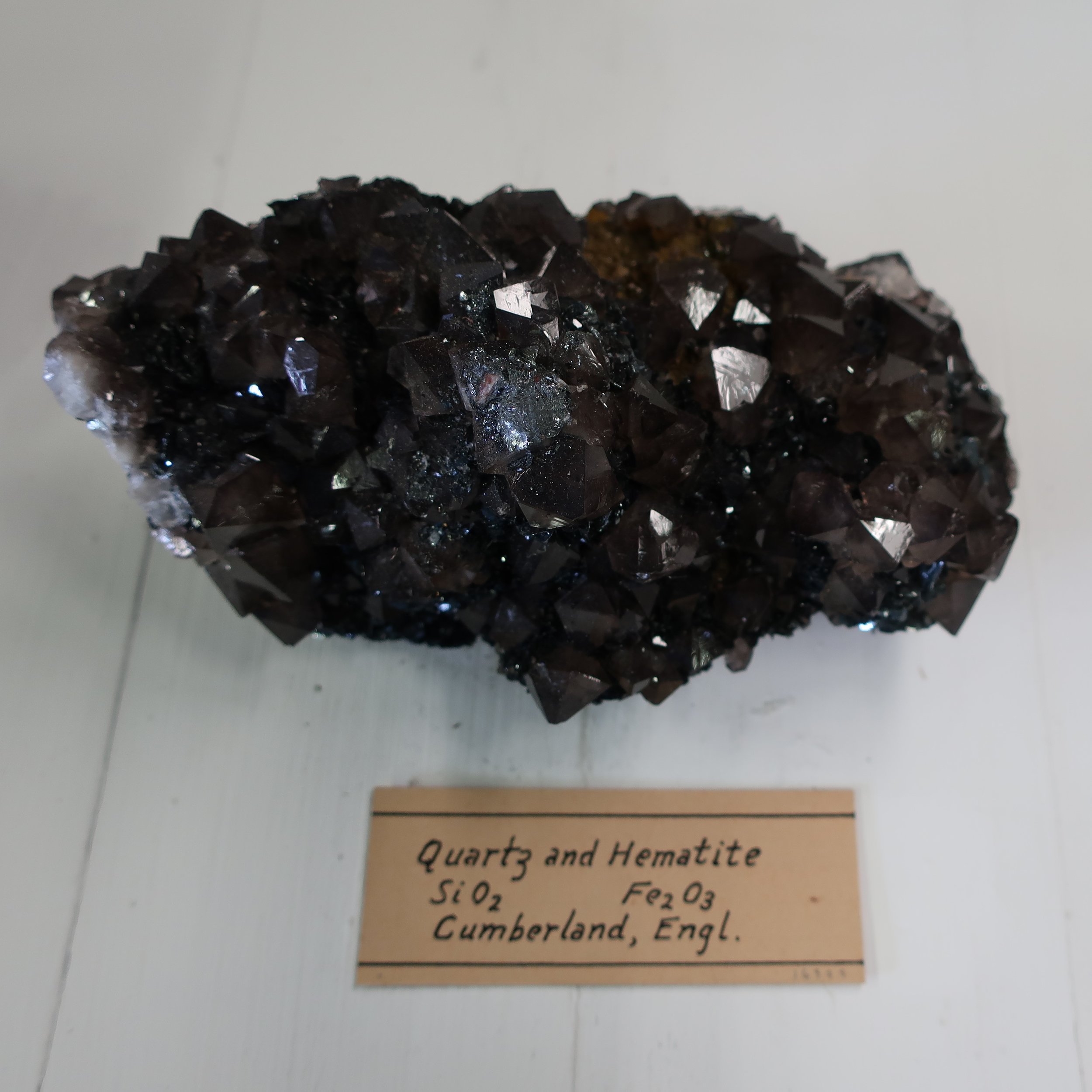

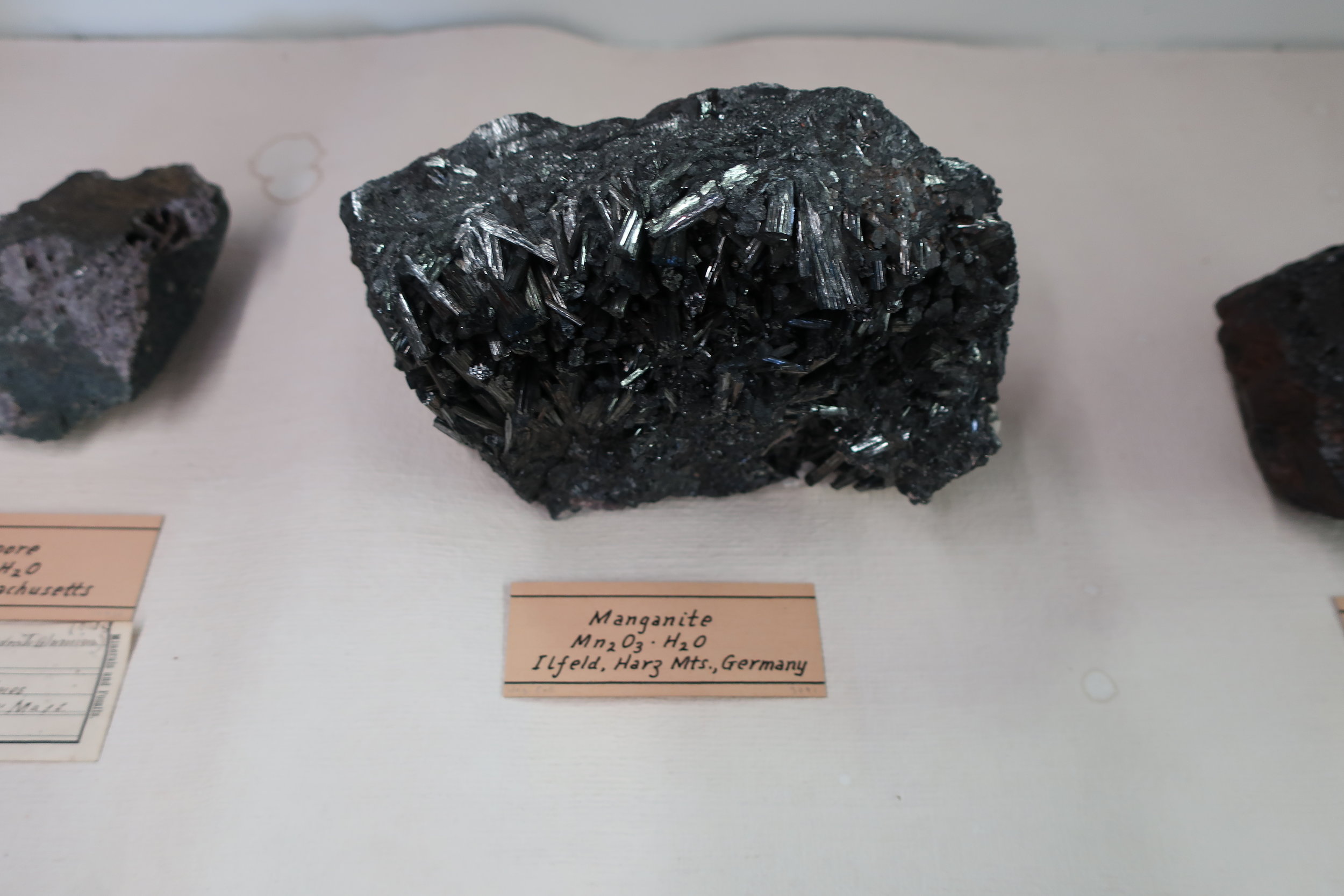
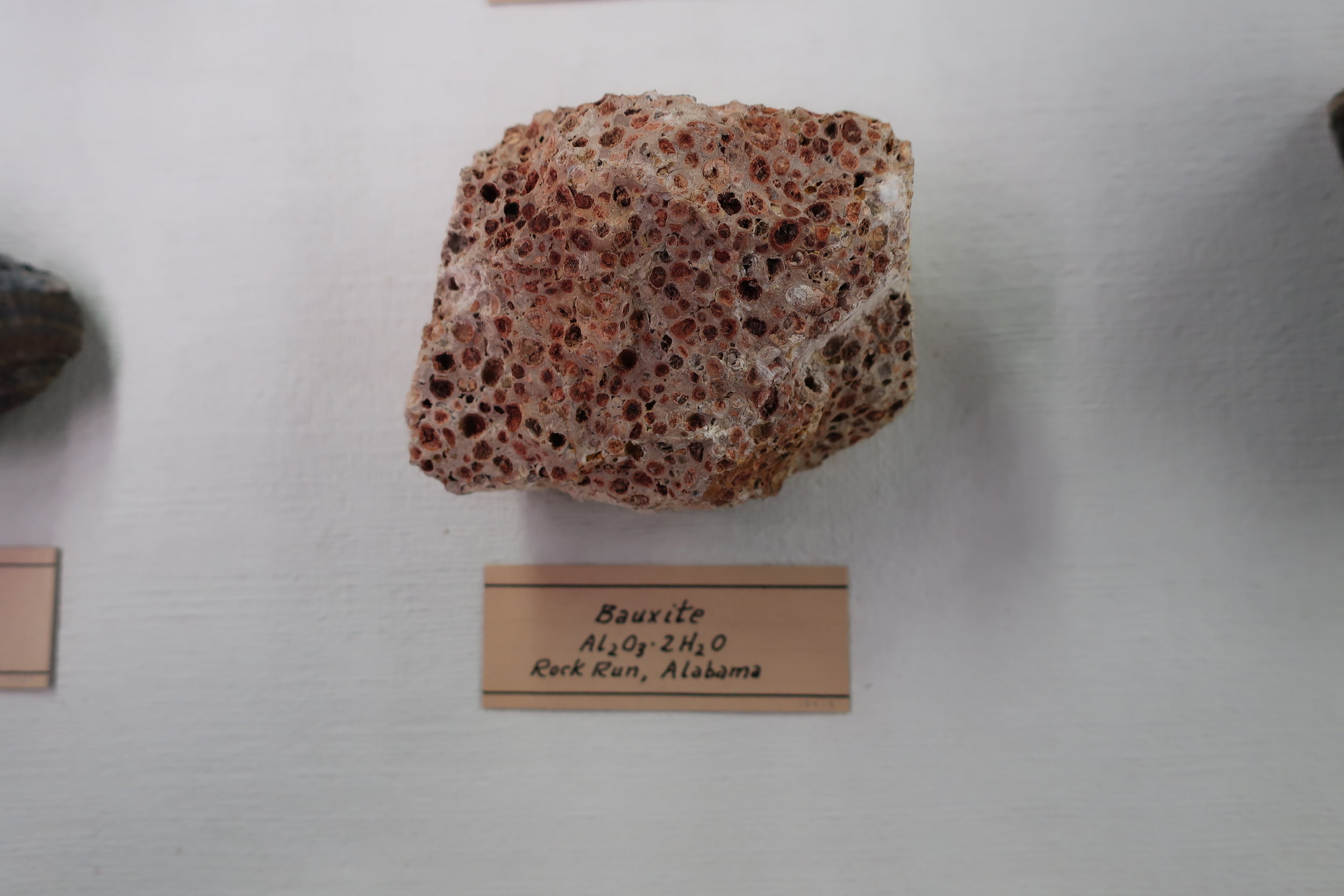
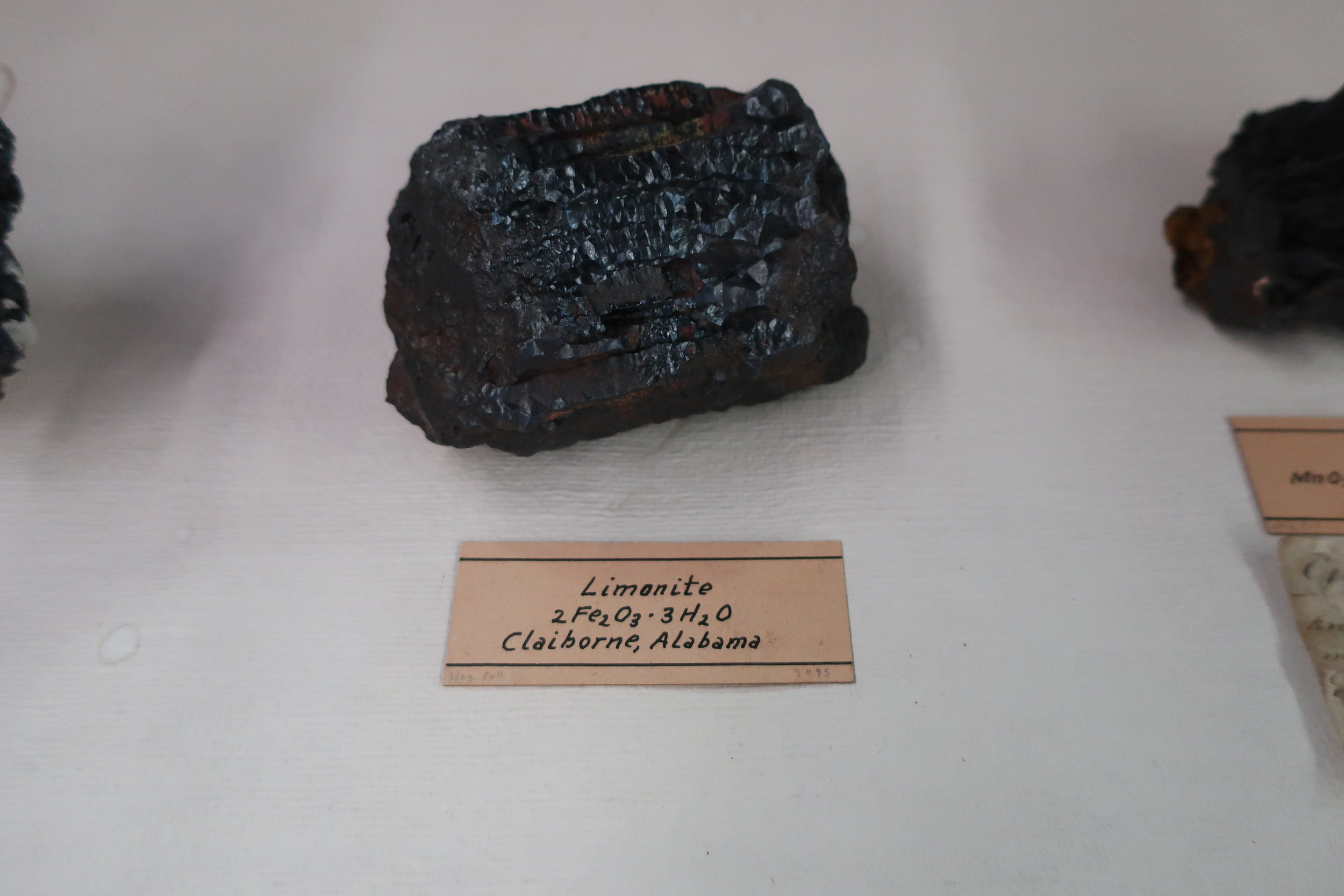
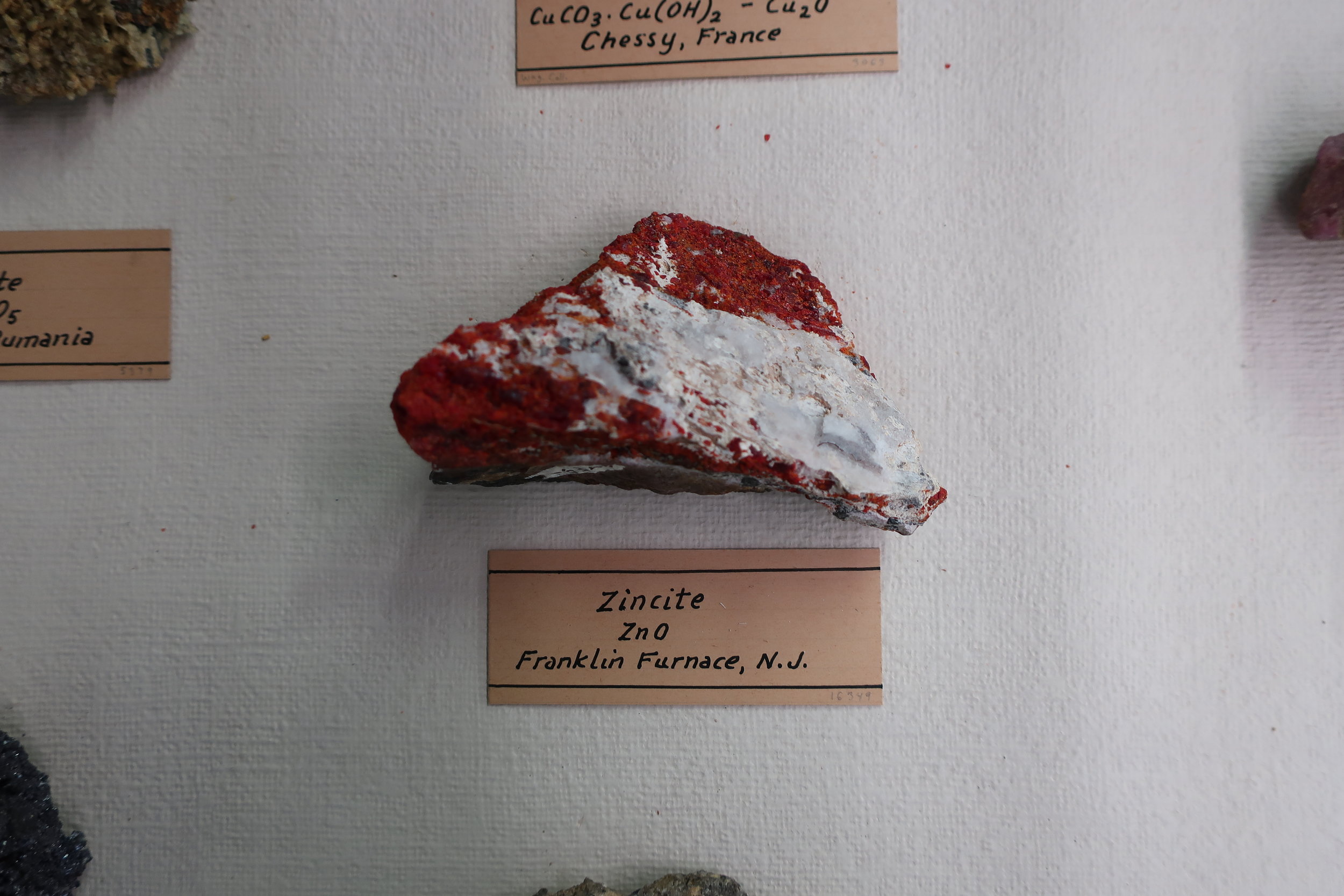
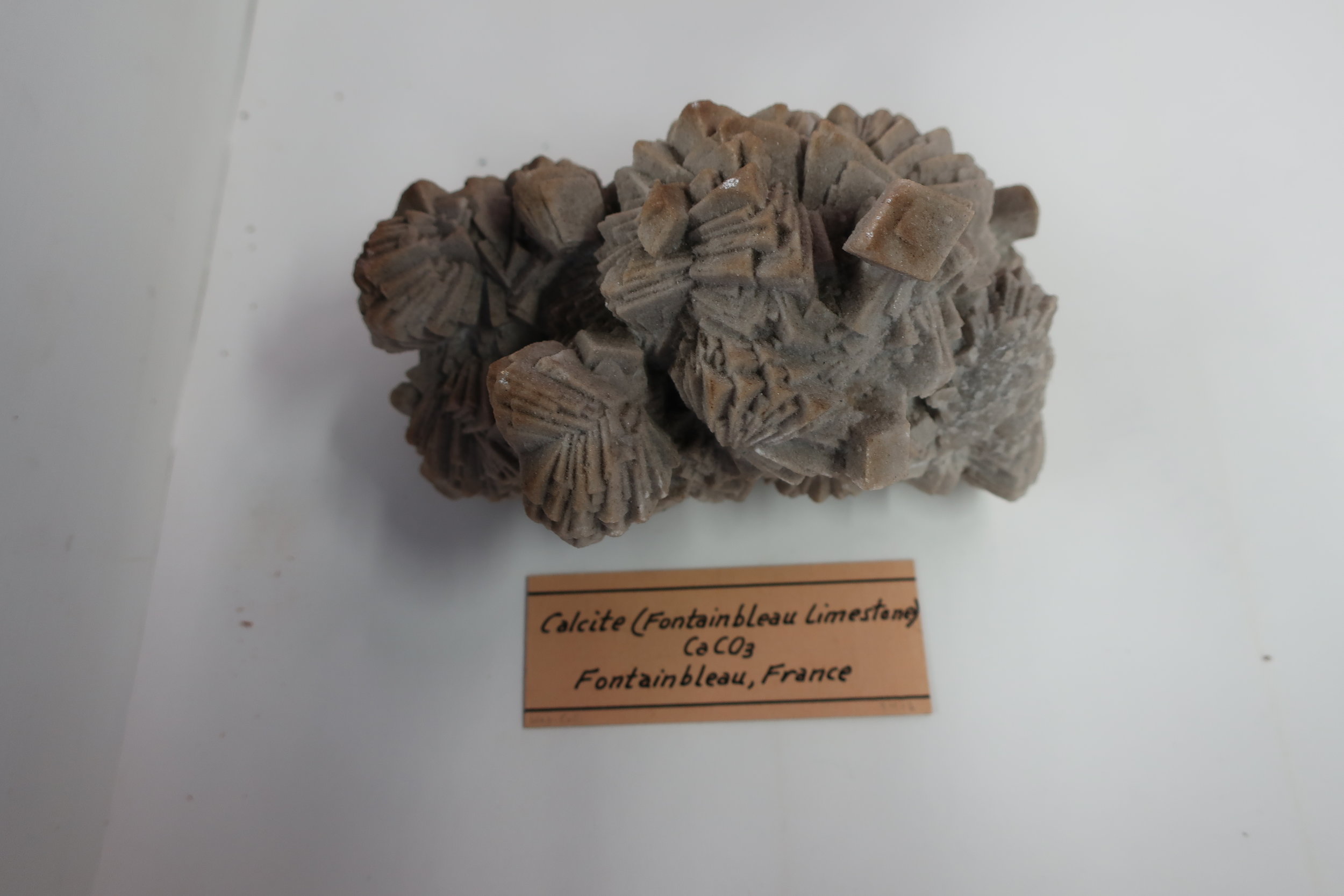
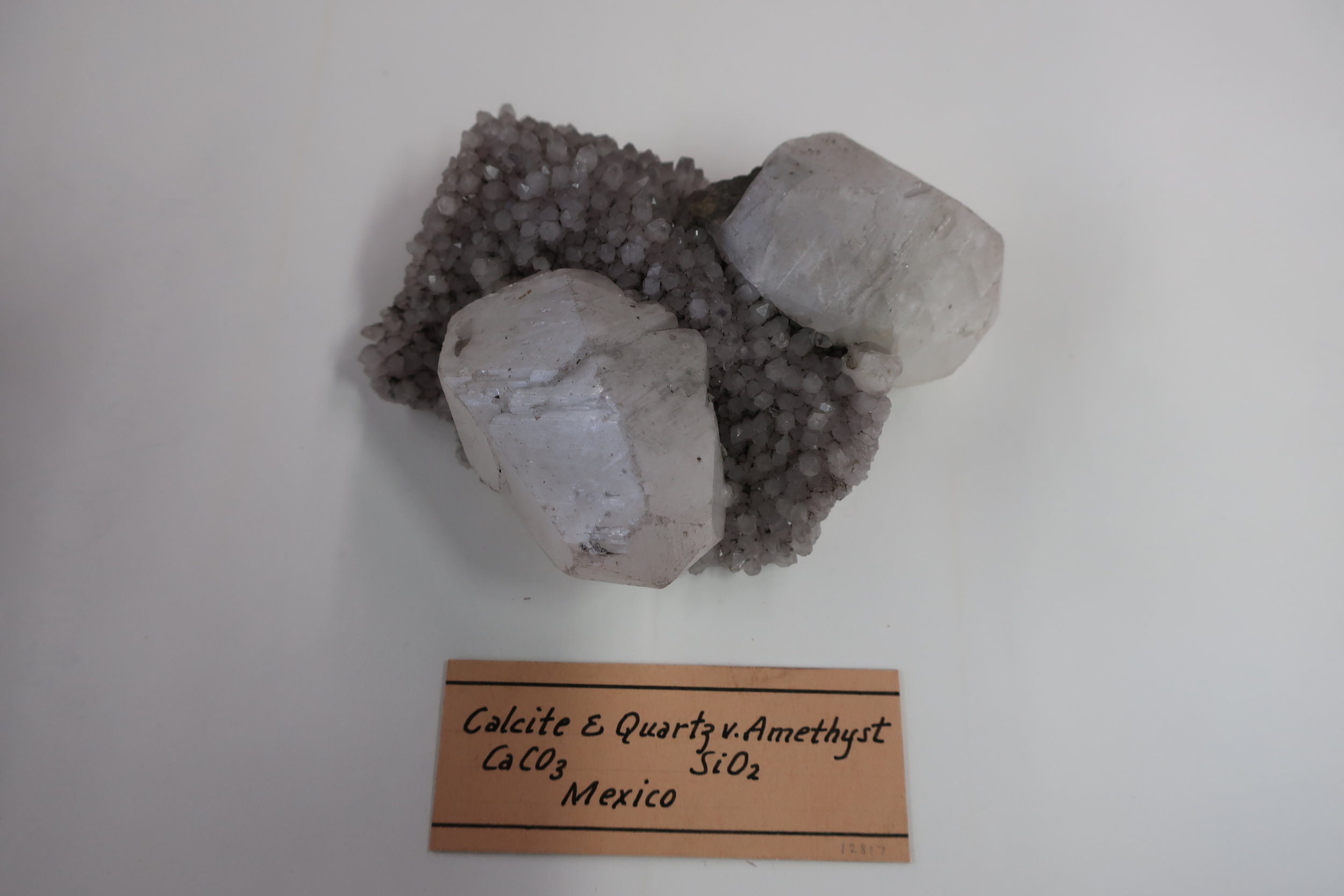
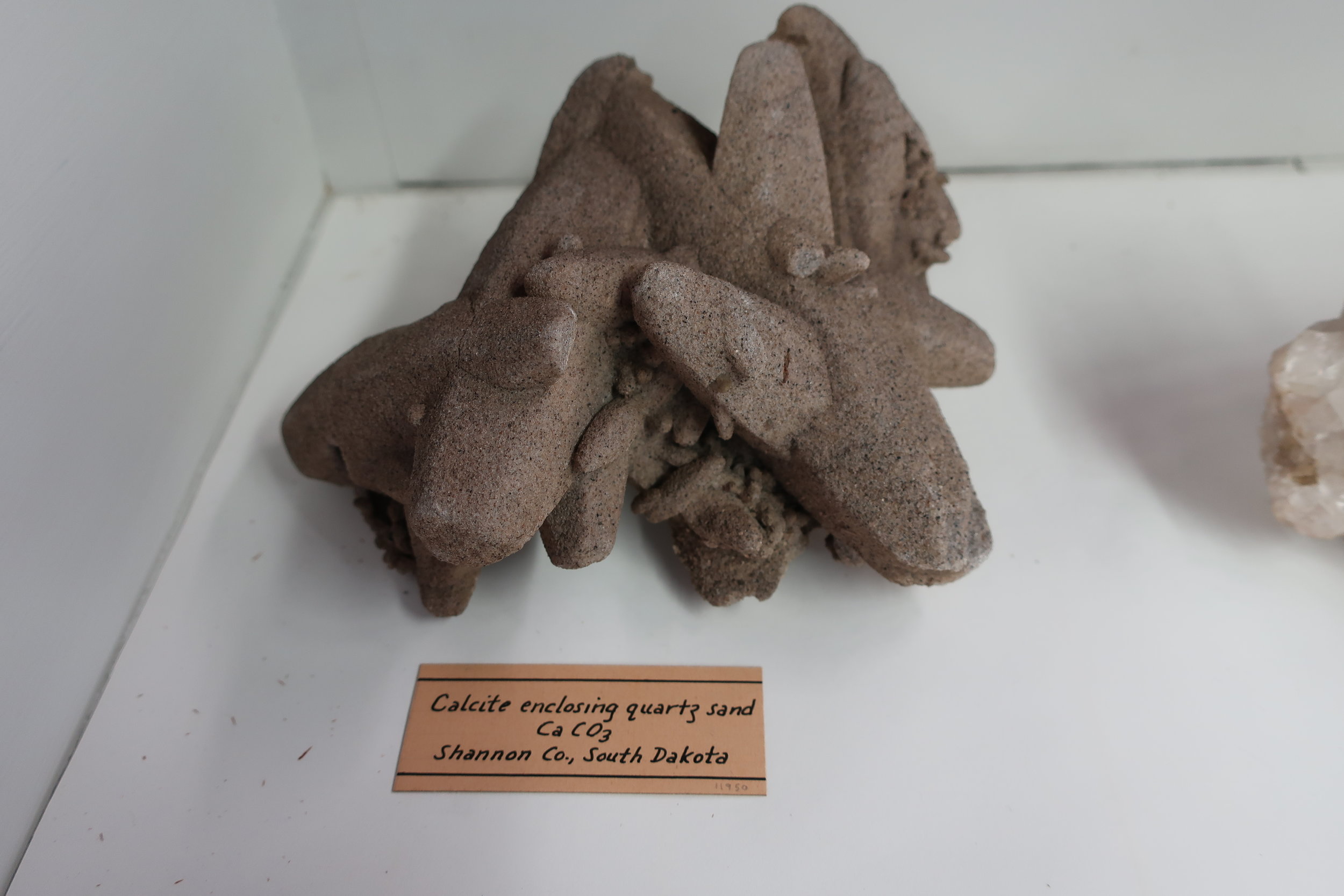
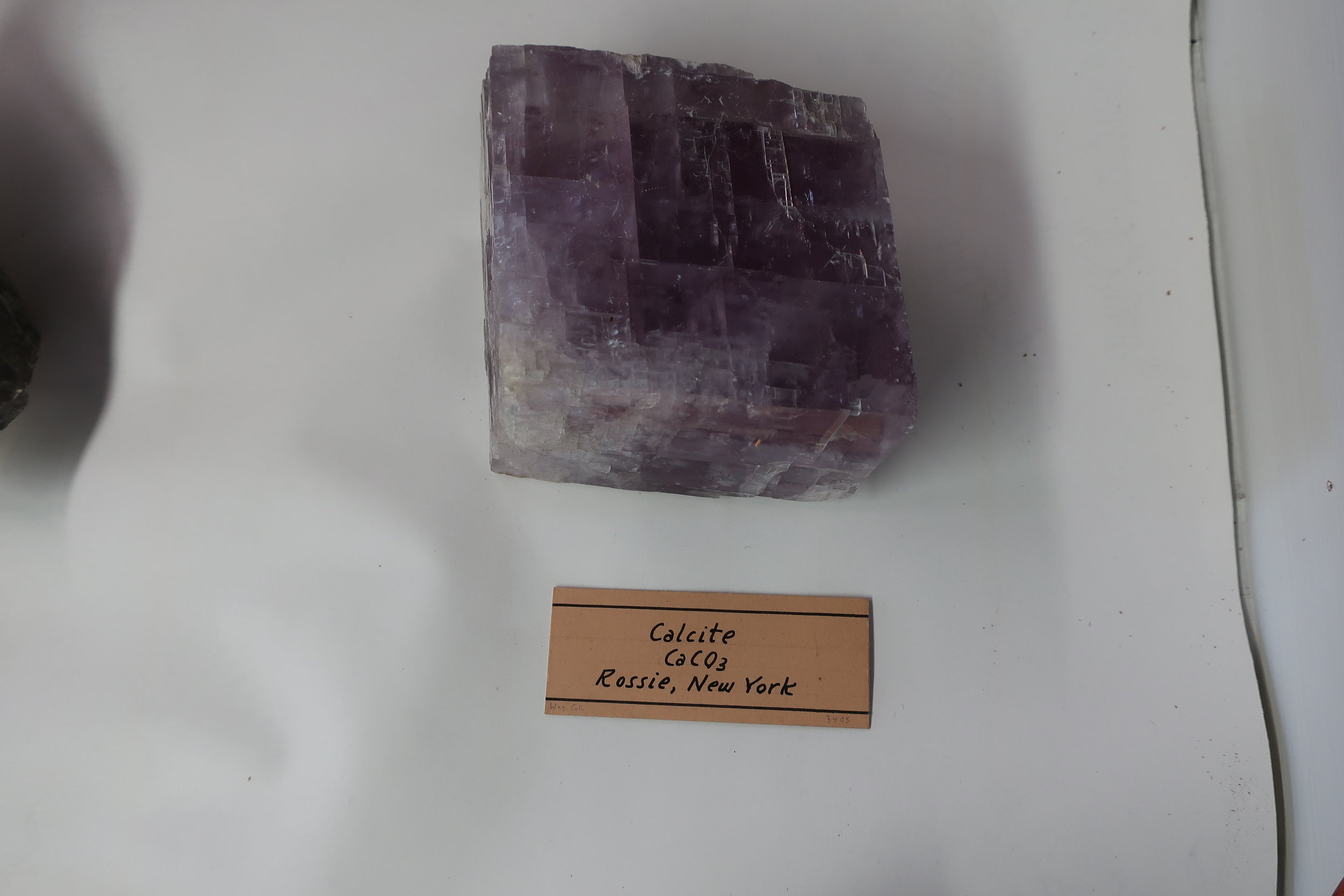
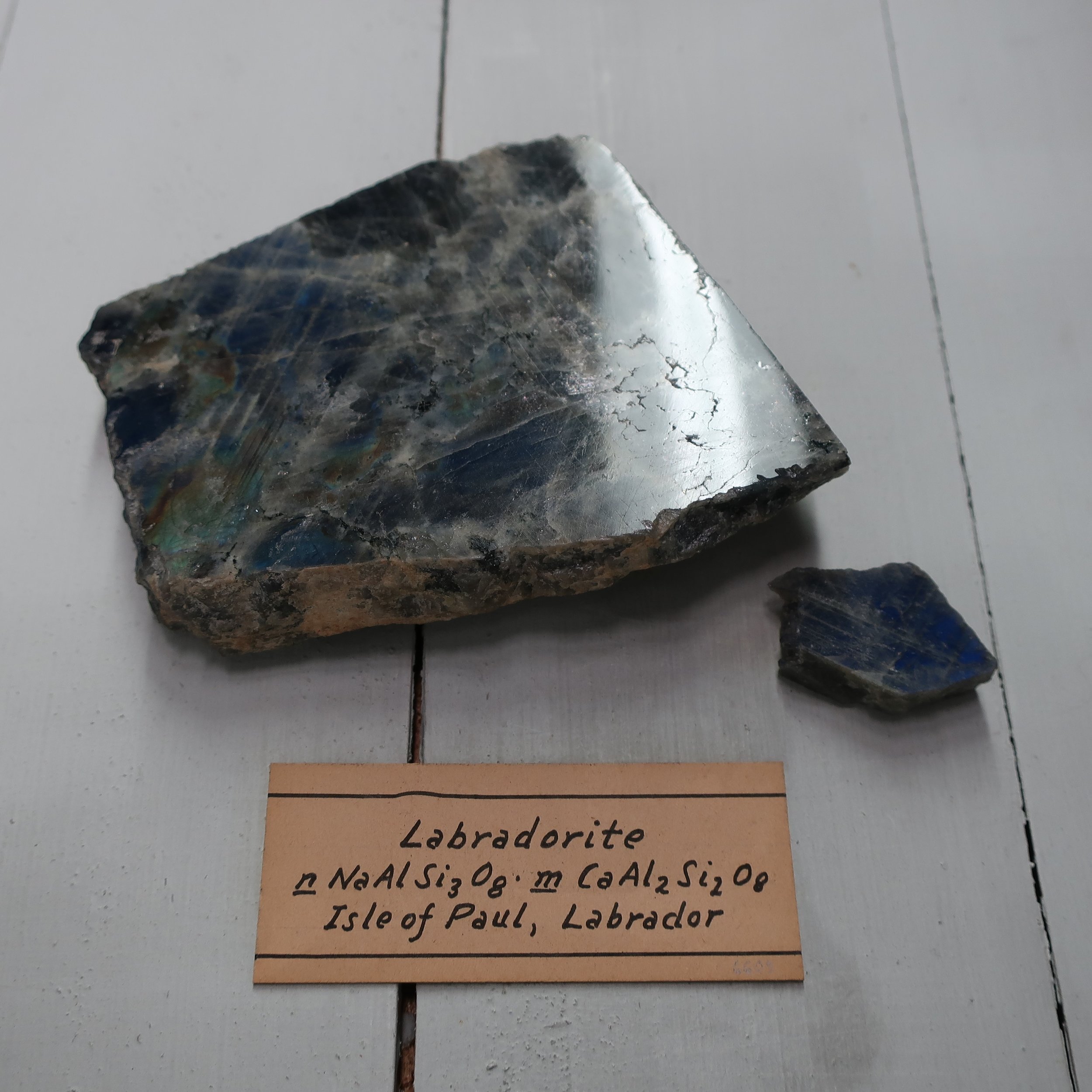
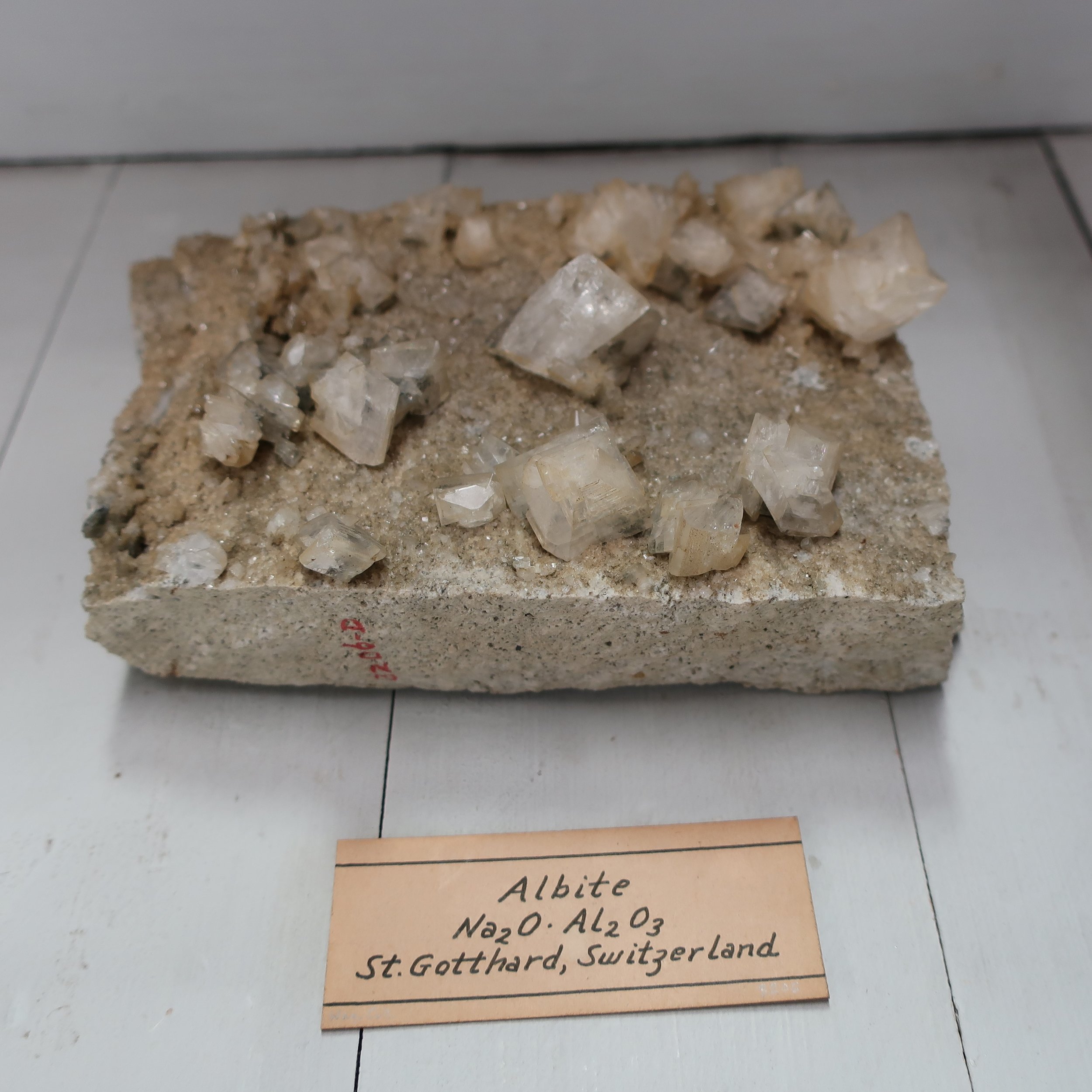
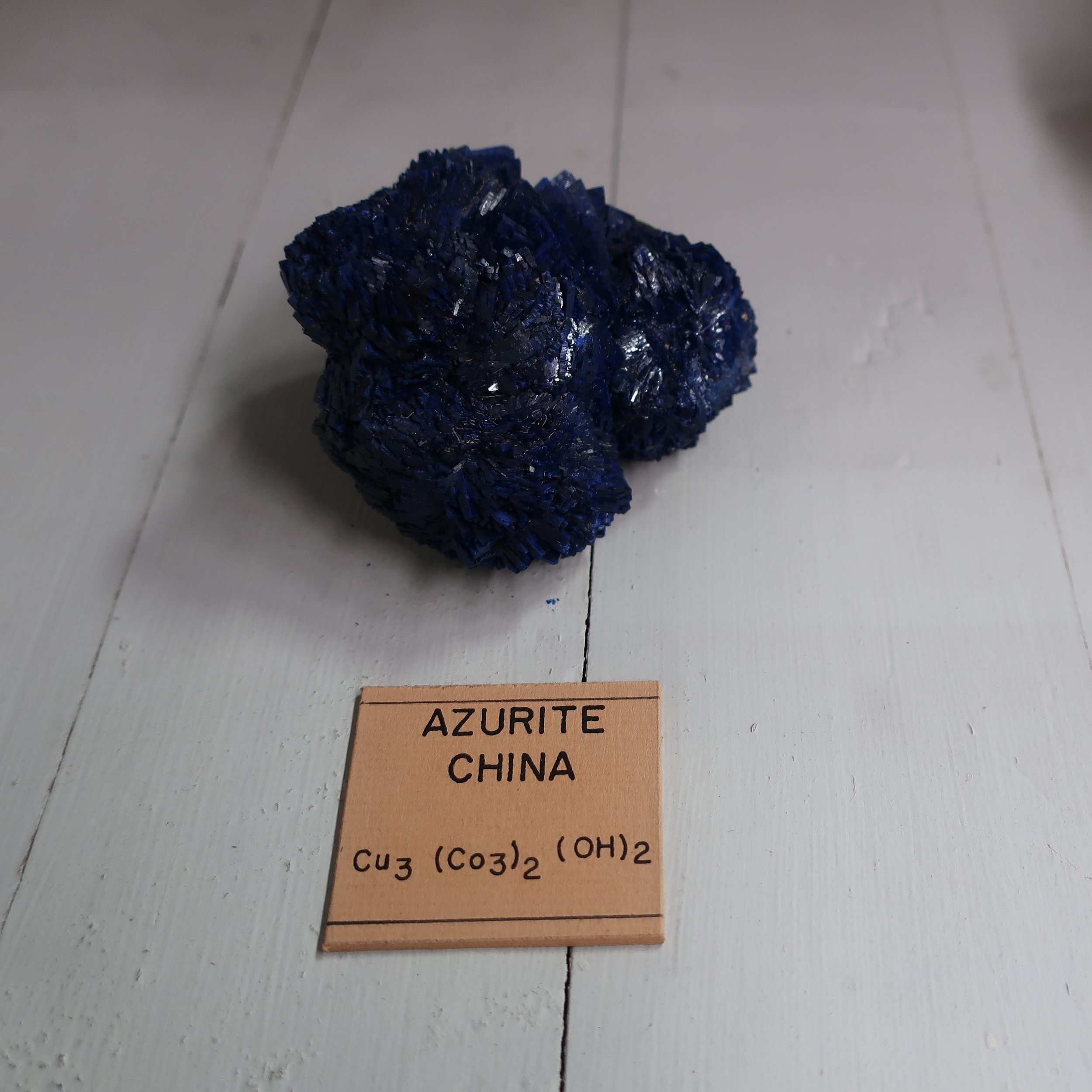
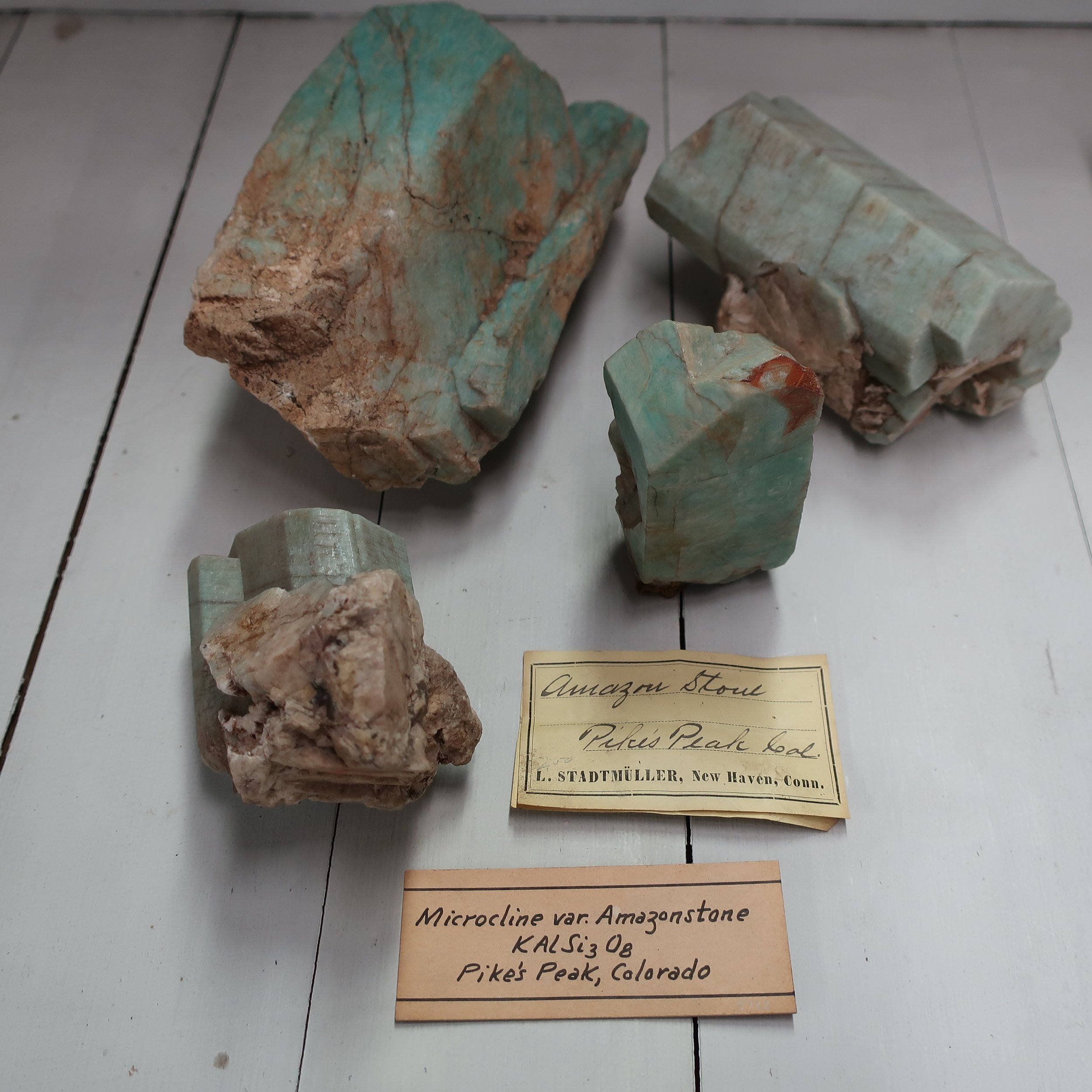
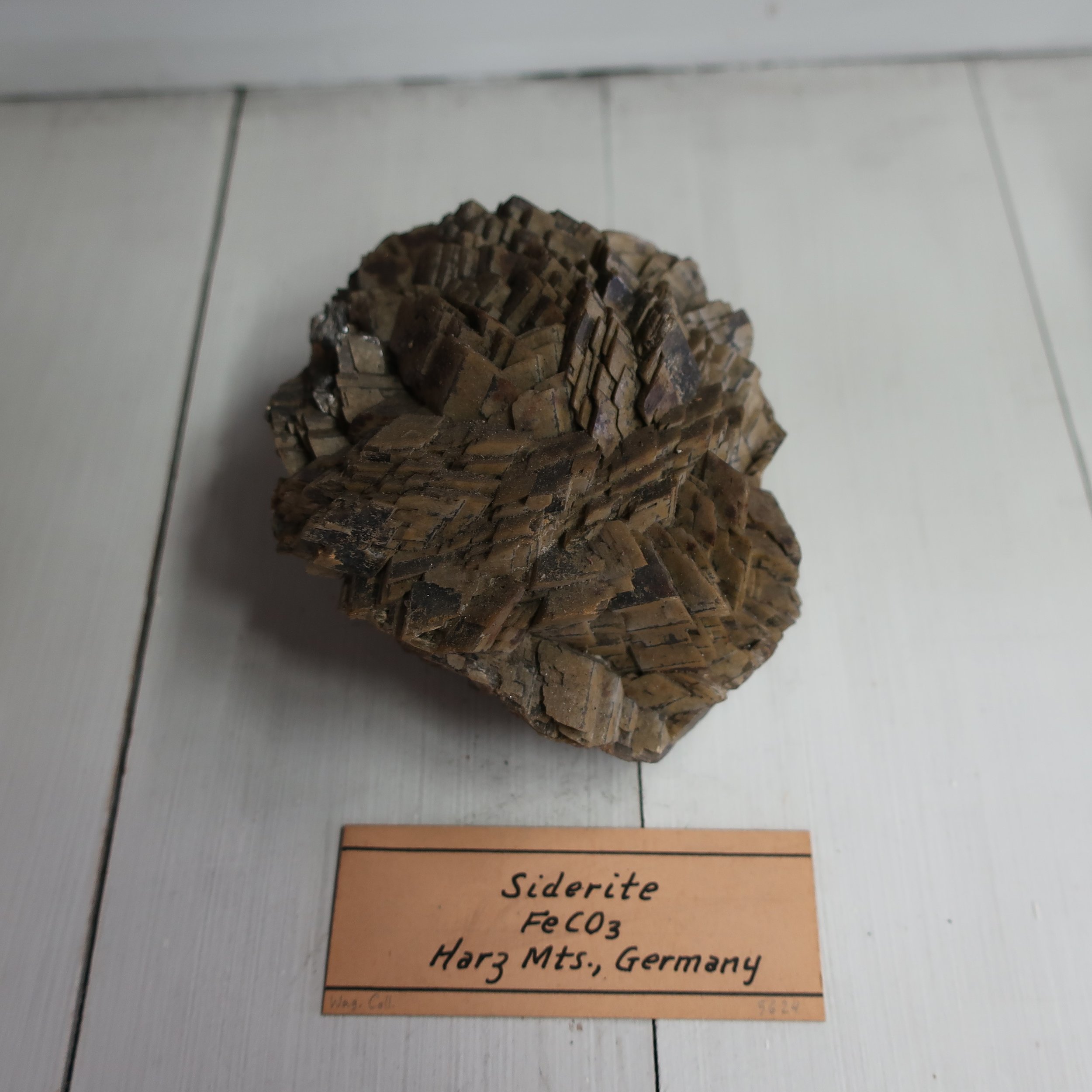


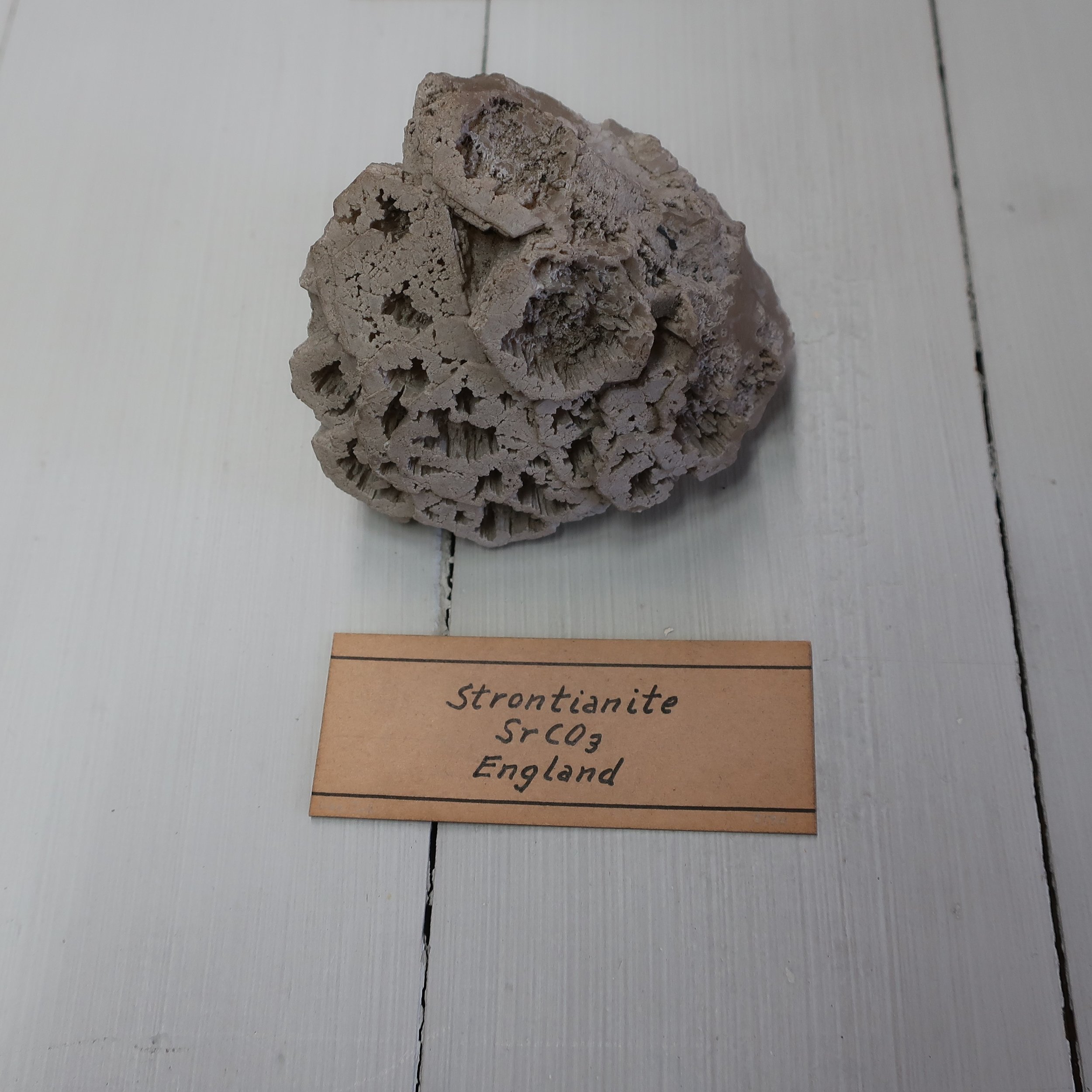
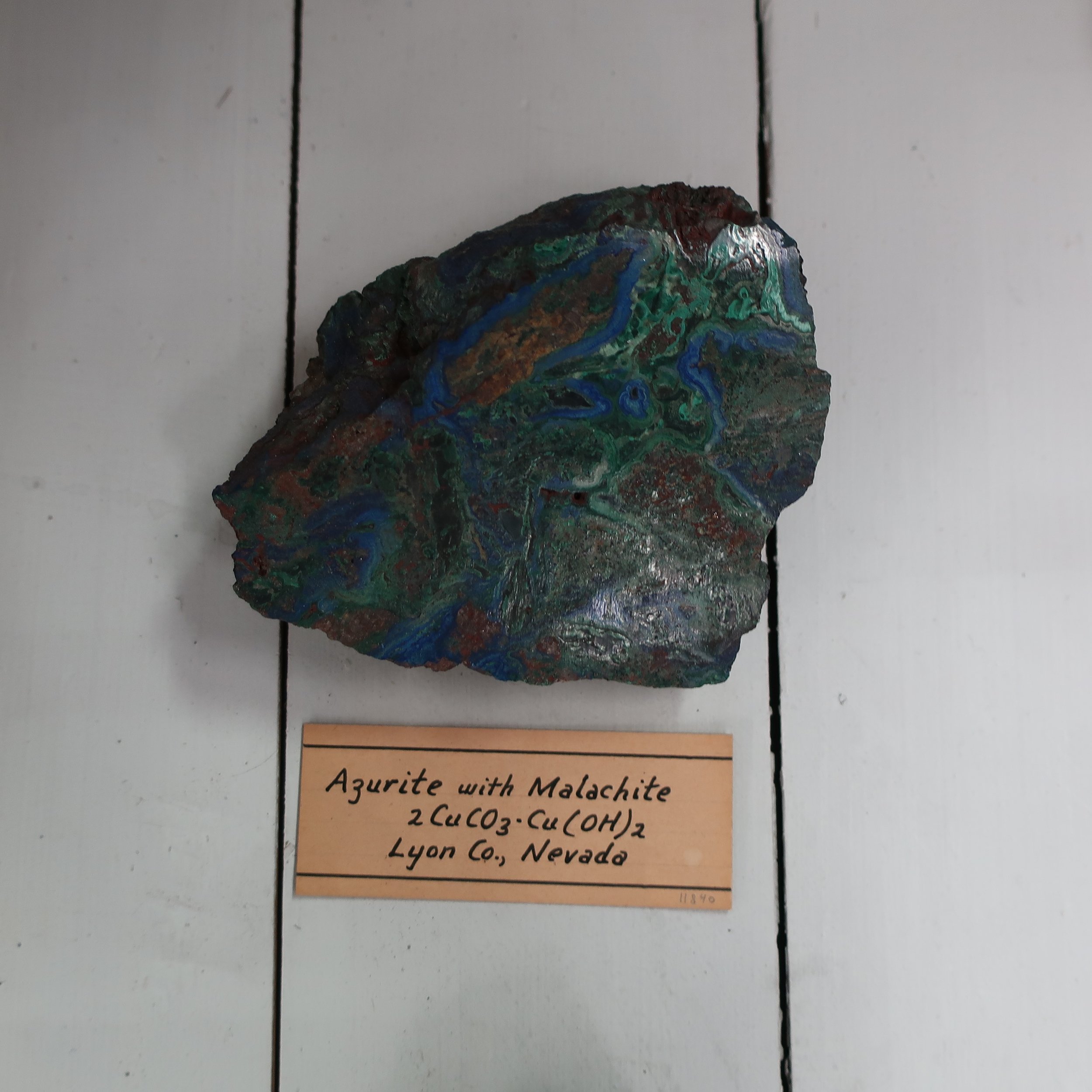

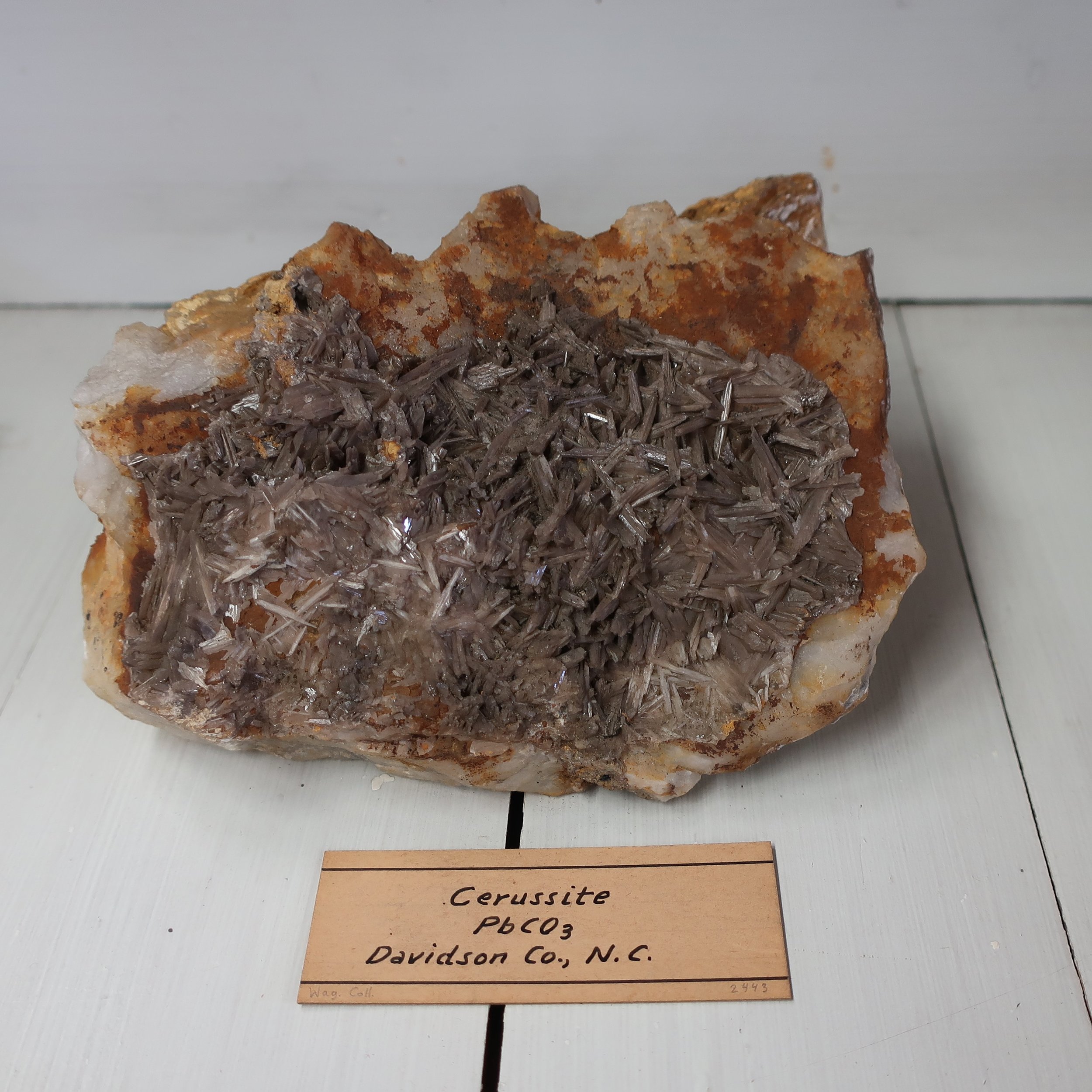
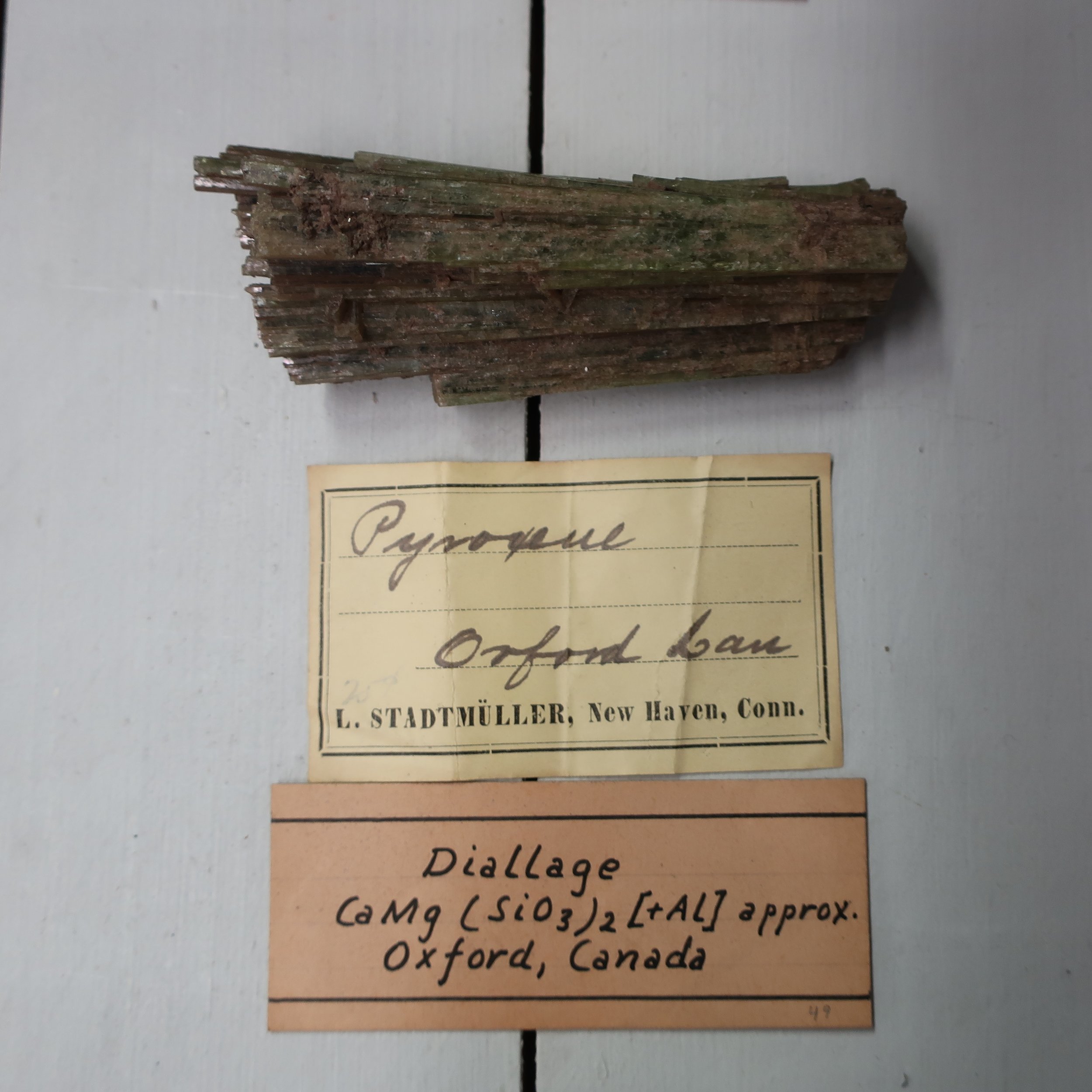
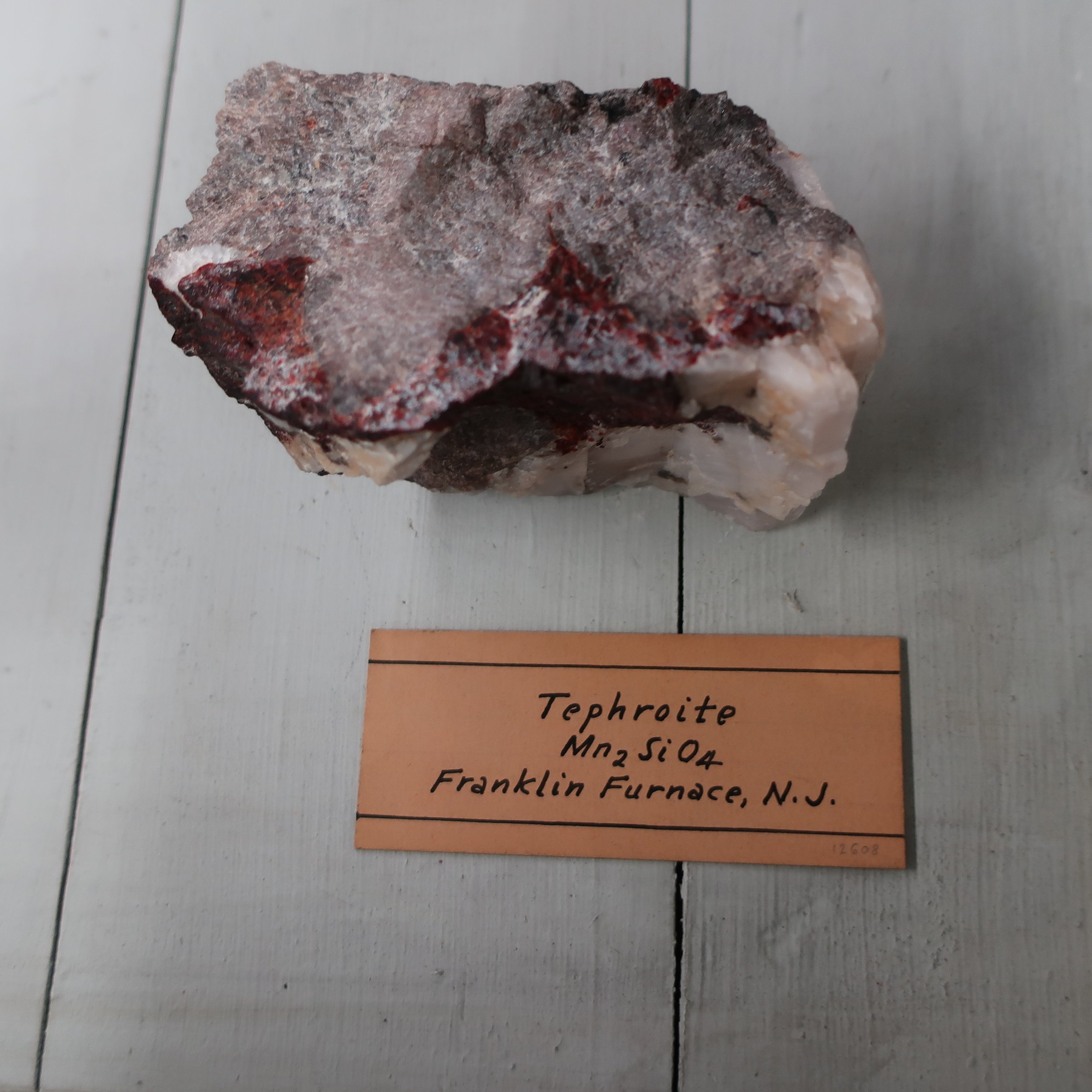
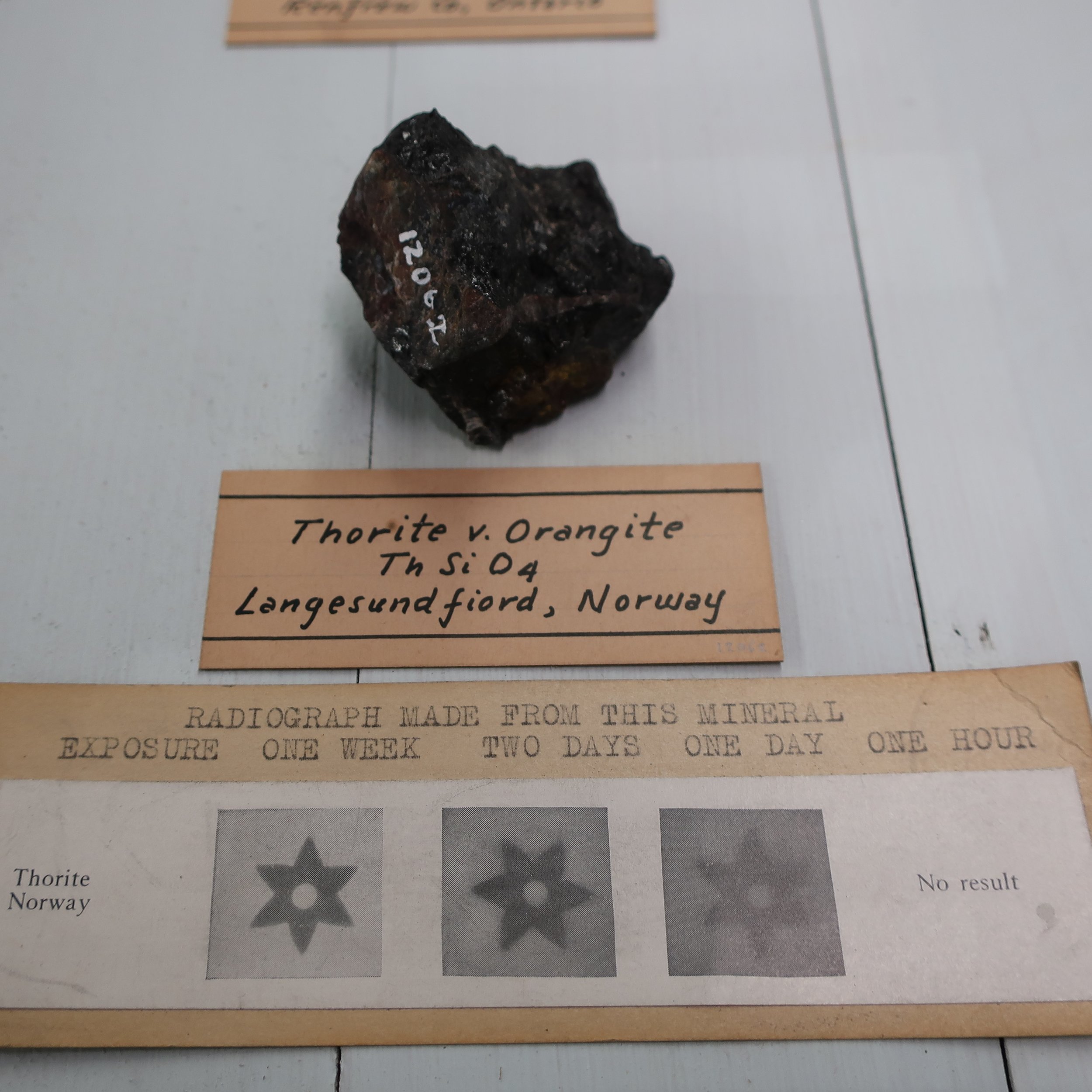
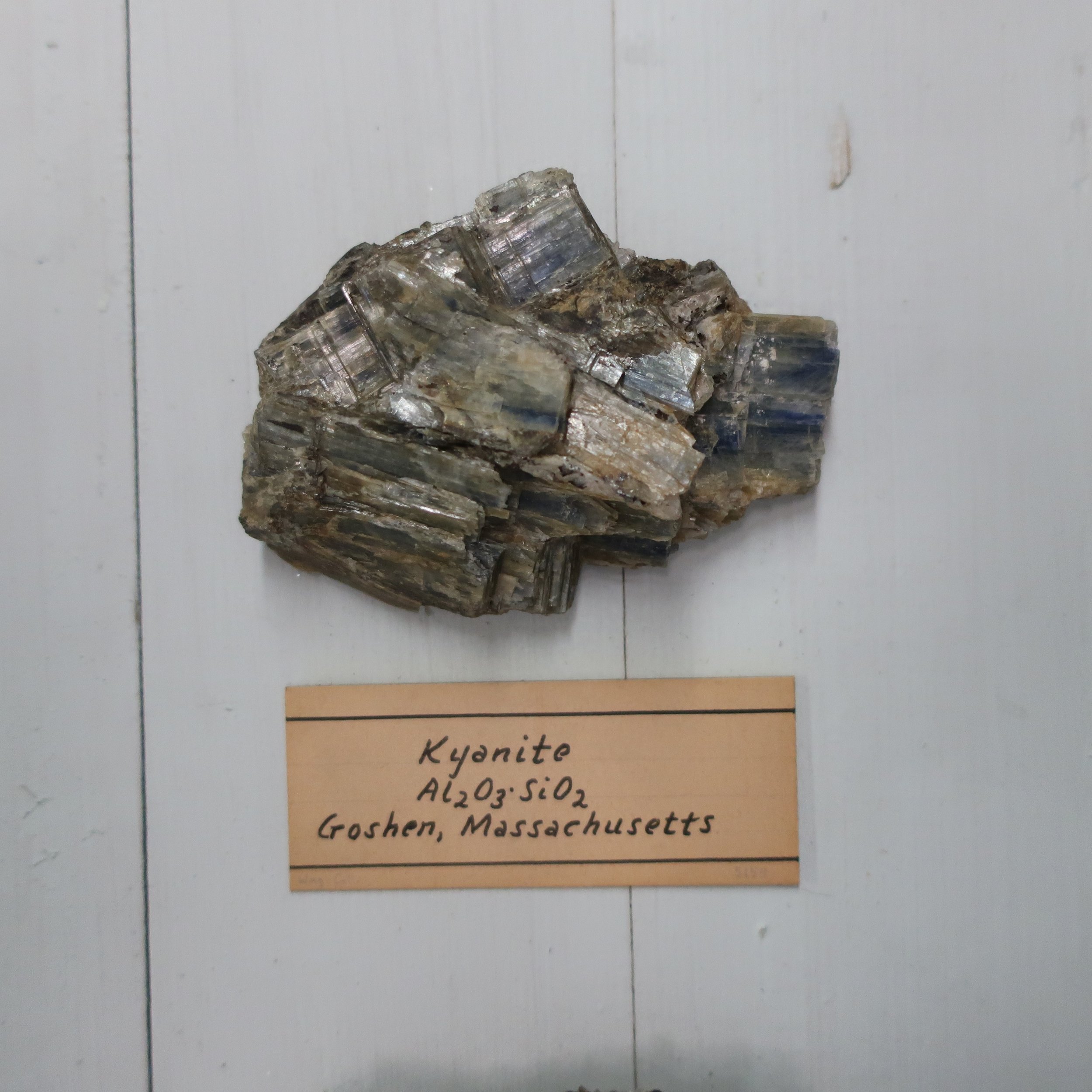
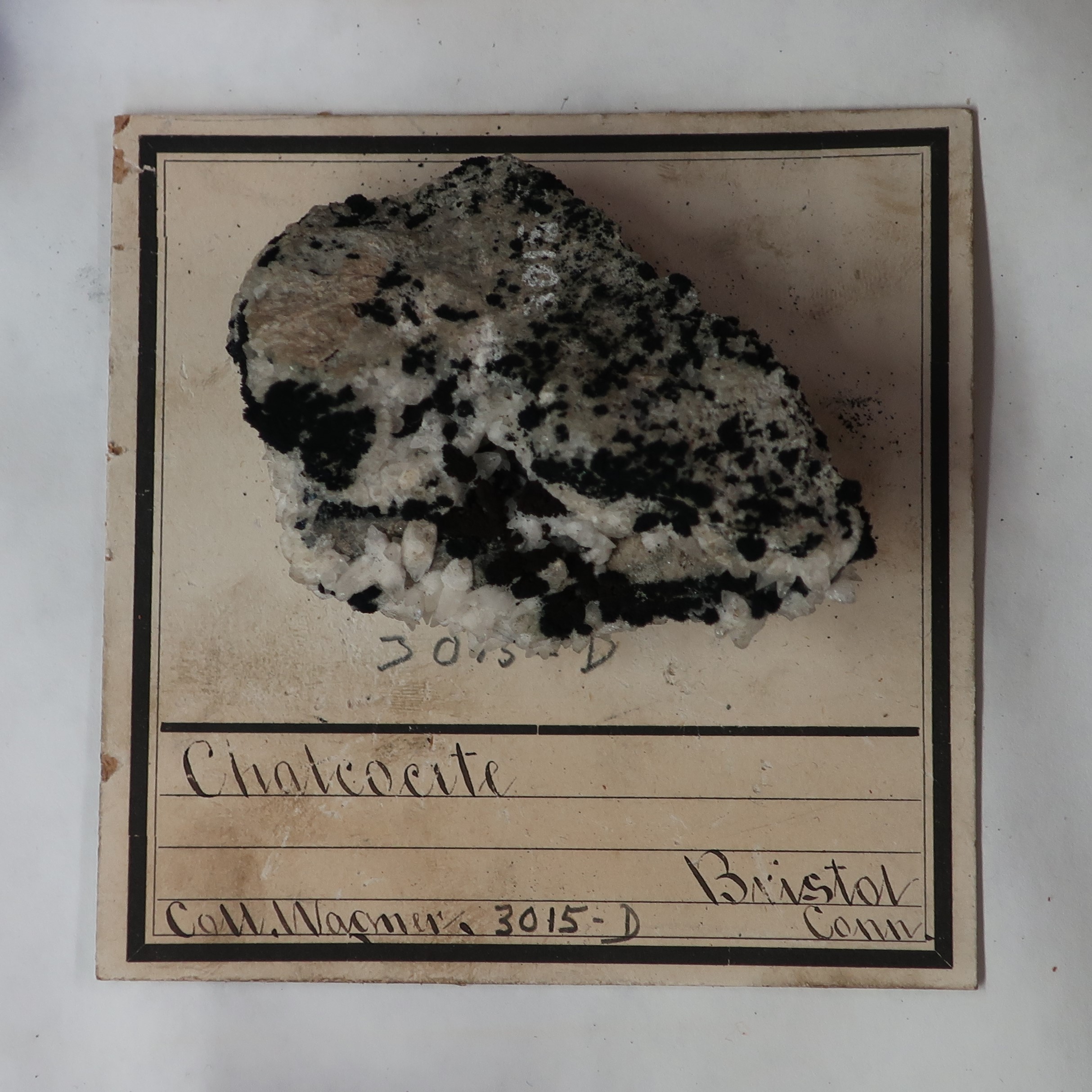
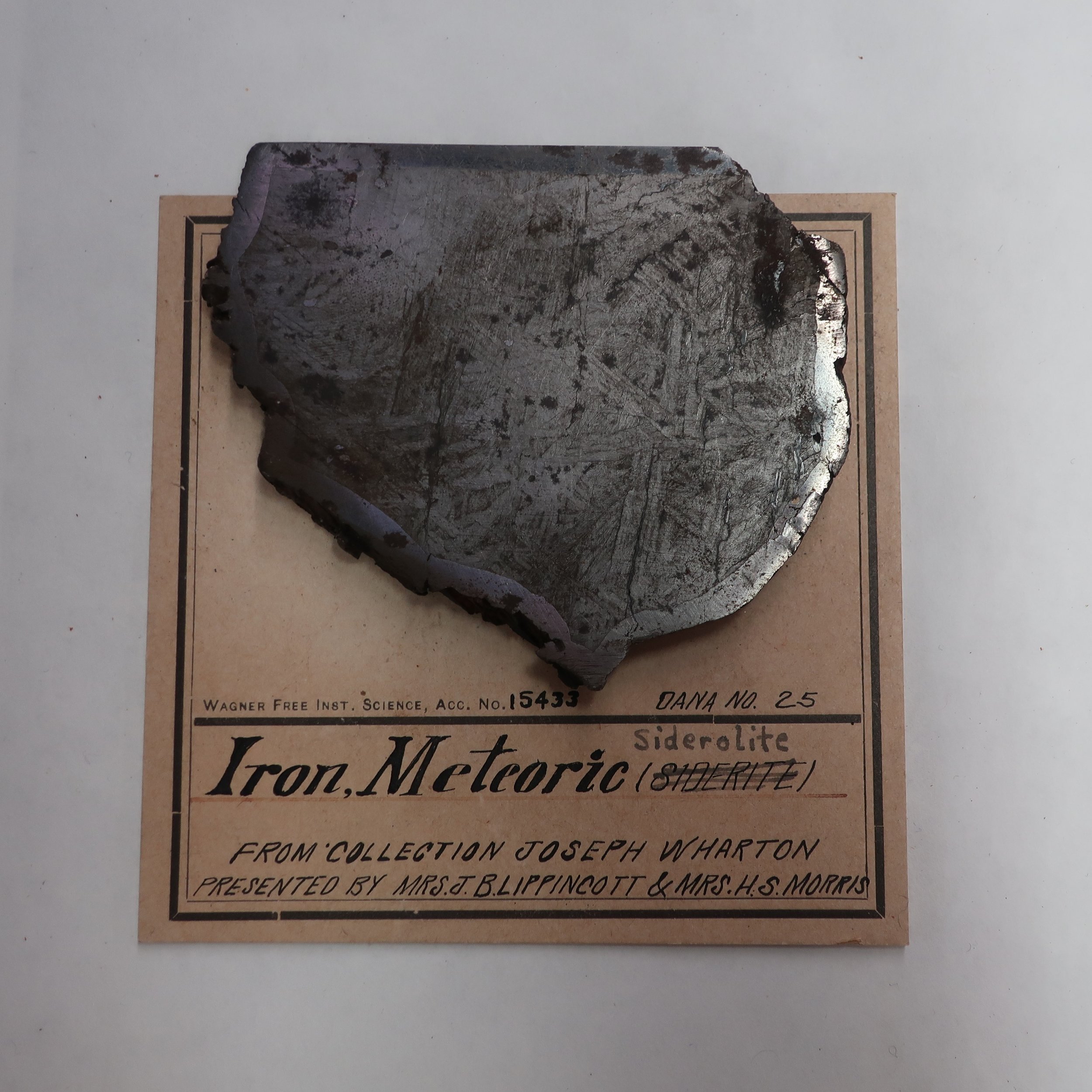

![“Ferruginous Quartz is opaque of several shades of yellow and red, occurs massive and crystalized. It consists chiefly of Silica and 5% of Iron.” [READ THE FULL QUARTZ ENTRY]](https://images.squarespace-cdn.com/content/v1/5b69b9bd4611a043ec05da32/1541014730446-A6XMD3XD8NM1ZR9CMO64/Ferruginous+Quartz.jpg)
![“Milk Quartz occurs massive, and is only distinguished by its colour. As its name denotes, it presents a milky aspect.” [READ THE FULL QUARTZ ENTRY]](https://images.squarespace-cdn.com/content/v1/5b69b9bd4611a043ec05da32/1541014734857-BZHVWUHJTTCR7WH3K03S/Milk+Quartz.jpg)



![“Chrysoprase is [a variety of chalcedony] of an apple green colour, translucent & massive. It loses its colour before the B.P. and infusable without addition, it contains of silica 96.16, nickle 1, Lime, alumine & Iron 3. It is the nickle](https://images.squarespace-cdn.com/content/v1/5b69b9bd4611a043ec05da32/1541016570735-0O931QQN392D90397AZ8/Chrysoprase.jpg)

![“In a chemical point of view, [ Common Jasper] only differs from agate in containing a larger portion of Iron. It is readily distinguished by its opacity; its prevailing colours are yellow, red, and brown. It has often a resinous lustre, but it is](https://images.squarespace-cdn.com/content/v1/5b69b9bd4611a043ec05da32/1541016953077-NIWQ8Q4O06LZK7Q7OTAC/Jasper.jpg)





![“Under this term [Garnet] are included several substances consisting principally of the same elements, but united, in variable proportions as the silicates of Lime, Iron, and Manganeese. Almandine (Precious Garnet) consists of 36 silica, 22 alumi](https://images.squarespace-cdn.com/content/v1/5b69b9bd4611a043ec05da32/1541017475503-8HAZ01W23E4FE747R9B9/Garnet+%28Almandite%29+4.jpg)


![“Pyrope differs from other varieties [of Garnet], in containing 7.68 &ct of chromic acid. And by part of its Iron, replaced, by Magnesia. It is found only in rounded, or angular grains, of red colour, it is transparent, and scratches glass. It](https://images.squarespace-cdn.com/content/v1/5b69b9bd4611a043ec05da32/1541018293588-AL8ZGVNJCZRCDVXF7CDG/Garnet+%28Pyrope+-+Rhodolite%29.jpg)




![The combination of [ Epedote] is Silica 37. Alumina 27. Lime 14 Iron 17. Sp Gr 3.42. This mineral is found granular, massive. and in prismatic crystals, variously terminated and longitudinally striated. Colour different shades of green, occasionall](https://images.squarespace-cdn.com/content/v1/5b69b9bd4611a043ec05da32/1541621853077-EV6KXKIY41UICJ9NXFN0/Epidote+3.jpg)

![Chlorophillite differs from [Diachoite] in hardness, Sp. Gr. and other physical properties, besides being a hydrated mineral. It has lately been found in the U.S. at Unity, New Hampshire, very plentifully crystallized. It consists of Silica 45, Al](https://images.squarespace-cdn.com/content/v1/5b69b9bd4611a043ec05da32/1541622961691-RTI14J2D2CGRF3LKXL4D/Chlorophyllite.jpg)









![“There are several varieties [of Asbestous ] which generally present a fibrous texture, but vary in respect of flexibility. The fibres have not been seen in any determinate form, the name is derived from the greek signifying imperishable, this mine](https://images.squarespace-cdn.com/content/v1/5b69b9bd4611a043ec05da32/1541623803932-Z1UQMX6Y1JG6EVBFFL54/Serpentine+%28Asbestous%29.jpg)







![“Deweylite [ is a variety of Serpentine] found in seams and irregular veins in Middlefield, Massachusetts. It contains Magnesia 40, Silica 40, Water 20, Sp Gr 2.3. It is yellowish and greenish white, lustre is vitrious, inclining to resenous, easil](https://images.squarespace-cdn.com/content/v1/5b69b9bd4611a043ec05da32/1541623990677-EFZOX92HNJ5F7FATHVEF/Deweylite.jpg)
![“Picrolite must also be classed as a variety of [Serpentine]. It is massive or fibrous, with a radiated structure it is leek green, passing into yellow. It occurs in irregular veins in Sweeden, traversing veins of Iron ore, and associated with Cal](https://images.squarespace-cdn.com/content/v1/5b69b9bd4611a043ec05da32/1541624001968-Y9DPWNYAPBKH7N0EQW05/Serpentine+Picrolite.jpg)















































